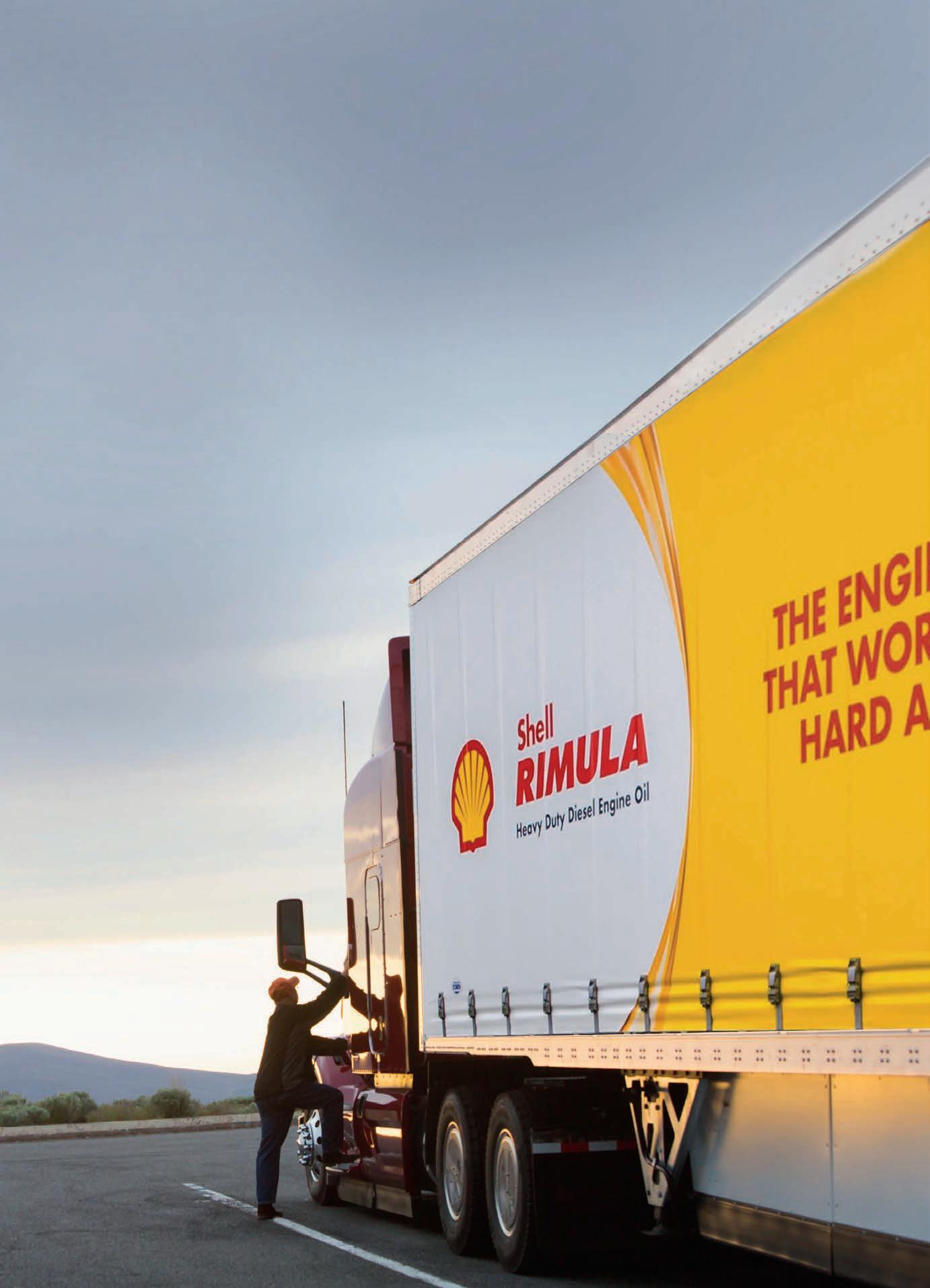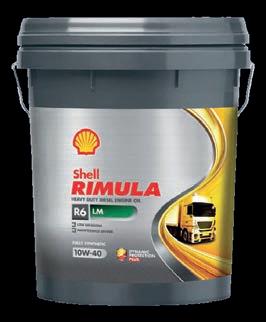Keating Freight Lines Country Feedback

INDUSTRY
Carrier: McArdle Freight Feature: Campbell’s
INNOVATION
Fleet: Korkeaniemi Brothers Transport
Spotlight: Mairead Hayes
Showcase: Alternative Fuels & Technology
Workshop: Eaton Endurant XD Pro
































































































Carrier: McArdle Freight Feature: Campbell’s
INNOVATION
Fleet: Korkeaniemi Brothers Transport
Spotlight: Mairead Hayes
Showcase: Alternative Fuels & Technology
Workshop: Eaton Endurant XD Pro






























































































Australia’s leading truck magazine, Prime Mover, continues to invest more in its products and showcases a deep pool of editorial talent with a unique mix of experience and knowledge.
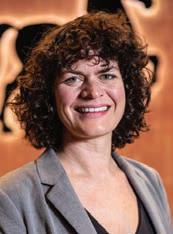





Christine Clancy | COO
With more than two decades of experience as a media professional, Christine has worked in newsrooms across Canada, Vietnam and Australia. She joined the Prime Creative Media team 12 years ago, and today oversees more than 43 titles, including a dozen print and digital transportation titles. She continues to lead a team that focuses on continuous improvement to deliver quality insights that helps the commercial road transport industry grow.
William Craske | Editor
Over the past two decades William has published widely on transport, logistics, politics, agriculture, cinema, music and sports
He has held senior positions in marketing and publicity for multinational businesses in the entertainment industry and is the author of two plays and a book on Australian lm history. Like many based in Melbourne he is in a prolonged transition of either returning or leaving.
Peter Shields | Senior Feature Writer
A seasoned transport industry professional, Peter has spent more than a decade in the media industry. Starting out as a heavy vehicle mechanic, he managed a fuel tanker eet and held a range of senior marketing and management positions in the oil and chemicals industry before becoming a nationally acclaimed transport journalist.
Louise Surette | Journalist
Louise joins Prime Mover after nearly 25 years as a writer. Starting her career as a reporter at the Toronto Star, she has spent much of the last 15 years as a design writer and editor. In 2020, she was shortlisted on the Richell Emerging Writers Prize list. Originally from Nova Scotia, she lives in Melbourne with her two children.

CEO John Murphy john.murphy@primecreative.com.au
Editor William Craske
william.craske@primecreative.com.au
Managing Editor, Luke Applebee
Transport Group luke.applebee@primecreative.com.au
Senior Feature Peter Shields Writer peter.shields@primecreative.com.au
Business Ashley Blachford Development ashley.blachford@primecreative.com.au Manager 0425 699 819
Art Director Blake Storey blake.storey@primecreative.com.au
Design Kerry Pert , Louis Romero, Tom Anderson
Journalists Peter White peter.white@primecreative.com.au
Louise Surette louise.surette@primecreative.com.au
Design Production Michelle Weston Manager michelle.weston@primecreative.com.au
Client Success Salma Kennedy Manager salma.kennedy@primecreative.com.au
Head Of ce 379 Docklands Drive, Docklands VIC 3008 enquiries@primecreative.com.au
Peter White | Journalist
Peter has completed a Bachelor of Media and Communication (Media Industries) degree at La Trobe University, and he brings a fresh perspective to Prime Mover. He gained valuable experience at Upstart, La Trobe’s newsroom, work that has been supplemented by direct industry experience in a Council placement. Peter has a strong interest in commercial road transport, and in contributing to Prime Mover’s efforts in growing the industry.
Ashley Blachford | Business
Development ManagerHandling placements for Prime Mover magazine, Ashley has a unique perspective on the world of truck building both domestically and internationally. Focused on delivering the best results for advertisers, Ashley works closely with the editorial team to ensure the best integration of brand messaging across both print and digital platforms.
03 9690 8766 subscriptions@primecreative.com.au
Prime Mover magazine is available by subscription from the publisher. The right of refusal is reserved by the publisher.
Annual rates: AUS $110.00 (inc GST).
For overseas subscriptions, airmail postage should be added to the subscription rate.
Articles
All articles submitted for publication become the property of the publisher. The Editor reserves the right to adjust any article to conform with the magazine format.
Copyright
PRIME MOVER magazine is owned and published by Prime Creative Media.
All material in PRIME MOVER magazine is copyright and no part may be reproduced or copied in any form or by any means (graphic, electronic or mechanical including information and retrieval systems) without written permission of the publisher.
The Editor welcomes contributions but reserves the right to accept or reject any material.
While every effort has been made to ensure the accuracy of information
Prime Creative Media will not accept responsibility for errors or omissions or for any consequences arising from reliance on information published. The opinions expressed in PRIME MOVER magazine are not necessarily the opinions of, or endorsed by the publisher unless otherwise stated.
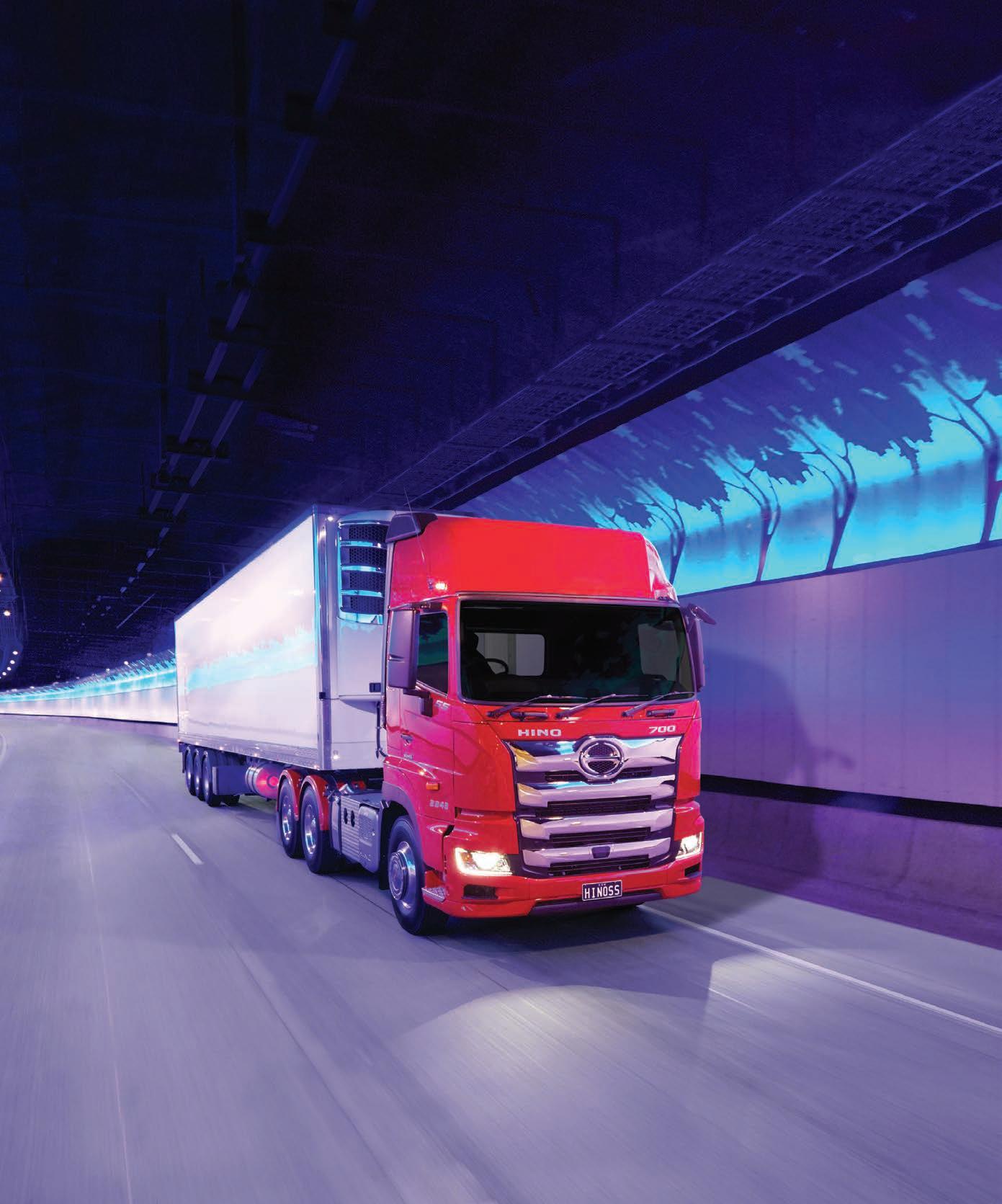
The Hino 700 Series rewrites the rules in safety, emissions and connectivity. It’s our safest truck ever, with an enhanced



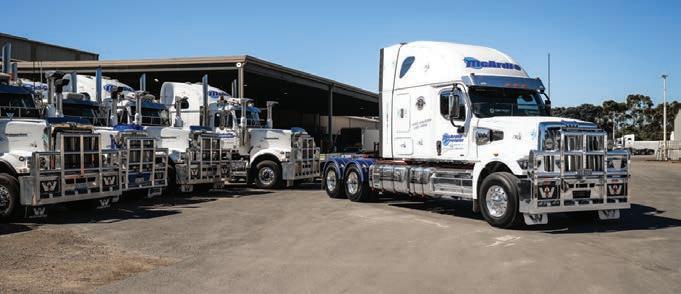
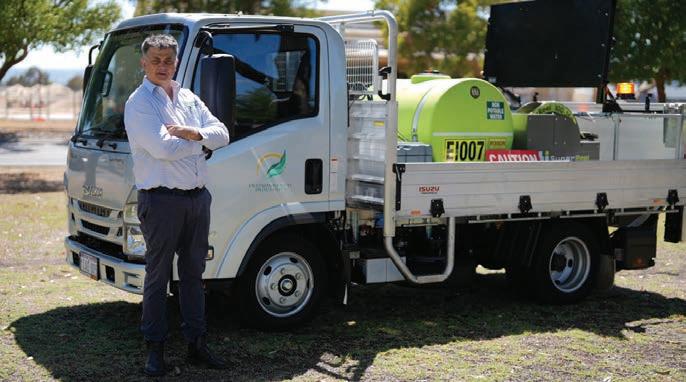
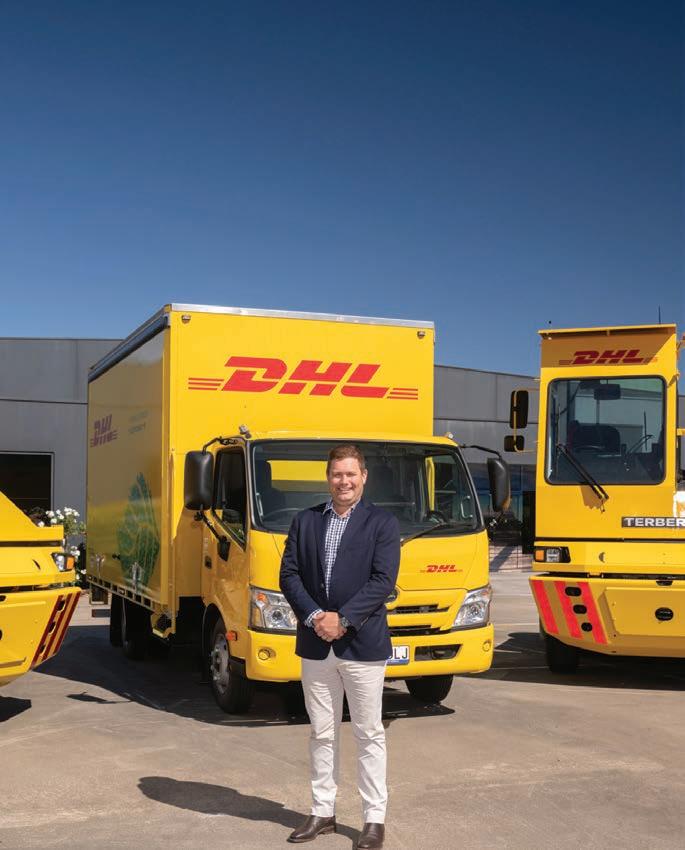
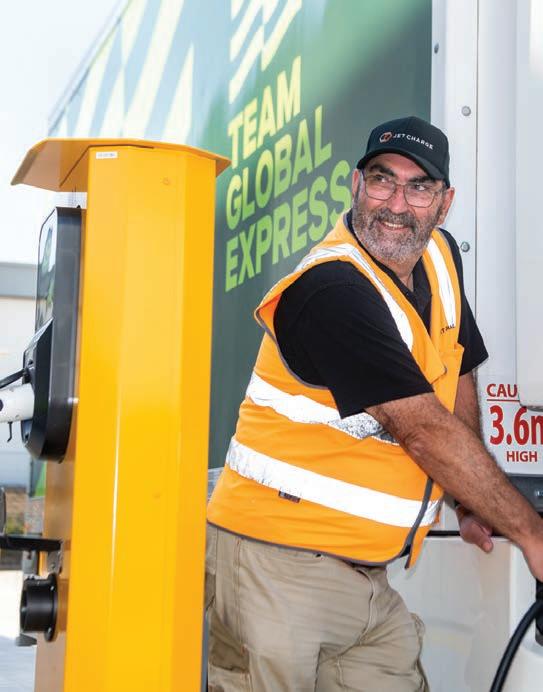
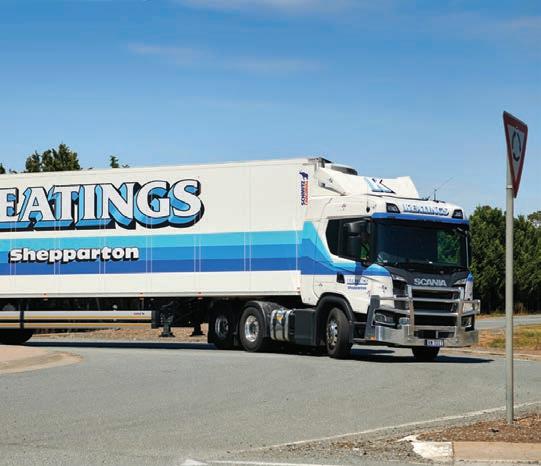

“We very rarely trade in a truck. Some people call us up cold asking if we’ve got a truck for sale. We’ve never had any complaints come back from anyone who has bought one.”




FLEET FOCUS
22 Country Feedback
From its home in Shepparton, intrastate refrigerated transport specialist, Keating Freight Lines, has run a fleet powered by Scania for nearly half a century.
32 Fields of Gold
Inverell is known as the “Sapphire City” because of the gemstones found throughout the district where Campbell’s Fuel Service has been supporting its clients for more than 60 years.
36 Snow Business
’Skandi’ furnishings are currently very much on-trend and this would not be happening without the contribution of skill and expertise of a family of forest workers who operate a fleet of top-spec Volvo trucks in possibly the harshest conditions on the planet.
TRUCK & TECH
40 First Contact
Eaton educator Murray Seymour tours the country enlightening dealerships, customers, mechanics and OEMs on Eaton product including the new automated Endurant XD Pro transmission.
44 Parks and Recreation
Environmental Industries relies on a large fleet that contains 40 Isuzu trucks it deploys on major landscaping projects involving many public spaces across Western Australia.
50 Rising to the Occasion
At a time Viva Energy is set to embark on an exciting new era, Mairead Hayes’ team is driving innovation and efficiencies for their customers, who represent a wide spectrum of transport companies including some of the biggest names in the business.
 William Craske Editor
William Craske Editor
Nothing stimulates old economies like a crisis, and in the volatile commodities markets, spice, despite surging prices, is in renewed demand. Ongoing disruptions in supply chains following the controversial harvest management change on Arrakis, has left rival governments pointing the nger as tensions in the area showed no immediate signs of easing. Accusations levelled at the Harkonnen by Atreides this week reignited a war of words between the rival houses as members of the Padishah executive council tried in vain to de-escalate a situation one insider, who spoke under condition of anonymity, said “regrettably had reached fever pitch”. It follows a recent announcement made by House Atreides that it would undertake a comprehensive audit of the harvesting eet it acquired through a “doomed” succession plan, as some economists have labelled it, decreed by an Emperor who controversially chose not to open the tender to market. Bulk commodity producers condemned the “cartel activity” having claimed they were disadvantaged by the latest instance of bid rigging. The Imperial Court could not be reached for comment.
In a statement, House Atreides took
exception with the negligent maintenance scheduling of its predecessor which it singled out as the cause for accumulative delays as sagging production was further compounded by what it noted should have been “avoidable” downtime. Extensive replacements required across the eet are now on back order for Wormsign Spotters and Harvesting Crawlers, some of which were approaching 15 million working hours. Meanwhile eet management had no bolt-on solution for thousands of outstanding parts, many of which were still awaiting ful llment, after repeated diagnostic errors were reported on hydraulic clamps used to secure the pressurised in atables that were failing on the Carryalls at “an order of magnitude” per one source. Extraction vehicles, in some cases, have been operational with concerning gaps in the refurbishment history that date back to when the Harkonnen began its spice stewardship nearly 80 years ago.
This is not the rst time the Harkonnen global logistics division has been subject to criticism for its questionable operational practices. Its heavily industrialised home planet, Giedi Prime, is often a target of environmentalists for its failures in adhering to ESG compliance. For its own part the Harkonnen returned re claiming it was not encumbered by contractual obligations to sustain continuity of production and that all future R&M commitments were the responsibility of the current account holder whose lack of due diligence on the task, furthermore, failed to repudiate longstanding allegations made of [Atreides] that it “lacked for self-governance”. Many in the Spacing Guild, who have the monopoly interest in interstellar travel, would appear to agree as it hiked prices again this week for offworld haulage pointing to in ationary pressures. The blame it put squarely at the feet of House Atreides whose languishing returns and growing chorus of detractors
had proven enough for some stakeholders who have nally run out of patience for the much-hyped joint venture with the Bene Gesserit Order. As the sole spice mining operation on Arrakis, House Atriedes is learning rst-hand of the vast operational challenges inherent on the remote planet. The extreme conditions are merciless on equipment in addition to the presence of the indigenous Fremen, whose troubled co-existence with foreign resource interests continues to plague production. At a minimum, Atreides will need to overhaul its disaster response plan in lieu of recent sandstorms and worm events. Fleet renewal and the signi cant investments necessary to reboot spice production will be redistributed from other parts of the business at the risk of weakening its operational synergies. Protective security services including cyber governance systems are already reportedly suffering from underfunding. Though spice melange is still considered the key mineral used to fuel interstellar transport, the scarcity mindset informing the foreign policy of many governments has as much to do with the inability to adequately store, stage, and blend it. Untreated, spice has a limited shelf life. Before it was appointed to replace the Harkonnen as the sole mining interest on Arrakis, House Atreides, given its growing military presence, should have been, according to critics of the transition rst proposed by the Herald of the Change, subject to hefty trade tariffs, a move the Emperor was unwilling to make despite increasing public pressure. Rising operational costs for the logistics, transportation and feeding of the the imperial private army, according to one insider, remains a major drain on the treasury without a war to justify its disproportionate budget.

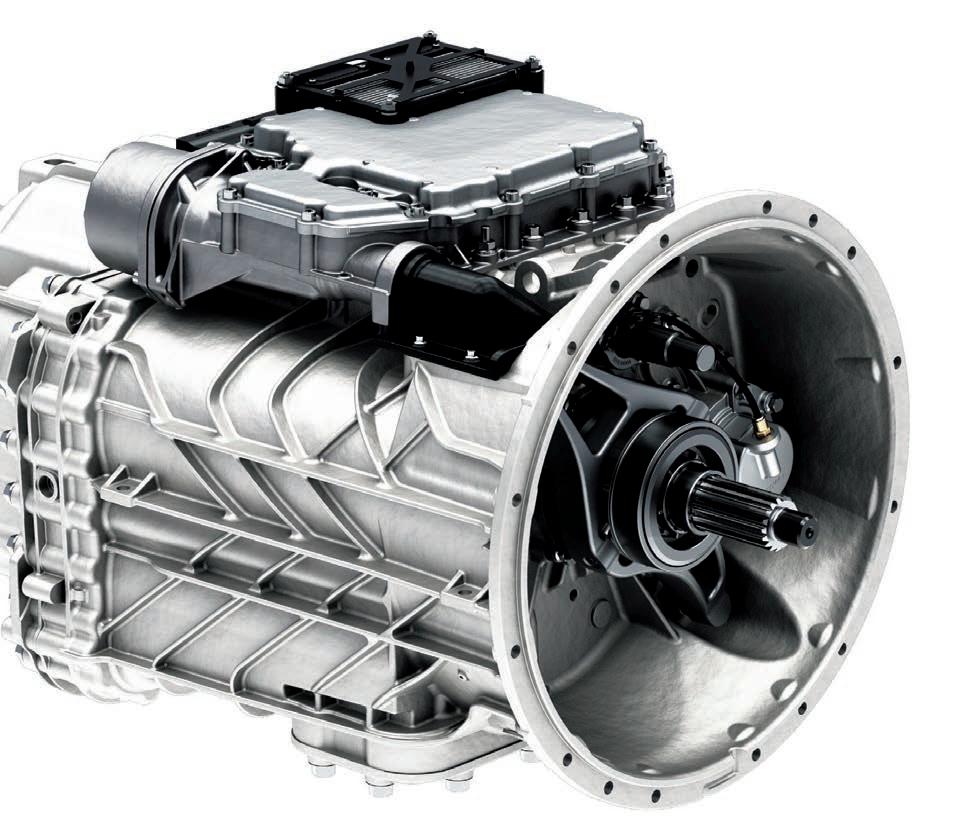



With driver shortages and increasing supply demands industry-wide, Ron Finemore Transport founder, Ron Finemore, says something needs to change. Ron Finemore Transport is renowned for its safety protocols, new equipment, and for its peak condition late model fleet. However, despite utilising the latest equipment and operating with the safest protocols, Finemore told Prime Mover that the fleet, like the entire industry, is feeling the effects of driver shortages.
“We’ve got a shortage of drivers and an increasing market without enough people to do the work,” he said. “Our company is 100 drivers short, and everybody is short.”
Finemore said the issue comes down to the fact that existing Australian drivers, especially younger ones, are restricted from getting a license.
“Young drivers can’t become a truck driver until they’ve failed somewhere else, because they can’t get a license when they leave school,” he said. “So, they’ve got to go and work somewhere else and then fail there or get sick of it and come back to be a truck driver.”
According to Finemore, the current licensing rules for truck drivers sees age as well as time required holding each license being barriers. In this area, he believes licensing should be based on a driver’s competency.
“We’ve got to make it easier for young people to become a truck driver,”
Finemore said. “If they have the required level of competency, and if they’re working for reputable companies that are responsible for them, they should be able to hold a license restricted to that company that is accountable for them.”
The other problem lies with making heavy line haulage an essential service and gaining access to drivers from overseas.
“You can’t bring people legally into Australia to drive trucks as migrants,” Finemore said. “Under the current visa system, a truck driver is not a skilled occupation. We’ve been trying to get it added to the skilled occupation list unsuccessfully for 20 years.”
While many prime mover OEMs look to move towards autonomous transport solutions such as self-driving trucks to combat these issues, Finemore explains other aspects of the job, such as loading and unloading trucks, are left unresolved. “Somebody’s got to load them, unload them and secure the load,” he said. “Somebody has to do the work at both ends. That’s the issue.”
Finemore is calling on governments to make the changes necessary to “allow the people that want to work in the industry to work in it safely”. In December last year, the Australian Government welcomed transport ministers’ inprinciple agreement to an improved, nationally-consistent approach to the training and licence progression of heavy vehicle drivers. The National Heavy
Silk Contract Logistics has officially opened its new transport facility in Western Australia. The Kenwick site, located five kilometres from Perth’s International and Domestic Airport and 15 minutes inland east of Fremantle Port, sits on an area site of 43,509m². It has direct rail access, some 5000m² container hardstand for stacking boxes up to five high and 16 refrigerated container charging stations. A super awning and extended canopy features
two 86 metre drive-in lanes for loading/ unloading of vehicles without the need to reverse.
“Thanks to the collective efforts and the unwavering support from Silk’s national and local teams, we’re thrilled to announce that we’ve not only completed the project ahead of schedule but also under budget and with valued customers ready to commence,” the company said in a statement.
The 23,615m² warehouse has provision
Vehicle Driver Competency Framework Decision Regulation Impact Statement (Decision RIS) proposed a series of reforms to improve road safety and productivity.
The Government claimed these changes would strengthen heavy vehicle driver skills and knowledge through redesigned learning and assessment requirements specific to each license class. At the time, it was announced that minimum course lengths and behind-the-wheel time would also be made compulsory, while some training and assessment will be delivered online to lower costs and allow license applicants more flexibility. In addition, it was reported that new experience-based license-progression pathways would be introduced to help drivers progress to higher license classes more quickly. Despite this, Finemore said the specific details on these proposals haven’t been released and the timeframe of their arrival is uncertain.
“They’re talking about it happening over a number of years,” he said. “I probably won’t live long enough. Each of the states have their say, so you end up with the lowest common denominator of things happening because we don’t have national regulation.
“You end up with very minimal change in the time it’s going to take to happen. It’s not happening, and that’s the problem. It needs to happen not in a few year’s time, it needs to happen now,” said Finemore.
for 33,000 racked pallet spaces, eight container docks and incorporates four site office facilities including port, distribution, contract logistics and Western Australia operating headquarters.
The Kenwick facility is designed to a 6 Green Star rating. At present there is only 12 of these facilities in Australia. The material handling fleet will be powered by Lithium-Ion batteries charged by a solar panels system.
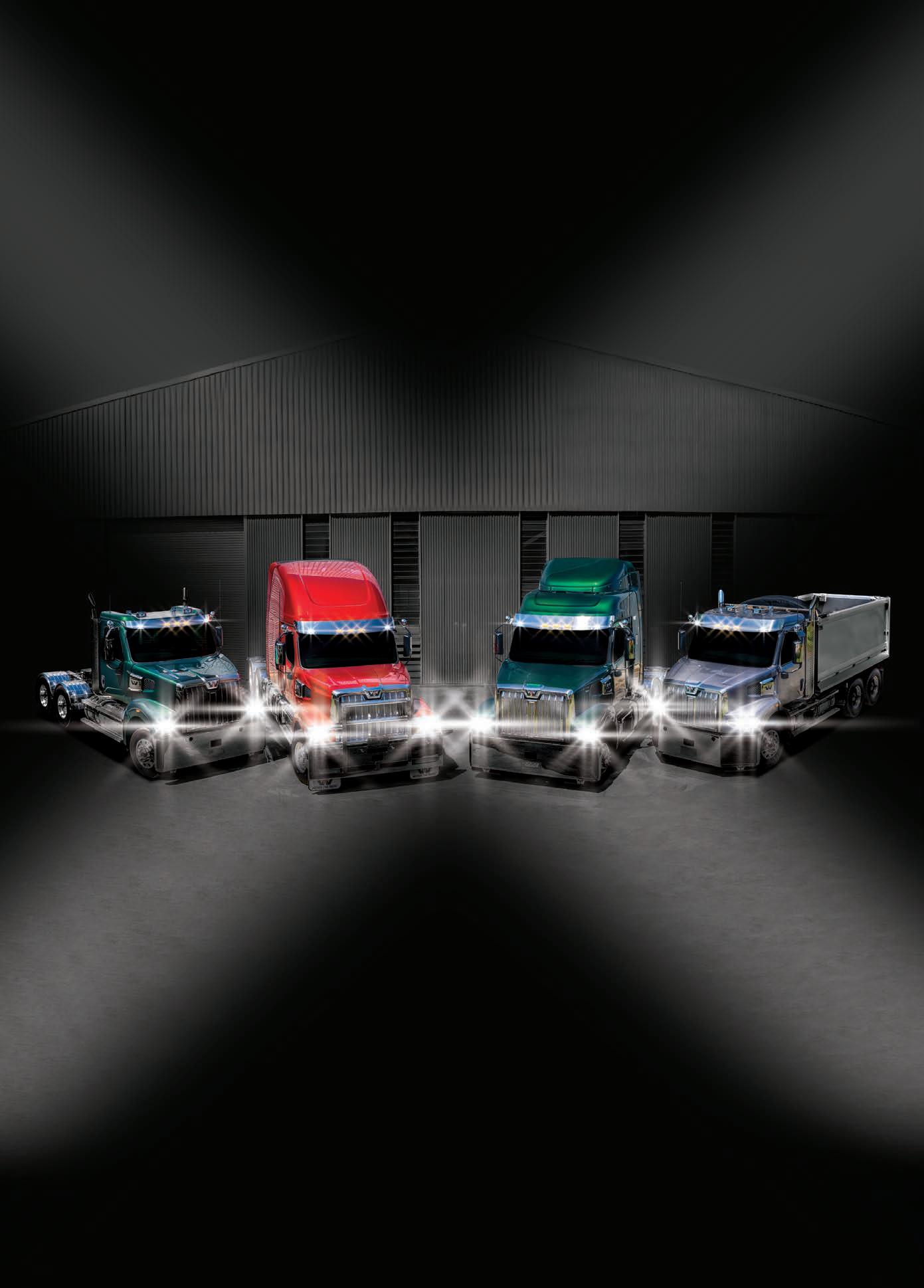
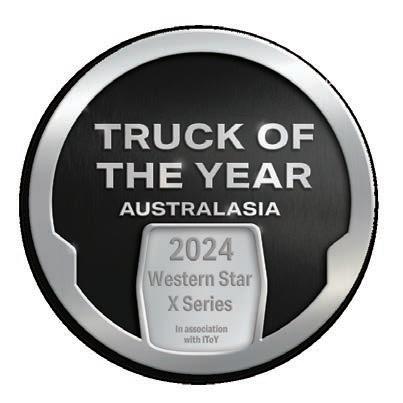

























Linehaul specialist, Brims Transport, has taken delivery of eight new prime movers. The major order will see the independent carrier introduce six new Kenworths and two new Euro 6 DAF trucks. Headquartered at Chinderah in New South Wales, less than 10 kilometres south of the Tweed River, Brims Transport runs general freight predominantly along the east coast of Australia. Three new Kenworth T610SARs along with three Kenworth K200s have joined the fleet as part of a strategic refresh undertaken by the family business now in its 21st year. The majority of operations are devoted to B-double interstate work to Sydney, Melbourne and Adelaide, augmented by local metro distribution centre shuttles on the Gold Coast.
The company is a 24/7 operation with 25 trucks — prime movers all. General Manager Jason Brims took over operations in 2019 following the passing of the founder, his grandfather Ross Brims.
“We were getting over the older trucks in the fleet and it was a good time for us to bring in some new vehicles,” he tole Prime Mover
Brown and Hurley Kyogle facilitated the deliveries which include two new Euro 6 DAF CF530s. These vehicles will

run on shuttles between DCs up to 16 hours a day should they be utilised on a split shift.
“I like them a lot. We introduced the first CF530 six months ago and followed that up with one in the new year with the third delivered this week,” Brims said. “They’re well suited for local work. Some of the sites we go to are a bit tight for bonneted B-doubles and these are smoother, comfy and they roar into the job and come out as required.”
These are not the first Euro 6 DAFs in the fleet. The fleet had a short-lived truck and dog combination but it unfortunately was lost it in the Northern NSW floods
Toll Group has announced the construction of a new, 10,000m2 state-of-the-art healthcare facility at Tullamarine, near Melbourne. Toll is a leading supply chain partner to CSL Seqirus, and the facility is being custom built to support CSL Seqirus’ operations. The warehouse and distribution centre will be situated next to the future CSL Seqirus manufacturing site, bolstering Toll’s tailored support for CSL Seqirus by handling both finished goods distribution and supplying raw materials and packaging to the CSL Seqirus manufacturing facility.
Toll’s facility will be situated adjacent
to the soon-to-be-completed CSL Seqirus plant, a new world-class biotech manufacturing facility in Australia which will supply influenza vaccines to Australia and the rest of the world. The state-ofthe-art facility will use innovative cellbased technology to produce influenza vaccines for use in both influenza pandemics and seasonal vaccination programs – and will be the only cellbased influenza vaccine manufacturing facility in the Southern Hemisphere.
Toll’s warehouse and distribution centre is due to commence operations in August 2024. The new warehouse marks Toll’s commitment to providing
of March 2022. That truck was only six weeks old. “We didn’t get to the first service on that first DAF,” recalled Brims. Meanwhile, the K200s are powered by a 550hp X15 engine with 2050lb/ft of torque riding on Meritor running gear.
“We’ve gone for the 2.8-metre big cabs on these for the driver’s comfort,” he said. The Kenworth T610SAR, however, is a change for some of the drivers who would like the option of operating a bonneted American truck.
“The T610SAR looks bloody awesome and that’s half the reason I got it,” said Brims. “Everyone who has driven one absolutely loves them.”
comprehensive logistics solutions for the healthcare sector. With operations commencing in Tullamarine, Toll aims to enhance efficiency and timeliness through just-in-time services.
“This new facility exemplifies our commitment to delivering high-quality, tailored supply chain solutions to meet the evolving needs of our customers,” said Perry Singh, President, Government & Defence at Toll. In addition to the Tullamarine facility, in April 2023 Toll opened a new warehouse in Richlands, Queensland, further demonstrating its dedication to enhancing healthcare logistics infrastructure across Australia.


Axle-Forward configuration for heavier payloads

Built in Australia for tough Australian conditions

Ground has been broken in Hope Valley by Scania Australia ahead of the construction of its 10th companyowned workshop and new warehouse. The new sales and service outlet aims to be open for business in 2025, capitalising on the increasing sales of Scania trucks, buses, and marine and industrial engines in Western Australia. Last year, Scania set a new benchmark for the brand having sold 1383 vehicles. Manfred Streit, Scania Australia Managing Director was present yesterday to turn the first sod at what will become Scania Hope Valley. “We continue to grow our business in Western Australia. We saw the need for additional company-owned sales and service capacity, as well as access to parts, to support customer uptime,” he said. “The location of the new Hope Valley facility brings us closer to customers in the fast-growing southern
Perth metropolitan area.”
In addition to a new sales and service facility, Hope Valley will be the site of an enlarged regional parts warehouse of 3500m² that will service the needs of Scania customers in the West, including key mining customers located throughout the state and in the busy Pilbara region.
The workshop and parts warehouse are well situated on a spacious and prominent 19,000m² block in a new industrial precinct, close by major road routes for easy access, especially by larger combinations, along with a purpose-built pit that is designed to accept WA-style long vehicles without decoupling.
Large crossovers and hardstands will provide ease of access for vehicles up to 36.5 metres long.
Also included in the facility design is a purpose-built office environment
with dedicated customer areas and impressive space and amenities for the on-site Scania team.


Hope Valley will be Scania Australia’s first true EV-ready facility, with infrastructure in place to handle today’s BEV charging needs and future capacity for high volume vehicle charging. The design of the facility has been undertaken with a focus on sustainability, with particular attention paid to how the site will handle waste across both the warehouse and workshop facilities.
“Our business development trajectory requires us to ramp up our capacity to service our growing fleet of customer vehicles as well as to prepare for the transition to battery electric and alternative fuel vehicles, which will undoubtedly arrive sooner than people think,” said Scania Dealer Director for WA, SA and NT, Michael Berti.
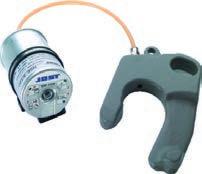




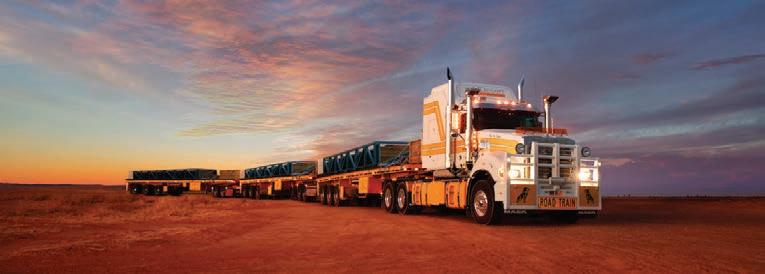
Oil and gas services business, Wild Desert, relies on the Mack Titan platform for its remote outback work. In addition to servicing some of the wells for the five biggest oil and gas companies in Australia, Wild Desert provides transport services and supplies entire camps delivered, set up, stocked and fullystaffed. On short notice they can be asked to pull a camp down, move it a few hundred kilometres, and then set it up again, often in the same day. Based out of Roma in central Queensland, Wild Desert has specialised since 2005 in servicing well sites and providing all the facilities and supplies needed to keep
them in operation. Wild Desert Managing Director David Whiley said that after nearly 20 years the company is more in demand than ever.
“Back in 2005 we saw the opportunity, so we sold a few houses and bought a truck,” he said. “Since then we’ve just been getting busier every year.”
The company’s truck fleet now numbers more than 50 units. Over half of these Mack Titans with another two on order. They transport all manner of equipment and supplies to destinations as far apart as Moomba in South Australia, and the Carnarvon Ranges in Queensland.
“Our trucks are mostly running as AB-
triple or triple roadtrains,” explained Whiley. “Depending on what they’re carrying and where they’re going, they might do anything from 500 to 3,500 kilometres in a trip.”
One of the company’s advantages and why its customer relations remain so strong is that it remains a single-source provider.
“We bring in all our own fuel and parts from Brisbane, and we supply all our own food out of Roma. The only thing we don’t do is fly in the staff – we know our limitations,” said Whiley.
Back in 2006 Whiley purchased a 1998-model Mack Titan and soon realised he’d found the truck he was after. There is history: his father drove Flintstones and R600s.
“The Titan is ideal for what we do. They don’t just look tough, they are tough, they hold up well and we’ve kept ours going for years through multiple rebuilds,” he said. That first Titan is still going strong after 18 years, which is a testament to both the strength of the Mack and the care Whiley takes with his trucks.
The National Heavy Vehicle Regulator (NHVR) has worked with Main Roads Western Australia and the Department for Infrastructure and Transport South Australia, to publish two emergency notices after recent flooding forced the closure of a key rail network.
NHVR Chief Operations Officer Paul Salvati said the notices give consent to increased access for roadtrains up to 53.5 metres, between Port Augusta in South Australia and the Western Australia border, and then internally into WA.
“We have seen massive amounts of rain fall on the WA outback, inundating roads and damaging key networks, and our thoughts are with anyone who has been affected,” Salvati said. “The flooding in the Eyre Highway area has caused damage to the rail network, forcing it closed.
“In light of this, the NHVR has partnered with WA and SA state transport authorities to deliver this urgent emergency notice.”
Salvati said the notice would provide heavy vehicle drivers and operators with increased flexibility and expedited access to critical routes, facilitating the efficient transport of essential supplies and emergency relief for communities cut off by flooding.
“Truckies have had to take huge detours to reach their destination due to this flooding, and the NHVR recognises the importance of delivering essential items to the affected communities,” he said.
“However, we are also urging drivers to exercise caution when travelling through these conditions, prioritising safety above all else.
“Due to the heightened risk and uncertainty, the NHVR will be
proactively patrolling the region to ensure all heavy vehicle drivers are travelling safely.
“We anticipate more trucks on the road during this time, and with the road conditions unpredictable, the NHVR’s priority is safe, efficient heavy vehicle movements.
“The last thing we want to see is overloaded or unsafe truck operations, with compliance paramount during this time,” Salvati continued. “For any driver navigating these challenging conditions, be prepared by taking any necessary precautions, equip yourself and your vehicle appropriately, and always prioritise safe driving practices to ensure a safe and secure journey.
“Operators should carefully brief any drivers who are new to the route, including on the location of rest areas and fuel stops.”
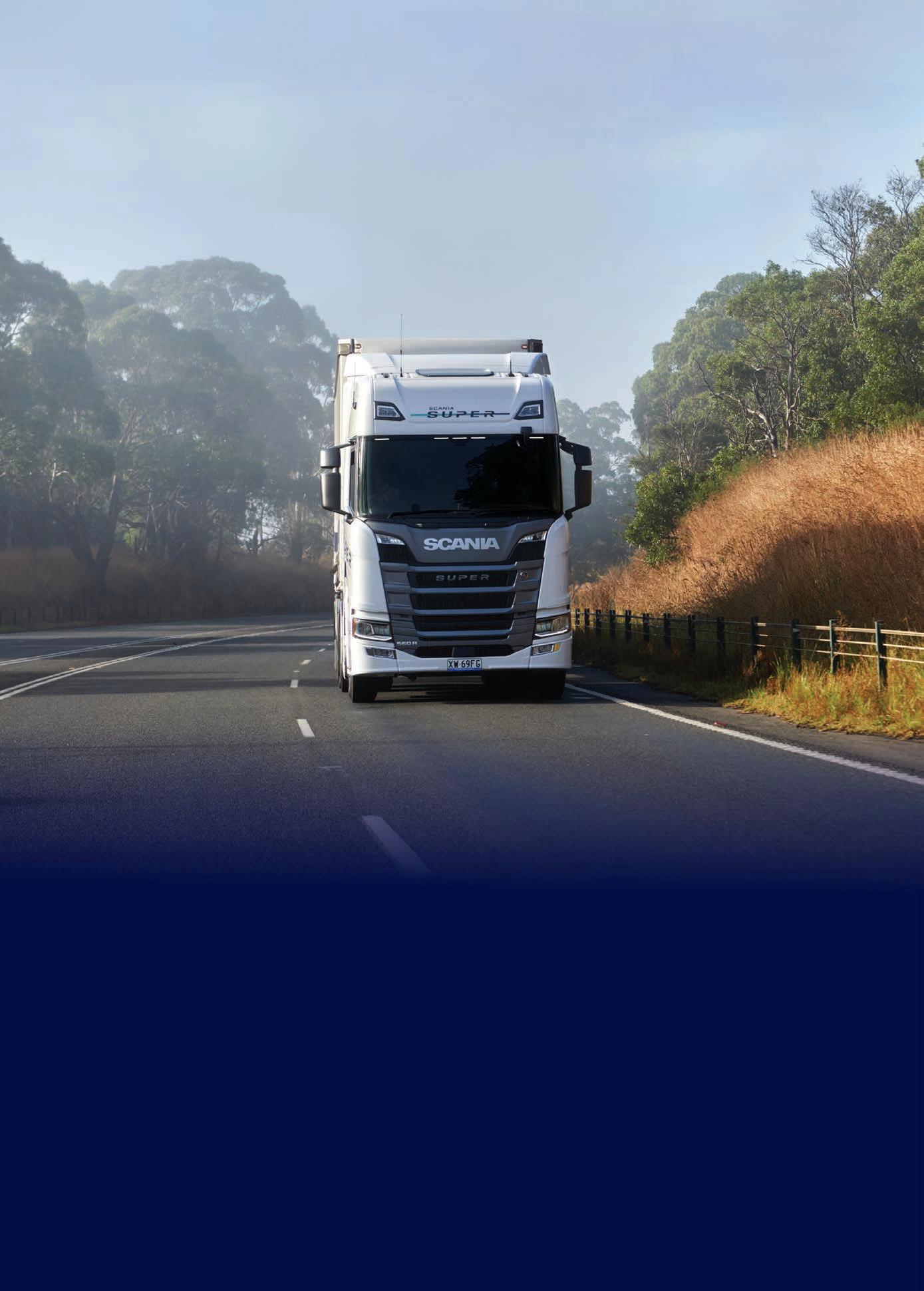



The first Volvo FH Electric sold in Australia has been delivered to Followmont Transport. The prime mover will be tasked with shuttling trailers between Followmont’s Eagle Farm depot, servicing major accounts around Brisbane and running overnight linehaul to the company’s Toowoomba and Sunshine Coast depots.
“We are thrilled to integrate electric trucks into our fleet, advancing our sustainability objectives and pioneering greener logistics solutions and are excited to receive the news that our road network is expanding to make the adoption of EV trucks easier,” said Followmont Transport Managing Director, Mark Tobin.
The delivery coincides with the announcement of a zero-emissions road network for Southeast Queensland which will increase steer axle mass allowances to eight tonnes on the steer axle and 18.5 tonnes on the drive axles for battery electric

heavy vehicles — a vital step to enable the roll out of heavy battery electric vehicle (BEV) transport.
Followmont’s 540kWh, 666hp FH Electric is currently rated to 44 tonnes and has a range of up to 300 kilometres on a single charge. A 60kW charger has also been installed on site at Followmont’s head office for
overnight charging, with plans to install charging solutions further afield as the company seeks to increase reach and range. Followmont has also signaled its intention to invest in electric vehicle competencies for staff to provide in-house expertise for emerging technology.
Red Hawk Mining has announced that it has entered into a strategic partnership with MGM Bulk. The agreement covers the haulage of iron ore from the Red Hawk’s 100 per centowned Blacksmith Iron Ore Project to the Utah Point Bulk Handling Facility in Port Hedland.
The haulage agreement enables Red Hawk and MGM Bulk to work collaboratively through the PreFeasibility Study and Definitive Feasibility Study phases to develop and optimise the transport and logistics strategy, focusing on maximising productivity and reducing unit operating costs.
Following completion of the studies, MGM Bulk has the exclusive right to enter into a Haulage Services Agreement on terms equivalent to those contained in the Definitive Feasibility Study.
MGM Bulk will be responsible for
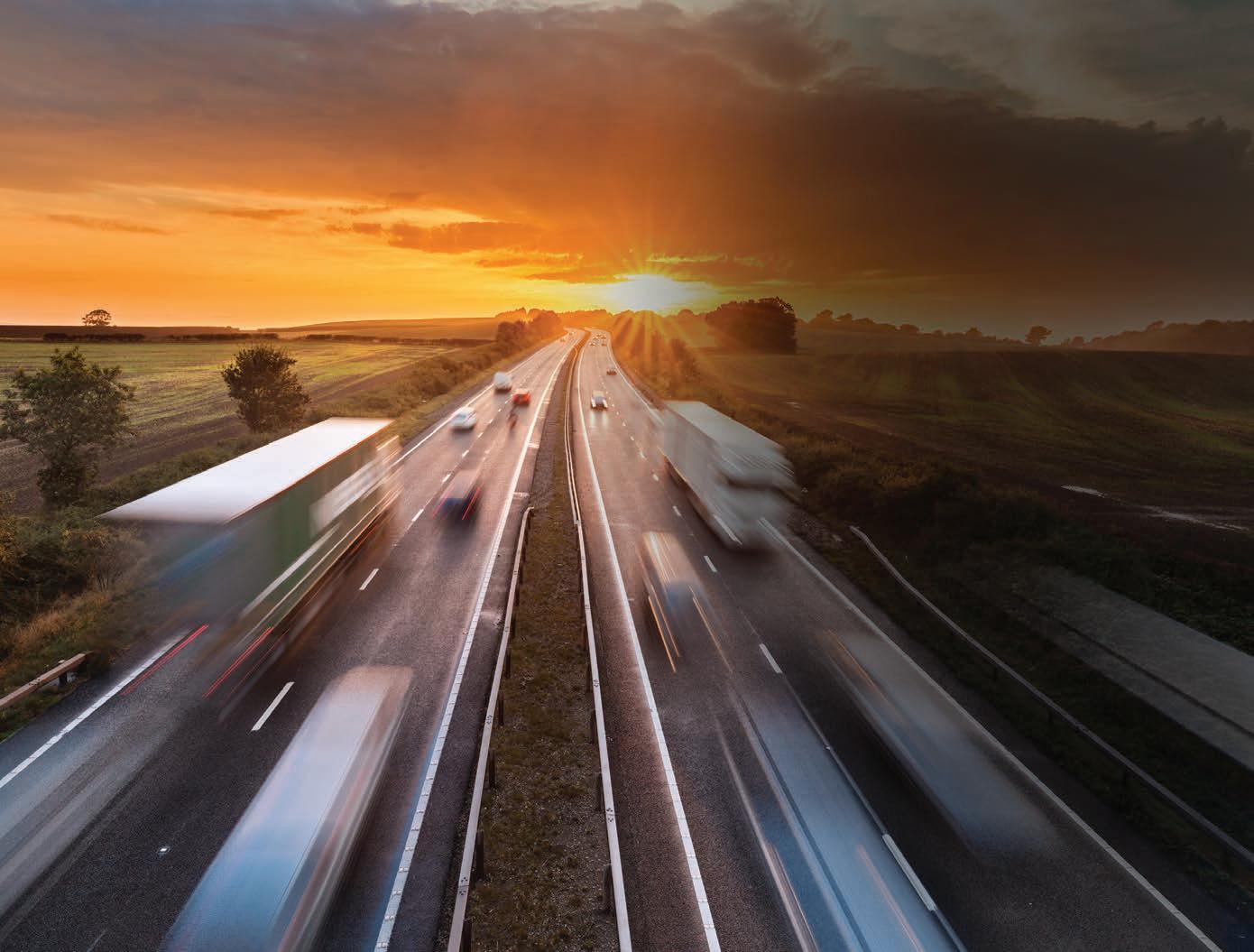
providing a fleet of 150-tonnerated ultra-quad trucks and drivers plus associated loading and other equipment and infrastructure.
Red Hawk Managing Director, Steven Michael said the company is excited to work with the team at MGM Bulk to establish a haulage strategy optimised for the Blacksmith Project.
“MGM Bulk’s operations in the Pilbara, centred around delivering iron ore into the Utah Point, are second to none,” he said in a statement.
“Their fleet size, quality, operational performance and safety record are critical factors in ensuring the success of the Blacksmith Project. Our PFS team is working closely with MGM Bulk’s commercial and operations team to deliver operating and capital cost estimates with a high degree of certainty, which can easily be translated into an operational haulage contract.”
MGM Bulk, a cornerstone of MGM Group backed by the Giacci Family, continues to set benchmarks in the transport and logistics sector through sustained innovation and a track record of safety and success.
Since its commencement in 2014, MGM Bulk has exhibited swift growth, underpinned by an unwavering dedication to excellence, safety, and customer satisfaction.
With an extensive fleet exceeding 170 prime movers strategically located across five locations in Western Australia, MGM Bulk efficiently manages the transport of more than 15 million tonnes while travelling over 41 million kilometres annually.
“We are immensely proud to be forging a long-term partnership with Red Hawk Mining on the mine-to-port haulage solutions for their Blacksmith Iron Ore Project,” said MGM Bulk CEO, Michael Giacci.










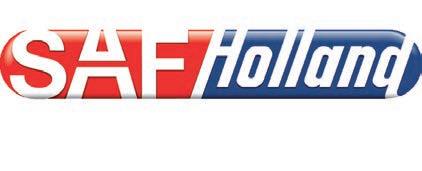
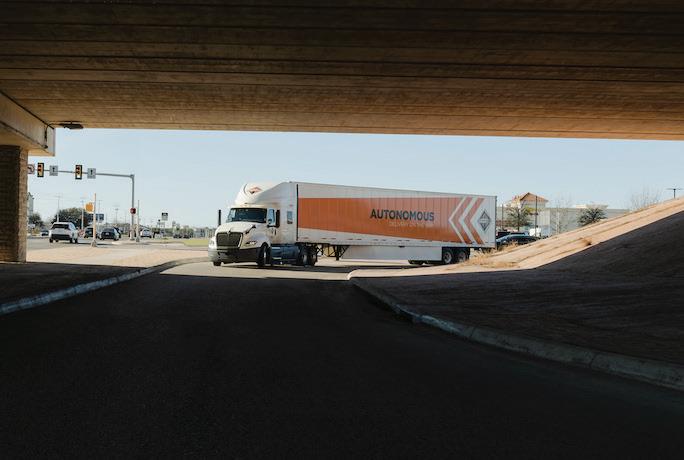
TRATON Group member Navistar is making progress in autonomous driving technology in preparation for the launch of an autonomous commercial pilot program with customers in Texas. Navistar is involved in a new partnership with Plus to integrate its Level 4 autonomous SuperDrive technology stack into International vehicles and other branded vehicles within the TRATON Group including Scania. The high volume and scalability of hub-to-hub operations presents an
immediate addressable market of 25 billion miles of long-distance freight on the US interstate system according to Navistar. The company has strategically selected hub-to-hub operations as the company’s core segment for commercial viability of autonomous implementation. International trucks equipped with SuperDrive by Plus are being validated with a safety driver on routes in the Lone Star state. Customer pilots are expected within the year, with commercial deployments expanding incrementally along strategic US corridors.
“Global partnership with a company like Plus allows us to leverage the technical strides they have made as we work together to focus on the commercial viability of Level 4 autonomous driving,” said Tobias Glitterstam, Chief Strategy and Transformation officer, Navistar. As part of TRATON Group, Scania will also be involved in a new partnership with Plus. Scania’s program launch
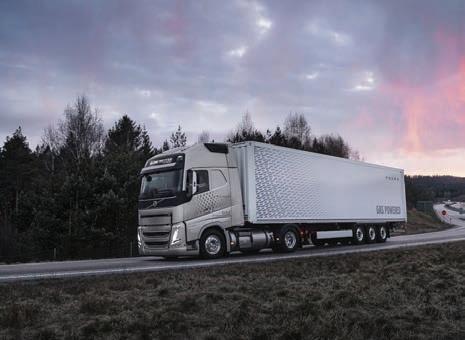
The Volvo Group has signed an agreement with Westport Fuel Systems on an injection fuel system technology. Westport’s High Pressure Direct Injection fuel system technology, designed specifically for alternative fuels, is suited for long haul and off-road applications.
The closing of the joint venture is subject to certain closing conditions, including regulatory and government approvals.
Signed in part to accelerate what is described as the commercialisation and global adoption of High Pressure Direct Injection fuel system technology, it is anticipated that the JV will become operational following the formal closing which is expected in the second quarter of 2024.
High Pressure Direct Injection is a fuel system technology which can be applied in vehicles with internal combustion engines to replace greenhouse gasemitting fuels, like diesel, with carbonneutral or zero-carbon fuels like biogas or hydrogen.
“Decarbonisation with internal combustion engines running on renewable fuels, especially with High Pressure Direct Injection, plays an important part in sustainable solutions,” said Lars Stenqvist, Chief Technology Officer Volvo Group.
“HPDI has been on the road in Volvo
comes as customers look for trusted and reliable partners for developing and deploying autonomous vehicles. This new solution from Plus stands out due to its adaptability to customers’ specific routes and transport profiles.
“We are committed to developing fully integrated autonomous solutions. This means technology that is fitted and supported directly from the factory and a solution that is designed to be operated by our customers in their existing infrastructure and operational flows,” said Peter Hafmar, Scania VicePresident and Head of Autonomous Solutions.
The launch and announcement are the latest stage in autonomous research and development for Scania. The company, which has already been testing autonomous transport solutions on Swedish roads since 2021, has plans to expand pilot operations with customers in other European countries during 2024.






trucks for over five years and is a proven technology that allows customers to significantly reduce CO2 emissions in LBG (Liquified Biogas) applications here and now and is a potential avenue for hydrogen.”
Westport will contribute certain HPDI assets and opportunities, including related fixed assets, intellectual property, and business, into the joint venture.
Volvo Group will acquire a 45 per cent interest in the joint venture for the sum of approximately USD$28 million, payable upon closing, plus up to an additional USD$45 million depending on the performance of the joint venture. Headquartered in Vancouver, Canada, Westport serves customers in more than 70 countries as a supplier of advanced fuel delivery components and systems for clean, low-carbon fuels such as natural gas, renewable natural gas, propane, and hydrogen.












































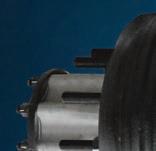



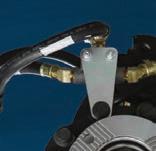

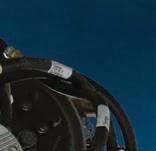






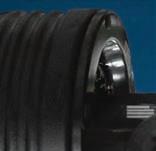
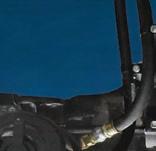





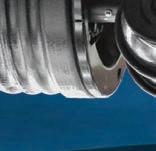

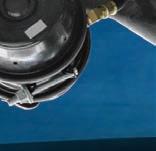

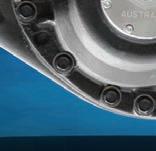

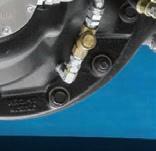

























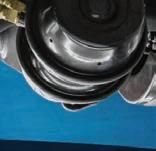









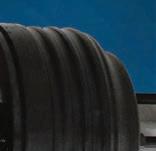






















From its home in Shepparton, intrastate refrigerated transport specialist, Keating Freight Lines, has run a eet powered by Scania for nearly half a century.
Keating Freight Lines, since long before it operated under its own moniker, has steadfastly identi ed the best truck, regardless of its position in the market, for the job. Indeed, its willingness to introduce European cabovers for fuel ef ciency and safety, long before it was in vogue to do so, goes back to its earliest days when Ken Keating, began carting produce from Shepparton to the markets in Sydney with the purchase of a Mercedes-Benz New Generation 1413. That was in 1969. Three years later, while a 50 per cent partner and responsible for the trucking component of the Geoffrey Thompson Fruit Packing business, Ken purchased his rst Scania, an LB80 SUPER. Not one to do things by halves, Ken added three of these trucks to the eet. It must have been one hell of a sales pitch. As it turns out, the promise of a single platform, with the proprietary Scania engine, gearbox, and drivetrain, was tantamount to a one stop shop for Ken, which is exactly what he had been looking for.
“That impressed him,” recalls Mark Keating, company Co-director and son of Ken. “He fell in love with them straight away.”
For the next ten years Ken sampled several Scanias from the OEM’s range of products, running 110s, 111s and eventually a Scania 141 V8. In that brief period, Ken owned 15 Scania units.
In 1982 Ken and his wife Dorothy (decd) founded Keating Freight Lines. Beginning with the lone Scania, not surprisingly the 141 V8, the eet progressed over the years as it introduced and received great value from the likes of the Scania 112, a P92, several 113s, right up until the latest trucks of today which includes four of the new SUPER range — three new Scania SUPER 460s and one SUPER 560. Aside from an Isuzu rigid, there are 21 Scanias in the eet including three G440s, 12 NTG 450s and three P310 rigids, two of which are twin-steer. A Scania R NTG, along with the new SUPER 560, are used to perform B-double work as required.

“Over all the years of our business we’ve had a Scania in the eet at one time or another,” says Mark. “We moved away from the Scania prime movers in the late ‘80s. That’s mainly because they went through a rough trot with management and then they sent people over from Sweden and it all turned around. We’ve certainly never looked back.” Scania’s R&M Contract is one of the chief reasons for the ongoing partnership. In fact, Keating Freight
Lines, was one of the rst customers of the OEM to commit to a Scania Repair & Maintenance support care package, validating the strength of the relationship, especially when considering a national plan is uncommon for a business of its operational size.
“Although we are relatively small given the bigger eets Scania has on these contracts that’s possibly because we’ve been with Scania for so long,”
says Mark, whose older brother Chris, who sadly passed in 2022, he credits as being the driving force behind this arrangement.
“My late brother ran the whole show here and he did a top job. It was upon bringing in the Scania G440s that the R&M arrangement rst began.”

Most times, according to Mark, when the vehicles come off the R&M schedule, they will get extended another 12 months having clocked around 850,000
kilometres. Despite this the company has little trouble in selling them privately.
“We very rarely trade in a truck. Some people call us up cold asking if we’ve got a truck for sale,” explains Mark. “We’ve never had any complaints come back from anyone who has bought one.” Such an endorsement for the eet management at the business can hardly be restated. It’s something Mark says he’s proud of.
As the trucks come off R&M, the workshop, run by Mark’s nephew Ross, who also services the rigids and trailers, comes into play. He represents the third generation working in the family business. His grandfather Ken, meanwhile, turns 88 this year.
“He comes in most days when he’s feeling up to it and to keep an eye on us — he’s good value,” says Mark. “Steve
[Mark’s oldest brother] and I have been relegated from out running the trucks to being directors of the company now with dad.”
Mark, who has recently turned 60, likes to keep one foot in a vehicle, still driving on occasion to meet over ow. That vehicle, customarily, is a 2005 Scania R580 V8 with a manual transmission. The truck has covered over 1.3 million kilometres. Though technically semiretired it’s still registered as a B-double.
“When I go it goes. It’s a good truck,” says Mark. “Dad keeps saying let’s get rid of it and I keep saying no. Why? Because there’s no more manual transmissions from Scania.”
Scania Australia Managing Director Manfred Streit, at an Anglesea customer drive day, last year called it the “golden truck.”
It certainly wasn’t a comment lost
on Mark.
“I enjoy driving it,” he adds. “Not only does it go well, but it also still sounds great.”
The new trucks in the SUPER range, powered by a new 13-litre six-cylinder Euro 6 engine, are a lot quieter in comparison according to Mark. Having said that he admits they are also rumblier on the exhaust brake than many of the other Scanias chie y due to the dual overhead camshafts that are operating four valves per cylinder with a single piece cylinder head. No engine brake is needed because the engine retarder, optimised to deliver up to 350kW force, is more than adequate. The SUPERs are already reporting edifying fuel gures. While the older NTGs run at about 2.8 kilometres per litre, the new SUPERS, are consistently achieving 3.3 on the corresponding
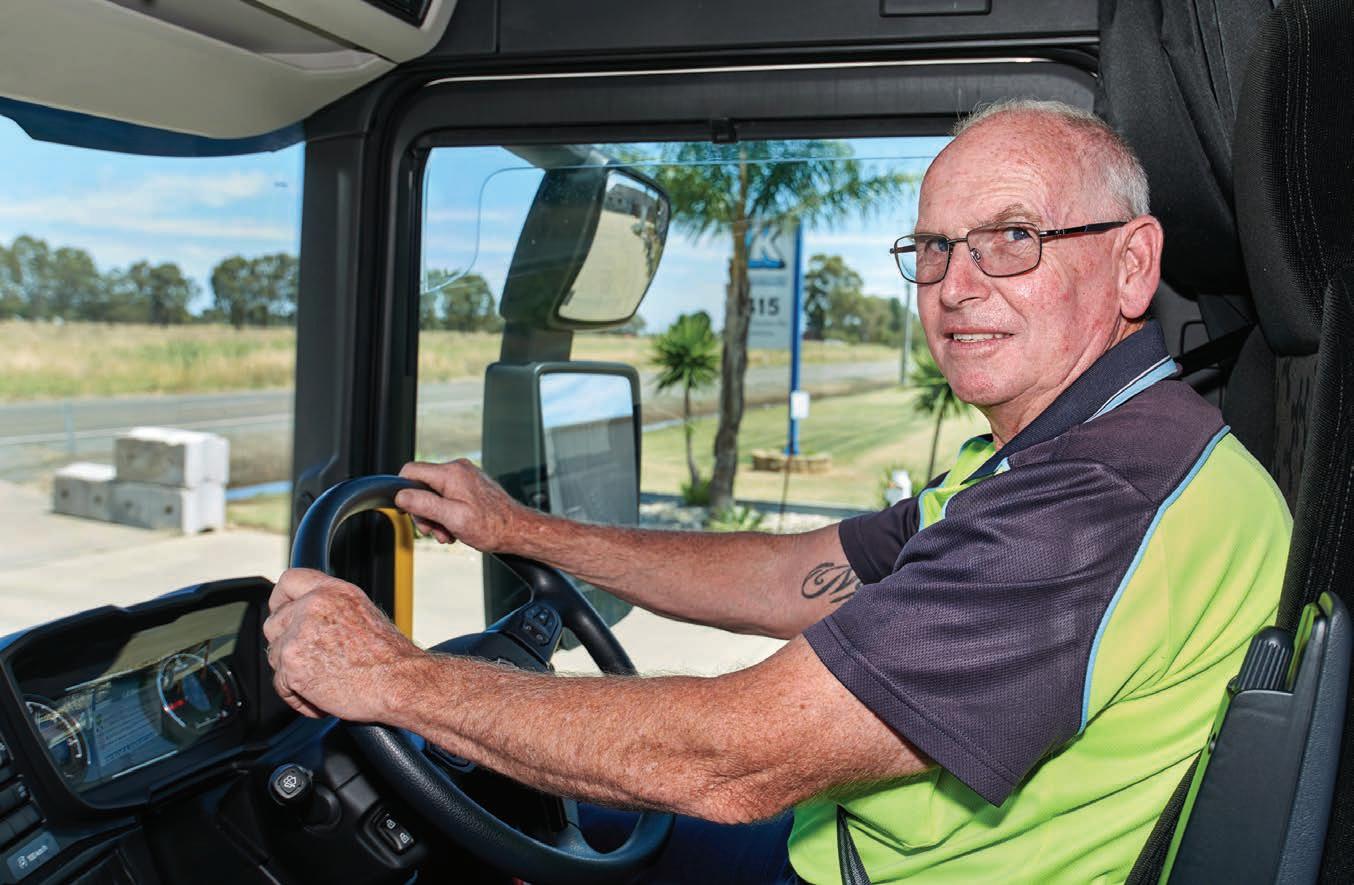

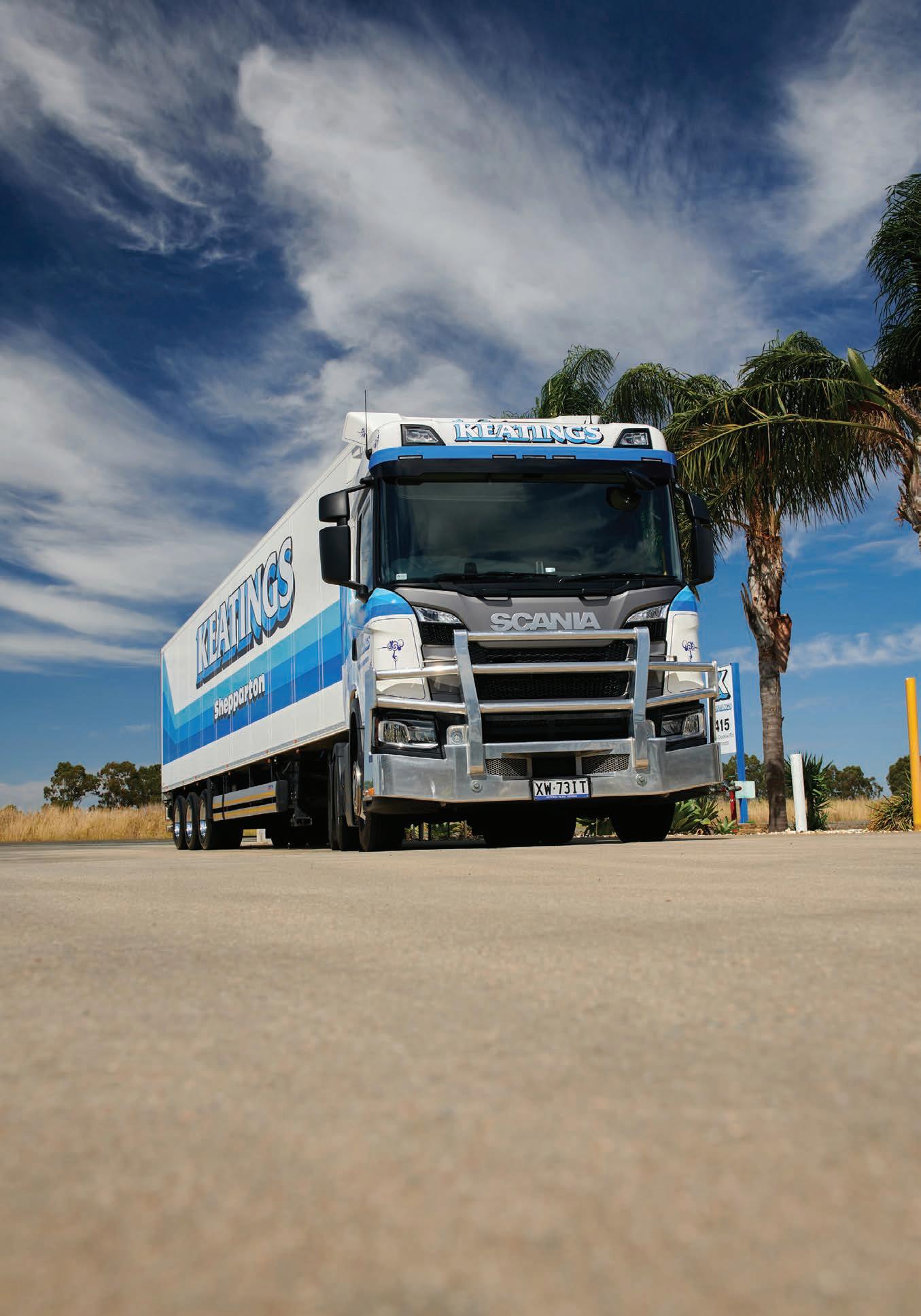

fuel burn numbers.
“That even includes the SUPER 560,” says Mark. “It runs at the same or even better. That number might come down a little bit, but it doesn’t go below 3.0 when you run it as a B-double.”
The trucks, however, don’t always operate to payload capacity. Running up to 58 tonnes on a B-double route, the task is often fully loaded one way and light on the return trip. Some are coming back with an equivalent weight while others might be carrying empty bottles.
The palletised meat trucks, on the other hand, are right up on their weight. Even so, it doesn’t matter what the application or weight is, the new SUPERs are demonstrating encouraging consistency after more than 80,000km, when it comes to fuel economy. The key point of difference is the new G33CM Opticruise transmission, which Mark contends is where the SUPERs are achieving their strong weekly results which he receives every Monday morning from Scania. “That’s where we’re getting our stellar
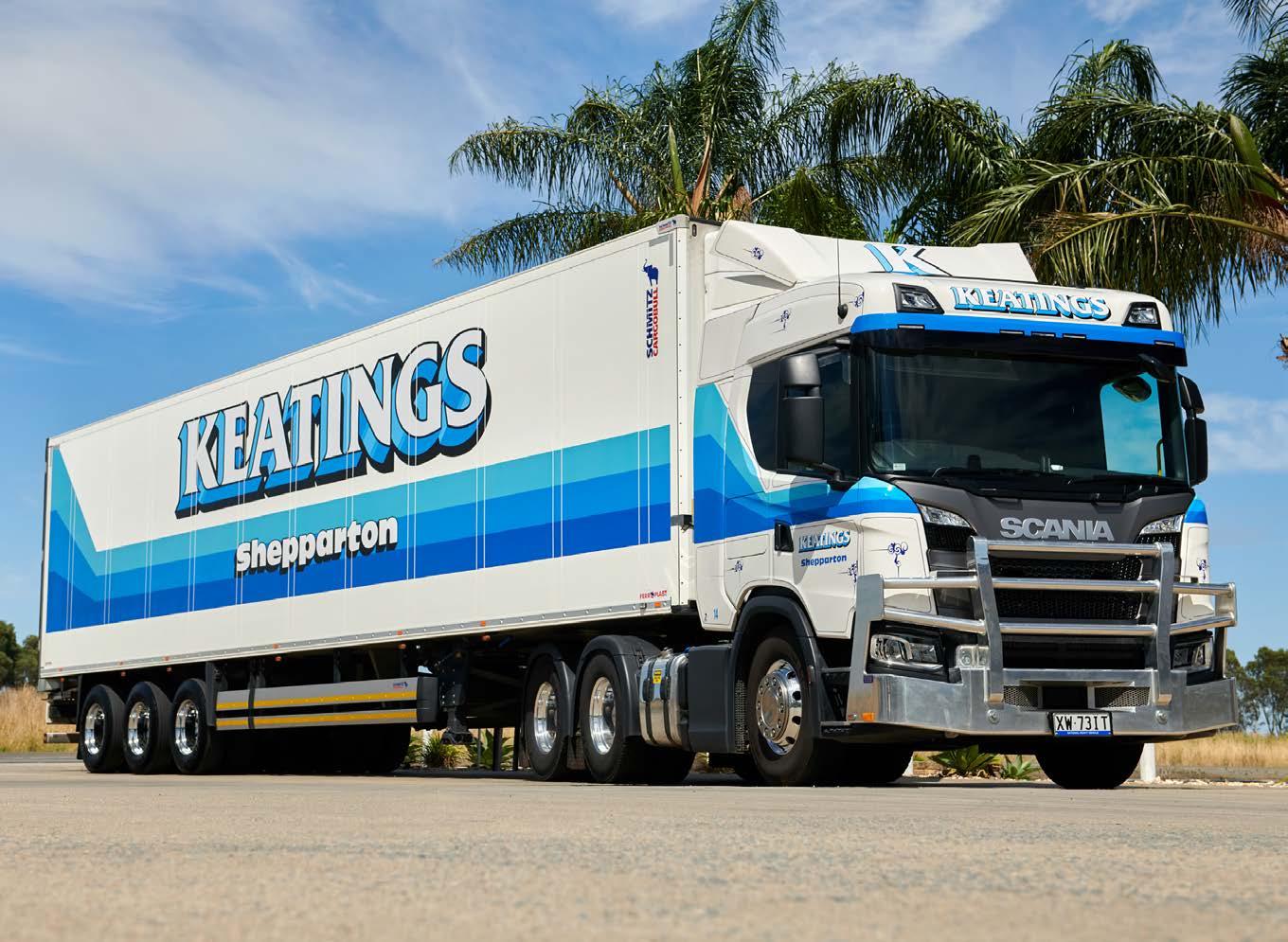
gures because you can coast them a lot more without the truck losing momentum,” he says. “At around 100 km/h the transmission maintains revs. The combination of the new gearbox and engine make for a good product.” With all the main controls located on the armrest for the headlights, mirrors and windows, driver acceptance comes easy with the operational and safety conveniences. Mark says the drivers have had a seamless transition to these newest vehicles.
“Everything in the cab they need to access is made handy for them,” says Mark. “As soon as you open the door the truck activates the maxi brakes straightaway. There’s a lot of safety features and in some of these new trucks we take that opportunity to use the Scania training to upskill drivers that have come in between new truck deliveries so that all the drivers are up to speed.”
Founded in Shepparton, a regional epicentre for the Goulburn Valley region, the business moved in its early
years from a leased site in Mitchell Street to a property in Benalla Road which it soon outgrew. Now they are situated on 23 acres in Lemnos next to the Campbells Soup factory. On site there are six warehouses most of which have been leased out.
Not strictly a cold carrier, Keating Freight Lines since its humble beginnings has specialised in transporting groceries. While the business hasn’t undergone any seismic technological changes during its lifetime, Mark observes the small freight that it once would have moved, has all but disappeared. The refrigeration sphere now mostly outpaces the general freight with less than ten per cent of the work being sub-contracted. That once might have been split more evenly. The trailering equipment is of mixed origin. The last ve box bodied trailers have been delivered new by Schmitz Cargobull. The eet runs 18 Thermo King units, 12 of which have GPS tracking and monitoring that allows for the temperatures to be tracked and even changed, remotely.


“We can turn them on and turn them off just from our phones,” Mark says. “The technology is getting good. Instead of Steve having to come in during the night, which he still does anyway, he can look at his phone and see how the refrigeration units are running in case a driver has had freezer on and he’s picked up chiller product and hasn’t changed it, at least we can sit there and change it on our phones and save the product.”
Installation of a solar panel atop the van body to lengthen the battery life of the units given their operation is intensely stop and start, has proven a panacea. Having spent his entire adult life around trucks and transport Mark constitutes a storehouse of knowledge founded on real world experience from an era largely bygone. He rst learned to drive a LB80 Scania in Geoffrey Thompson’s yard.
“I turned the key on, nobody said a word and I backed it onto the truck wash and started washing the truck,” he recalls. “That’s where I taught myself to drive them.”
Mark, as was the custom, started off in
a ute, moved up to a one-tonner and from there he progressed to an 8-tonne International Butterbox.
His rst trip to Melbourne was in a twinsteer single drive MAN. It was “a great truck with the 12-speed on the column, it used to go like the clappers, but a pig of a thing to turn.” Then there was a single drive UD CK45 tted with something best described, as Mark puts it, as a crash box although probably not one technically.
“If you buggered it up, you’d have to stop and start it all over because there was zero chance you’d nd the gears again,” he says. “It was ne once you got used to it.”
He eventually advanced to a V8 Scania 141 just as the business was consolidating its partnership with the OEM.
“A lot of it back then was at top work,” he adds. “The old hands are paying for it now.”
Back when Ken Keating was with Geoffrey Thompson’s he would get Mark and his brothers out of bed in the morning, and they’d go to the depot and
load containers with pears and go home to have breakfast before school. They’d return home after school and following dinner Mark, Steve and Chris would be back at Thompson’s where they’d help load a couple of containers that night and go home to bed. This early exposure to transport operations only whetted a growing appetite it turns out.
Keating Freight Lines commenced business in February 1982. Mark, from his own account, turned up to the yard one day in June that same year. His parents, taken by surprise, demanded to know why he wasn’t in school. He told them he wasn’t going to school anymore. Naturally, they asked Mark what it was he planned on doing going forward.
“I said, ‘I’m going to work for you’ and they said ‘no, you’re not,’” he recalls. After waiting in the backyard for a while his mother, Dorothy, came down to console him.
“She said, ‘I’ve spoken to your father, you can work here on one condition: that you look for another job,’” Mark says. “I’m still looking for another job.”
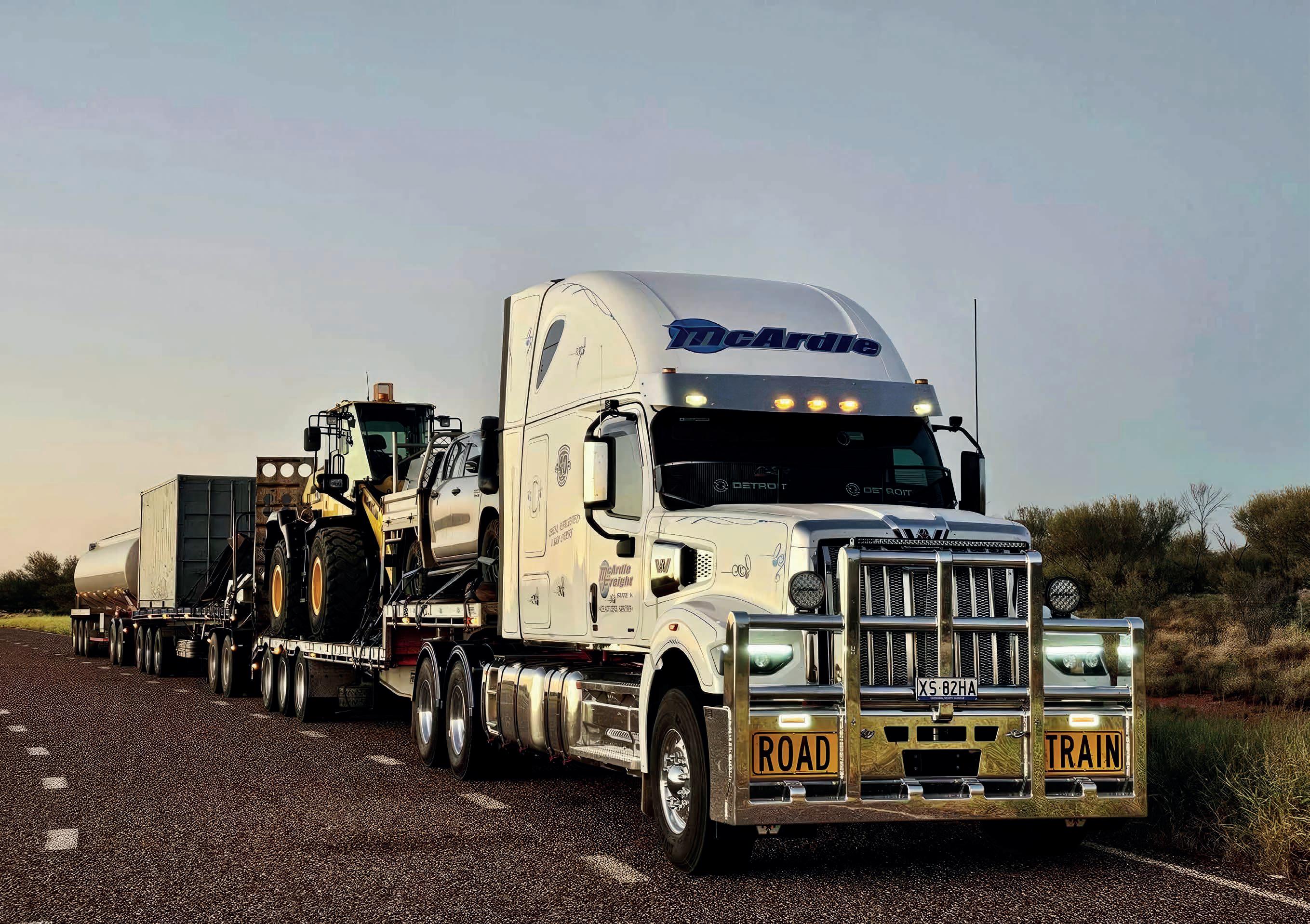
South Australian family-owned long haul specialty out t, McArdle Freight has bolstered its freight forwarding service with roadtrains powered by the latest Western Star X-Series.

The 6,000-kilometre round trip from Adelaide to Darwin is one driver Paul Freeth undertakes weekly. Life on the road is just that. Man at one with vehicle confronting time and space.
It’s a straight shot more or less beside the meridian 135º East Longitude line, made recently more interesting from the vantage of a new Western Star X-Series prime mover of which Paul was the rst driver at McArdle Freight to be handed the keys. Towing a triple roadtrain, the 49X is more than 100,000 kilometres into its initiation with Paul who, most tellingly, is in awe of the fuel consumption results he’s seeing courtesy of the new Detroit DD16 engine.
The eet is averaging 1.41km/L over the life of the vehicle. Company Co-Owner Travis McArdle veri es this.
“Every load and every week are different, so we just run off an average,” he says. “We’ve seen gures as high as 1.56km/L on a three- or fourtrailer roadtrain.”
Carting general freight to local towns in that vast expanse McArdle Freight also will bring these isolated communities cold produce, more as an exception rather than rule. It moves with greater consistency machinery and waste oil throughout Australia generally all done so on the back of roadtrains.
Origins are always of interest as they aren’t easily shed. From a distinct starting point, we can glean, even at a distance, the conditions that set the table for the successes to come. Back when disco was ghting pub rock for airtime on the radio, The Deer Hunter was showing theatrically in cinemas and the Holden Kingswood wrested back the mantle of best-selling car in Australia, Brian and Lynette McArdle were operating as a lone truck fuel distributor contracting for Ampol. That Chevrolet rigid in 1978 would serve as the foundation for what has since emerged as a formidable long range road carrier with 21 prime movers backed by six depots in South Australia and the Northern Territory. Brian and Lynette’s
three children Jarrad, Tamara and Travis now helm the business whose eet, if it can be said to be de ned by a particular truck brand, is distinguished by Western Star. The new 49X was purchased from South Australia dealer, Wake eld Trucks. McArdle Freight has worked with Wake eld Trucks and Western Star since 1999, and when Travis and his siblings took over the family business from their parents in 2021, they had little hesitation in continuing the partnership. Not only mutual, the values of these family-owned enterprises translate into healthy alliances a quarter of a century later.
“Being able to deal with Wake eld each step of the way ensures ease of business – from new equipment through to the parts and servicing departments,” Travis says. “While we do a lot of our own servicing and repairs, having a parts department understand our eet and requirements enables our workshop to run more ef ciently.”
Based in Burton, McArdle Freight employs two full time mechanics alongside a tyre tter as part of its payroll of 30 staff.
“With this being a new product and having a lot of unknowns, we knew that no matter the outcome, Wake eld would have our back and would always do what’s needed to keep this truck along with our others on
the road,” Travis adds. “Uptime is a very important perspective when it comes to the entire operation, I know I can trust the team at Wake eld Trucks to ensure that uptime is maximised where possible.”
Capable of hauling more than 160 tonnes gross combination mass, the Western Star 49X has a 2-year bumper to bumper warranty, and a 4-year 800,000km engine warranty. That made it a relatively easy decision for Travis to invest in. Paul, who had come out of a Western Star 4964FXC with a Cummins X15 engine, however, took more convincing — around 65,000 kilometres worth.
“From all reports, he does not want to get out of this truck,” says Travis. “Paul is a big boy, if he needs to jump to just be able to touch the roof, that speaks volumes.”
Interstate haulage presupposes a spacious cabin with comfortable sleeping quarters for the driver. The 49X offers a large 72” Stratosphere cab with plenty of storage options and air-conditioning that has stood up to the demands of the outback heat according to Travis.
“The driver comfort and liveability of the Stratosphere is second-to-none,” he says.
“[It’s a] wide cab not just high, featuring storage-a-plenty from cupboards to lockers, to under the bed, you don’t want for
much more.”
The 49X is packed with features that improve driver experience and overall performance. Field of vision is improved by 28 per cent compared to previous Western Star models, while 24-inch wiper blades improve the wiper zone by 37 per cent. Dual-stage intelligent LED headlights are designed to last the truck’s entire lifetime, too.
The drivetrain of this unit is composed of tried and tested components such as NEWAY ADZ-252 drive suspension, Dana D-52-190 drive differentials, an Eaton RTLO-22918B 18-speed manual transmission, a Meritor FL941 front axle and 18,000lb taper-leaf spring front suspension.
The 49X also comes with a series of safety features, including active brake assist to detect moving and stationary objects, side guard assists, adaptive cruise control and brake hold mode.
“Having stepped out of a Legacy model 4900 and into the next generation of 49X, the improvements to driver comfort, truck handling and tech put the 49X above any legacy model Western Star in regard to driveability and operator comfort,” says Paul. “I have always been a Western Star driver at heart. The next generation
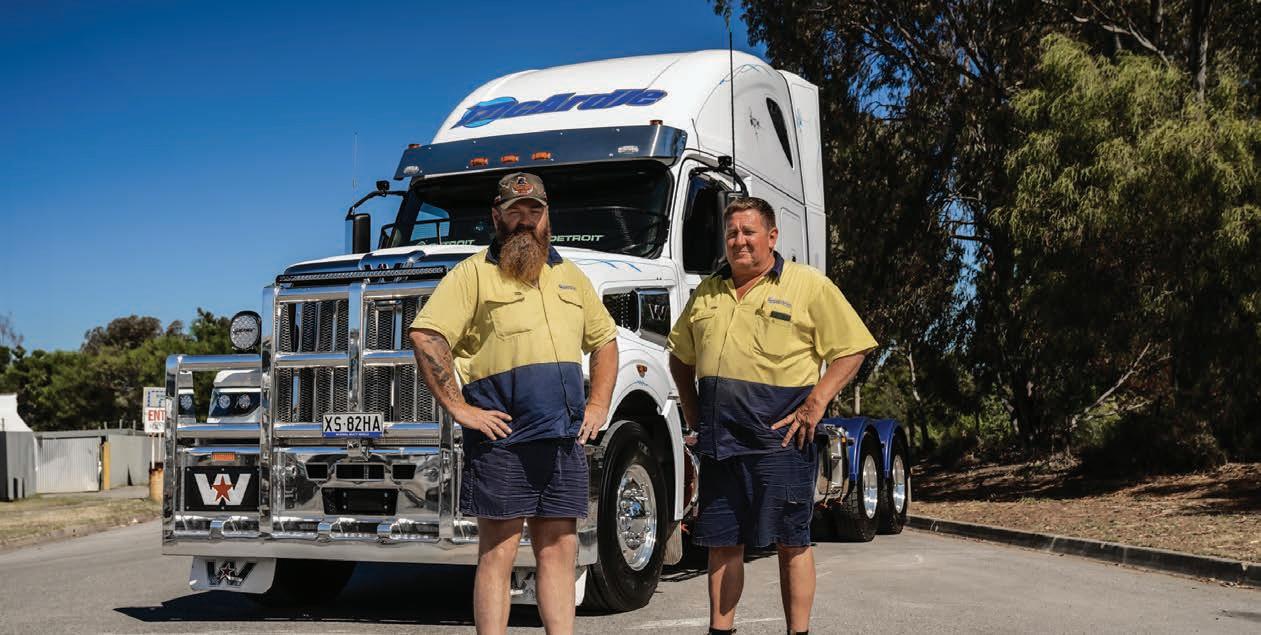
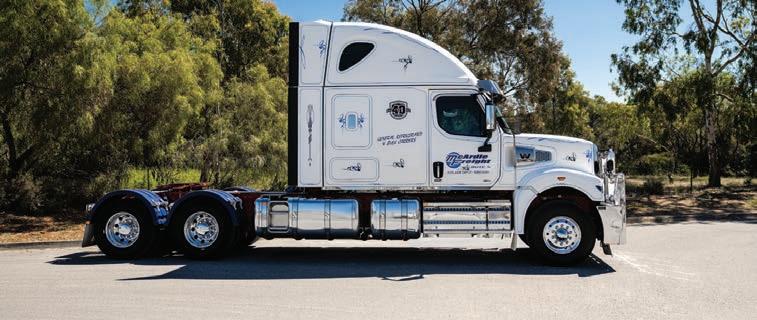
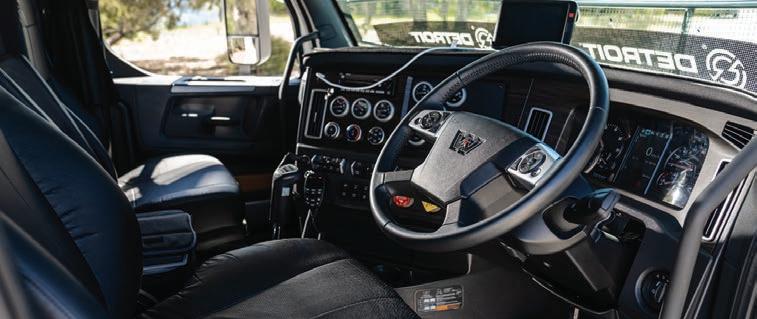
of Western Star has only further cemented my opinion that for operability and driver comfort, the Western Star is the truck for drivers. I don’t ever want to drive another prime mover.”
Also included on the 49X are optional higher capacity rectangular fuel tanks and AdBlue tanks of up to 200 litres. Travis says 2,300 litres-plus of diesel and 200 litres of AdBlue gets McArdle Freight as far as it can on the bulk fuel it has in the depot.
“Extra fuel is always a key factor,” Travis says. “Fuel capacity combined with fuel economy means we can go further for cheaper, helping the bottom line.”
The completely revised aftertreatment system has, so far, fared brilliantly.
“We are yet to have a single problem with the aftertreatment system, and it’s currently using an AdBlue percentage of 3.83,” explains Travis. “This has been retrieved, at the minute, through the remote access to the vehicle via Detroit Connect, another great addition.”
While the prospect of the new Western Star 49X hinged on two simple factors – how would the motor hold up, and how would the cab hold up? – both uncertainties have since been answered resoundingly according to Travis. He points to the power and fuel ef ciency of the new 600hp Detroit DD16 powerplant, with its atter torque curve.
“The Detroit DD15 was a great engine but just lacked HP and at times torque,” he says. “With the New DD16 that excuse has been taken away.”
While the legacy Western Star was in his esteem a “great product”, the X-Series has been elevated to another level.
“Western Star simply produces good trucks and deals with any issues quickly,” says Travis. “Our drivers like them, our workshop like them, they have a long life with few major repairs required, and they look nice on the road.”



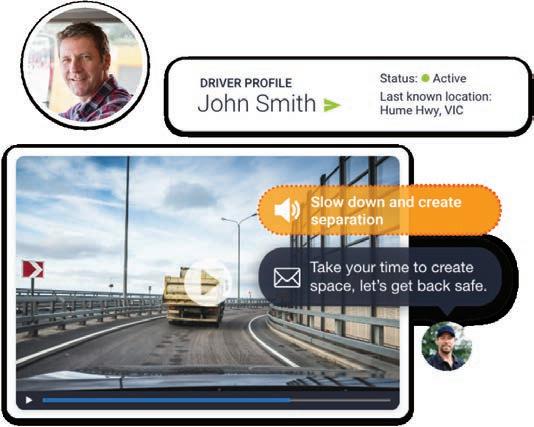

Inverell is known as the “Sapphire City” because of the gemstones found throughout the district where Campbell’s Fuel Service has been supporting its clients for more than 60 years.
Located in northern New South Wales close to the Queensland border, Inverell is the service hub for the surrounding agricultural region which produces crops such as wheat, barley, oats, sorghum, and wine grapes. Broad acre farming requires reliable supplies of diesel fuel for equipment such as tractors, water pumps, and generators as well as for the road transport which delivers the produce to capital city markets such as Sydney and Brisbane.
Fuel is the lifeblood of any successful farm or agribusiness and it is essential to have a reliable supply of fuel to keep the farming and associated transport operations running smoothly and ef ciently, and in non-metropolitan areas such as the greater Inverell region it’s not as simple as being able to drop by the local servo.
Campbell’s Fuel Service was established by Colin Campbell back in 1959 and today his son Stewart runs the business which services customers across the region including those involved in primary production, transport, commercial and mining industries as well as retail and local government bodies. The company currently employs more than 30 permanent and casual staff. Campbell’s Fuel Service remains an independent family-owned petroleum products business and is a distributor of BP and Castrol fuels and lubricants. More than a mere supplier of products,
Campbell’s Fuel Service is considered by many of its customers as an essential partner. In addition to fuel deliveries, this can also involve the provision of on-site storage tanks to assist in best managing the logistics of on-farm fuel requirements.
Operations are based at the head of ce in Inverell and the customer service extends to the other side of the Queensland border with a depot in Goondiwindi, as well as depots in the New South Wales towns of Moree and Wee Waa, where cotton is a major crop in both areas.
Campbell’s Fuel Service also operates the well-known BP truck stop located on the Newell Highway in Moree.
As well as being committed to providing excellent customer service, Campbell’s Fuel Service behaves as a good corporate citizen and is active throughout the communities in which it operates and proudly supports many charities, sporting clubs and organisations. The Campbell family also have their own farming operation and use repurposed Hino trucks which were formerly tankers and are now tted with stock crates.
Bulk supplies of fuel are delivered to the Campbell depots by Toowoomba-based Maktrans, mostly from the Brisbane terminal but some loads are taken out of Newcastle to service the southern end of the Campbell Fuel Service market. “Partnering with Maktrans works really well because they look after the bulk carting operation from terminal

to depot and we’ve only got to worry about delivering from the depot to the customer,” says Campbell Fuel Service’s Jason Cracknell. “They also run some of our bigger farm deliveries with bulk drops taking the fuel direct from terminal to customer.”
Itself a pioneer in B-double fuel tankers, Campbell’s Fuel Services
retains ownership of the trailers, and Robbie and Angela Hannemann from Maktrans provide their own drivers and prime movers, and also take care of the maintenance on the A and B trailers. In addition to typical B-double con gurations, roadtrain combinations are frequently utilised as well. To perform its own deliveries Campbell’s
Fuel Suppliers has been true to the Hino brand for many years.
“Hino has been a stable brand because it stands up to our local conditions and having a service branch close by is good,” says Jason.
The Campbell family have been a long-time loyal customer of Tait Hino in Inverell, and in the past couple of

years have taken delivery of a number of Hino 3248 model 700 Series in 8x4 con gurations which have replaced earlier Hino models. The latest 480 horsepower trucks have a maximum torque of 2157Nm and are equipped with 16-speed automated transmissions. This speci cation is proving to be wellsuited to rural fuel supply applications.
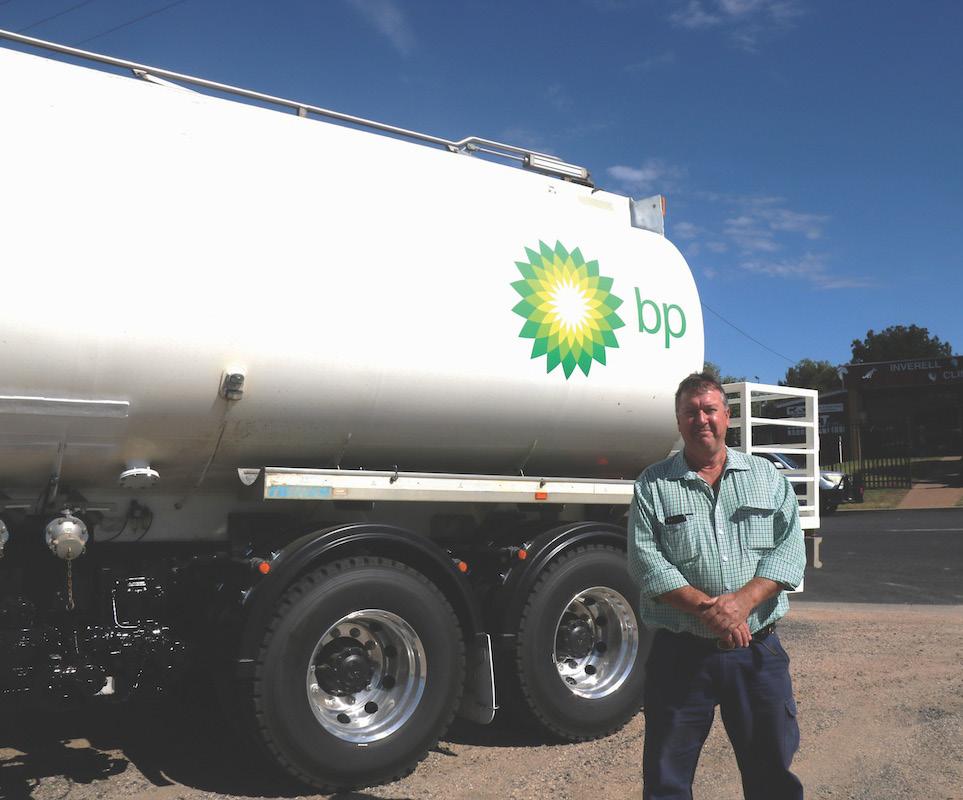
Underground storage tanks are re lled via hoses using gravity, while the onboard pumping equipment powered by the Hino’s engine is utilised to transfer fuel from the tanker to above ground tanks.
The decision to use Hino trucks took place prior to Jason’s time with the company, but he recalls those initial Hino Rangers were a staple for rural fuel suppliers when they rst came onto the market due to their cost and power, and the Hino brand has since
proved to retain its value.
“I think that particular truck model gave them the great relationship with Hino to begin with, so they’ve carried on from that,” says Jason.
Five of the newer Hino trucks operate out of the Inverell depot, with a remaining Hino Ranger retained as a back-op unit.
The Moree and Goondiwindi operations each run two truck and dog trailer combinations.
“I’m particularly proud of our service
because our order and delivery offering is probably second-to-none,” says Jason.
“We’ve had staff who have been here for 15 and 18 years and I have to say that the Campbell’s Fuel family has been the best business that I’ve worked for in over 28 years since I started my career. They’ve been loyal, giving and honest people to deal with.”
Those types of values are typical in ruralbased businesses and re ect the situation where, unlike the cut and thrust found in



other transport industries, good drivers are able to be recruited and retained as the business expands.
In recognition of the need to be at the forefront of operations, particularly in the dangerous goods transport space, Campbell’s Fuel Service recently quali ed for the ISO quality assurance standard applicable to the petroleum distribution industry.
As the older eet units are progressively replaced with the latest model Hino
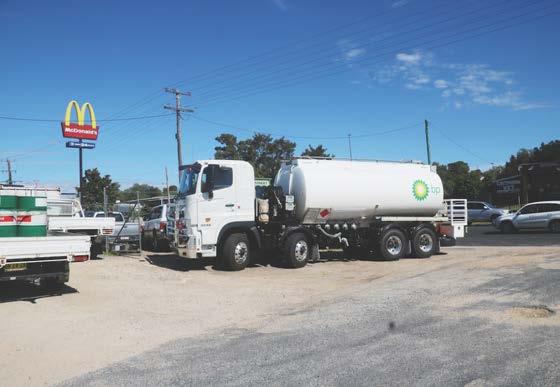
trucks, the bene ts of the Hino Connect telematics system are becoming more apparent, particularly in relation to the remote work which is an unavoidable aspect of the business as trucks and drivers deliver fuel and lubricants to properties located at the extreme edges of the areas in which Campbell Fuel Services operates.
“Hino Connect is going to be of bene t to the company to know where our drivers are and how long the trucks have
been onsite,” says Jason. “It’s also now a workplace safety compliance requirement for drivers doing remote work.”
With many clients spread throughout the northwest of New South Wales and the southwest region of Queensland, by using modern equipment and operational methods and a strong dedication to service standards, Campbell’s Fuel Service combines technology with traditional values to drive its continued growth.
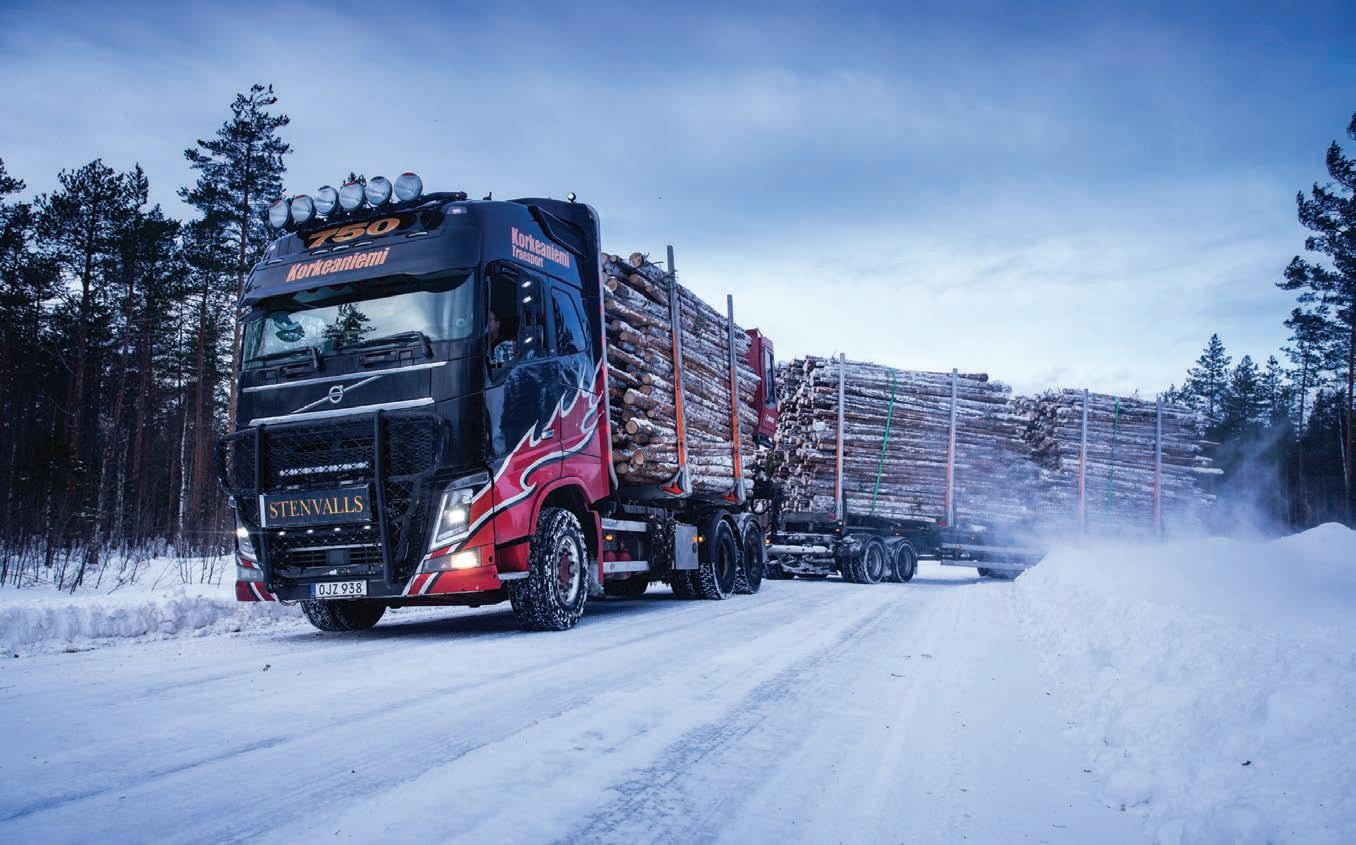
’Skandi’ furnishings are currently very much on-trend and this would not be happening without the contribution of skill and expertise of a family of forest workers who operate a eet of top-spec Volvo trucks in possibly the harshest conditions on the planet.
Mika Korkeaniemi was born in Finland. He established Korkeaniemi Brothers Transport four years ago, after decades of operating forestry machines and timber trucks. Mika has recently stepped back from the transport operations, leaving the business in the capable hands of his sons Christoffer and Johannes, and daughter Paulina who all drive the family’s trucks. It’s truly a family enterprise and a younger brother will soon join the team.
Best known in Australia for being the offseason residence of one S.Claus and lots of reindeer, Lapland is the largest and most northern region of Finland and the
extensive forest plantations provide pine timber for construction and furniture purposes, while the timber from the birch forests is used in the manufacture of paper. Sustainability is ensured due to extensive replanting programs and today Sweden has more areas under forest than it did a century ago.
Forestry is a massive business in Lapland, Sweden and Finland and presents some very tough challenges for those who choose to work in the industry. Obviously, weather is the major factor and must be considered in almost every aspect of the operations.
During summer 20 degrees Celsius is considered normal, while in winter
minus 40 degrees Celsius is common. To cope with the extreme cold the hydraulic systems on the trucks are equipped with heaters to maintain the viscosity of the hydraulic uid used to operate equipment such as the cranes. It’s a relatively mild minus 17 degrees Celsius when we boldly venture into the forest to see the Korkeaniemi Brothers operation at work. The access roads – tracks really – don’t appear on any maps or GPS screens and we use dead reckoning, combined with a little luck and numerous phone conversations, to eventually locate Johannes Korkeaniemi three metres off the ground atop the crane operator’s seat which is attached

to the rear of his Volvo FH16’s chassis. Johannes has been communicating with us via the cellphone incorporated into his ear muffs. Thankfully our local driver and guide is Gunnar Hansson who is a sales engineer with the nearest Volvo truck dealership located in the city of Lurlea and is very familiar with driving in these conditions. His all-wheel drive Volvo station wagon is equipped with studded tyres and he drives with such easy con dence that he is quickly dubbed “The Stig”. Out in the forest, step away from the road and you could nd yourself struggling more than waist deep in a snow drift. The relentless wind carries
with it icicles which hit any exposed skin such as your face with what feel like thousands of needles, melting immediately into an icy cold liquid state which manages to run down our neck despite the layers of thermal clothing we are wearing.
The sense of isolation permeating the forest is made even stronger by the stark white landscape, so different from the red tones found in the Australian Outback. There are no truck stops up here, just the occasional lonely roadhouse which is likely to literally be a “house” on the roadside with a few fuel pumps out front. The Korkeaniemi Brothers eet currently includes ve
Volvo FH16 rigids powered by engines rated at 750 horsepower connected to ve axle trailers. The reduction hub drive axles provide a good compromise between off-highway capability and on road fuel ef ciency. There’s also a lone Scania in the eet and two additional Volvo FH16’s are currently on order with 750hp engines and will be connected to trailers with four or ve axles. Winter in Lapland has short days and long nights so an array of powerful LED driving lamps dominates not only the cab grille, but also another rack of powerful lights that are tted above the windscreen. As sunset in winter is at 4.00pm, numerous work lights
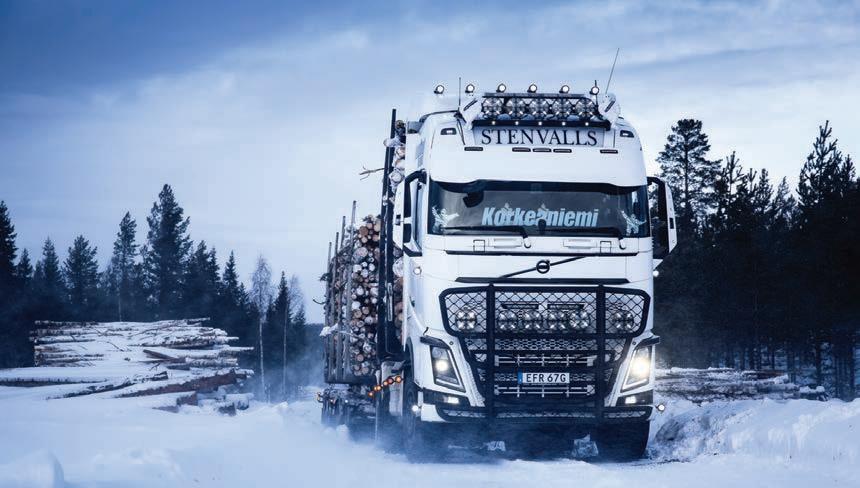
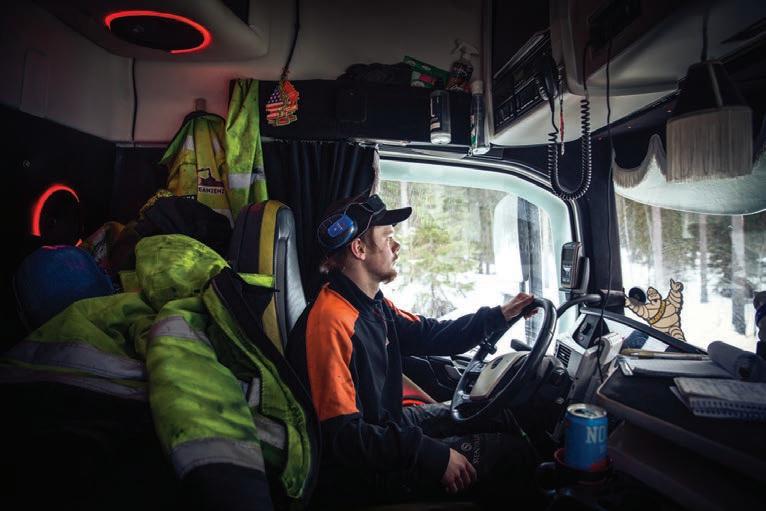
are required.
The single tyre axle located behind the drive bogies is steerable and even with studded tyres on the front axle, when the traction chains are tted to the drive wheels the truck tends to understeer and proceed straight ahead regardless of the driver’s input into the steering. To counter this, and to keep the combination on track, Johannes is constantly engaging and disengaging the diff locks and the power divider as well as frequently manually shifting gears. His virtuoso performance on the big Volvo’s driveline controls reminds us of a concert pianist working at his keyboard. The Volvo’s steering wheel is tted with
a spinner knob similar to what is found on many forklifts. This assists Johannes with the steering function as he keeps one hand close to the driveline controls. The snow chains are tted to the front wheels of the drive bogies to achieve maximum drive traction. Fitting the chains is probably quite an acquired skill but Johannes makes it look easy, assisted by the quick release mechanisms which permit the mudguards to be quickly removed and later replaced when the chains are taken off for the main road journey to the mill.
“Putting chains on is better than getting stuck,” says Johannes. The wheel chains also create a unique almost musical
sound, appropriately reminiscent of sleigh bells. Very occasionally a truck will become stuck, either in the winter snow or the mud created by the spring thaw. Johannes is surprisingly philosophical about getting bogged.
“It happens, and depending on where, sometimes it’s fun getting out,” he says.
The two new 750hp Volvo FH16s joining the eet in 2024 will be tted with snow ploughs at the front. Ask Johannes if he considers himself Swedish or Finnish and he diplomatically and emphatically answers, “I’m both!”
Johannes has been driving the family trucks for four years and though he may be only 23 years old, his calm and thoughtful demeanour gives the strong impression that he is mature well beyond his years. Prior to taking up driving duties Johannes operated forest harvesting equipment for the family’s business.
The trucks collect the logs from stockpiles which are established by the operators of the forest harvesting equipment which is used to cut down the individual trees and strip them of the branches. The family own and operate four of these high-tech machines and all members are skilled in their operation.
The cab of Johannes’ FH16 is equipped with an elaborate sound system dominated by a number of large “woofer” speakers. Johannes says he enjoys “all types” of music and his personalised entertainment system would be at home at a music festival instead of hundreds of kilometres north of the Arctic Circle.
The trucks and trailers are equipped with air operated winches which maintain the tension of the load restraint chains even as the loads settle on their way to their destination. Much of the timber is delivered to milling facilities operated by Stenvalls which is a major supplier of Scandinavian timber products and seeks to maximise the useful yield from every log and maintain the sustainability of the forests to the degree of making good use of sawdust and shavings for animal bedding.
When he is operating the crane to load

his truck Johannes is exposed to the elements, unlike the other trucks which have small cabins for the crane operators. This doesn’t stop Johannes from using the jib and claw attachment as if they were extensions of his own limbs as he deftly picks up the logs and places them on the truck and trailer.
Taking notice of the on-board weighing systems the truck and trailer combinations are loaded to a gross weight of 74 tonnes with an overall length of 24 metres.
Mika and his wife Carola, now, have as their main interest the Forest Jewel traditional Scandinavian handicrafts business which they started in 1981 and supplies a wide variety of items such as reindeer skin rugs and bone and antler handled knives and kitchen utensils.
Handmade Forest Jewel is internationally renowned for being the biggest seller of traditional wooden cups with two nger handles which are made from birch wood boules. We meet Mika and Carola
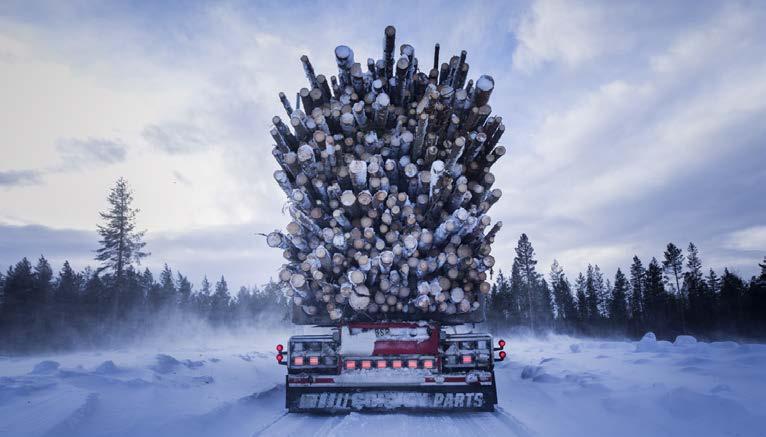
in person at their stall at the annual winter craft market which has been held on the rst Thursday of February in the Lapland town of Jokkmokk since 1605. A tradition, to our count, which has been happening for some 419 years.
Mika Korkeaniemi is a big Viking bear of a man who wears fox fur gauntlets and exudes happiness and friendliness,
in common with Lapland’s most famous resident, the aforementioned Mr Claus. Mika is justi ably proud of his family and the way in which they conduct themselves and the business. He has a natural passion for the forests and is enthusiastic about his sons’ and daughter’s ongoing involvement with their Volvo Trucks.

The flexible and agile Volvo FM Electric. Lower sound and emissions. Excellent ergonomics and visibility. Designed for high-capacity grocery deliveries, container transports, refuse pickups and more within metropolitan areas. To simplify the transition to electromobility, the truck is offered together with solutions for charging, route and range planning and energy status.
Volvo Trucks. Driving Progress The combination is loaded to a gross weight of 74 tonnes.Eaton educator Murray Seymour tours the country enlightening dealerships, customers, mechanics and OEMs on Eaton product including the new automated Endurant XD Pro transmission.
The trap of modern education is it is so often divorced from practical application. In the world of heavy vehicles, theory won’t survive without real world validation. Murray Seymour, as an educator, is certainly quali ed to both teach and train. He brings with him a loaded resume. His extensive background begins in engine reconditioning, mainly on cars and agricultural equipment.
That was followed by a long stint at Detroit Diesel. In 1997, he moved off the tools when he landed with ZF where he was employed as technical support for Victoria and Tasmania. Sales at the time were largely for boats and other bits and pieces. In that role he touched on training with bus operators for the automatic transmissions around Melbourne.
“That was in the days of the overhead projector and transparancies,” he recalls. “I didn’t really have a style per se, but I gave it a crack.”
It was when another colleague, who sat in on one of Murray’s rst sessions, informed him, to his surprise, that he was “really good at it” that the possibility of a career started to take shape.
“The other trainer that day was like a strict school master,” he says. “He didn’t land so well with the audience.”
Murray put his hand up to take over the training manager/trainer with IVECO subsequently revising that program extensively. By 2015, he had moved to Fiat Chrysler mainly supporting Fiat commercial vehicles that mostly went into motorhome applications.
In the wake of COVID, Murray arrived at Eaton Mobility Group, where he is now the Training Manager and Specialist Technical Support. At the same time key players were readying to launch products to market, some of which had been
eagerly anticipated prior to the global upheaval. Eaton, whose new automated Endurant XD Pro transmission was one such product, rolled out in the midst of what became a transitional period for both industry and newly manufactured heavy vehicles.
As Eaton’s dedicated trainer, Murray travels the country conducting workshops on both the latest and pre-existing Eaton product in a formalised setting on average every second week. Leading eets and dealerships like Inland Truck Centre, to name one recent example, are often in attendance.
Murray’s rst port of call at Eaton was a
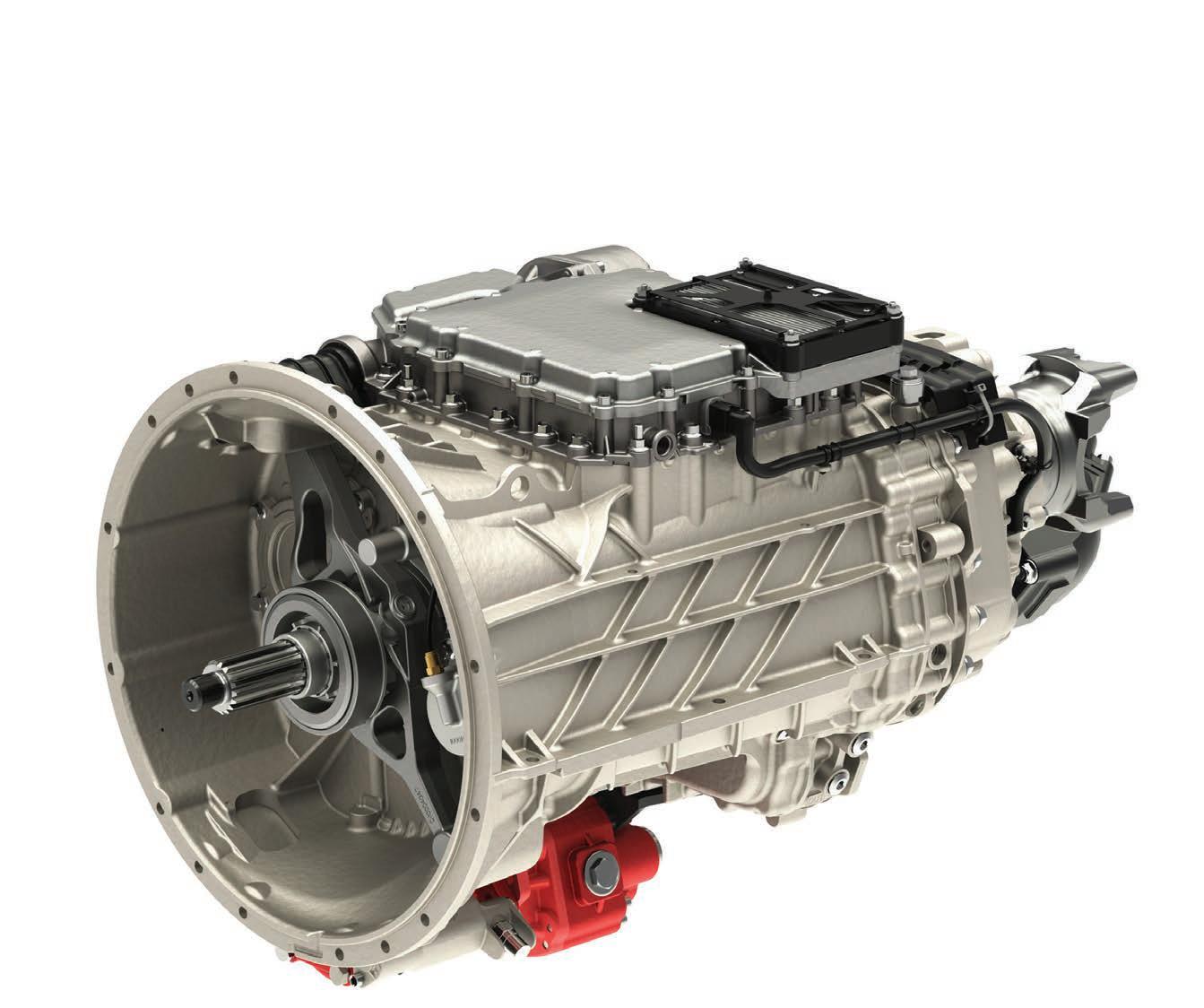
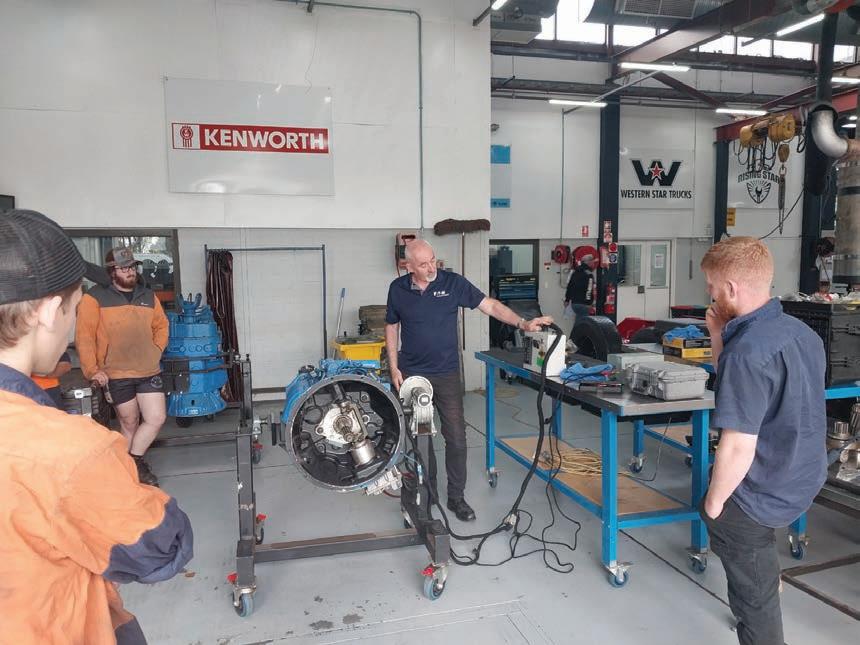


successful training module he created for the RoadRanger transmission, legendary for its role in heavy duty applications. Operators of outback roadtrains still swear by it. Despite the product being well established continuous education is crucial with high staff turnover in industry and people coming in from overseas who have never seen an Eaton transmission before.
The manual version is 25 years old while the automated UltraShift PLUS counterpart, in its current format, has been around for a decade.
“In the older product we will see a large variation in the current knowledge,” says Murray. “There might be people in the training who are a bit wet behind the ears versus people who are experienced who are great to have because you can drag information from their experiences with the product.”
The training program is also a key foundation at Eaton in helping to develop the next generation of truck technicians. Having new products that are purposebuilt clean sheet designs like the Eaton Endurant XD Pro transmissions was an enticement for Murray when he joined Eaton.
“There’s nothing like a new product to create a whole new buzz in the learning environment,” he says. “People pay attention and are generally more interested. That’s a good thing.”
Training on the new Endurant XD has recently begun being rolled out chie y across the Kenworth dealer networks given it is, at present, exclusive to that truck platform in Australia.
“These training sessions across the product range are in high demand,” says Murray.
“So far with the XD Pro product they’re basically sending their experienced mechanics and diagnostic people and service managers because it’s brand new. I’m not having to tailor it too much. Everyone is basically at the same level when we talk. So that’s not really an issue with the new product as it can be for the older product that has been around for some time.”
In his presentation Murray will discuss the technical aspects of the product from weight savings, ratio spreads, to the immediate bene ts it will bring. Also, he touches on the pitfalls particularly in reducing the risk of malfunction caused by incorrect maintenance and handling procedures.
“We talk about some of the pain points we’ve already seen,” Murray says. “For example, making sure when you install a clutch you do it exactly to our instructions in the service manual. If you don’t do it, you will in high likelihood cause a problem for yourself and the owner.”
The Endurant XD Pro Series features a clean, contained design with internal wiring and sensors to minimise exposure and corrosion to wires and connectors for improved reliability. It’s even 102 kilograms lighter than comparable UltraShift PLUS models.
Murray also talks about the pneumatically operated transmission, which makes for a change, as it is not driven by electric Servo motors like the UltraShift PLUS models. Many are the advantages of having hardware purpose-built to match with the automation rather than it being an add-on with a manual transmission as was the case, previously.
“There’s a whole lot of information we go through,” he says. “We examine the power ow through the transmission and when we get to a certain point where interest leads to the guys asking lots of questions, we will pack up the computer and head out to the workshop area depending where
we are.”
At Eaton’s Rowville facility, there’s a purpose-built training room with an overhead gantry. Without stripping it to its last bolt, Murray will pull down the Endurant XD Pro far enough so that those in attendance get to diagnose it and perform external vehicle repairs with con dence. The front covers are removed so that all the different areas that technicians are likely to eventually to see are exposed. The Mechatronic Transmission Module (MTM), in essence the lid of the transmission, is inspected with all the solenoid caps, sensors, pistons, shift forks and rails that action the changing within the transmission. Murray will then pull the rear end of the transmission to look at the range change to set high or low range.
“We look right into the back of the transmission to better understand how it’s constructed,” says Murray. “Some people will need to see it as a diagram on a PowerPoint and other people will physically need to see it. There’s different styles of learning for different people.”
With the transmission half-stripped, Murray will take attendees through a PowerPoint presentation, so everyone understands how the Endurant XD Pro functions before he starts the reassembly process. That includes some of the critical areas like reinstalling the MTM to ensure it’s done correctly. Once the transmission is assembled, they return to the classroom environment to go over the electronic service tool called Service Ranger. Murray will power it up off the transmission on the bench and connect up the diagnostic service tool before going through the different areas of interest ahead of a potential service. Speci c areas for calibrating the shift elements within the transmission are viewed. The same goes for clutch calibrations.
“We’ve got a series of ten questions,” explains Murray. “They get the ten questions at the start of the day, and they get the same questions at the end of the session to assess the knowledge participants have grasped.”
Balancing the theoretical and mechanical parts, the training session also provides a
notable section on computer networks. There’s very little the driver can do, according to Murray, to damage the transmission.
“They can still trash fuel economy of course by driving it manually and overriding the logic the transmission uses to shift gears,” he says. “But getting back to maintenance, the bene t of this transmission, apart from changing the oil and providing a supply of clean air from the vehicle, the savings are already there because it’s very much a low maintenance item.”
On Eaton’s previous transmissions, the clutch was a maintenance item with external harnesses and wiring. Now it’s all basically integrated into one module protected from outside elements.
“From the maintenance concern, it’s very easy to maintain,” says Murray. “Our aim for the training is to make sure if a vehicle rolls into the dealer the technician is adequately training and conduct the appropriate servicing to maintain reliable trouble free operation.”



Australia’s construction industry is facing a labour crunch and supply chain issues, which means builders need to be more cost conscious than ever before. Your vehicles are an obvious place to start. Geotab’s innovative open platform for fleet management helps project managers track assets, increase equipment uptime and lower operating costs seamlessly. Here are three reasons why Geotab’s telematics technology might be the right fit for your construction project:

Track and locate equipment, while ensuring maximum utilization
It’s hard to control costs without visibility over your equipment. There’s a lot going on at a construction site at any one time, but devices such as our GO9 RUGGED can collect data from any vehicle. From fuel consumption to engine hours, our telematics technology connects directly to the vehicle’s computer and efficiently tracks every piece of equipment to ensure it is well-utilised and costed for. And by tracking it, you will always know where it is, which means you won’t have to lease additional equipment because you can’t find it when you need it. Moreover, our real-time equipment tracking can switch between cellular and satellite networks, meaning that costs are tracked and nothing gets lost, even on remote work sites.

Enjoy Fuel Tax Credit Rebates with our data automation
Fuel Tax Credit Rebates can offer substantial savings for construction businesses, especially if they use a lot of fuel. But those savings could be far less if an accountant has to spend valuable hours collecting and untangling the data in order to get the payment processed. Geotab’s solutions can make the process much easier. Our telematics technology can accurately measure on and off-road usage, which is essential data used to claim fuel tax credit rebates. Calculating usage is a different process for construction sites, as it focuses on engine hours instead of distance travelled. GO9 RUGGED can track data on fuel usage and economy, and can also track fuel usage while trucks (such as a cement truck) are stationary and idling.

Access everything seamlessly on our single platform
Geotab offers the greatest possible flexibility for construction projects. Our devices can be attached easily to any vehicle – regardless of manufacturer – and they can send the data to the same platform. Installation is simple, which means it is possible to attach a device to contractor and subcontractor vehicles, giving you visibility over the whole project, and enabling you to track fuel efficiency, fuel burn, RPM, battery oil, engine health and other key indicators. Furthermore, through the multi-streaming function, subcontractors can be granted access to a database for a fixed duration. When the contract ends, their visibility to the site will cease, and the contractor can reassign it to someone else.
Our devices are built tough, to withstand conditions on work sites. Our GO9 RUGGED device is ideal for heavy equipment, construction, utilities, powered assets and trucks. It’s also IP68 and IP69K rated with impact, water and humidity resistant housing.
Begin your journey with Geotab today, into a future where every trip is safe, and every operation is efficient. With our GO9 RUGGED, you can track valuable assets, increase equipment uptime and lower operating costs.
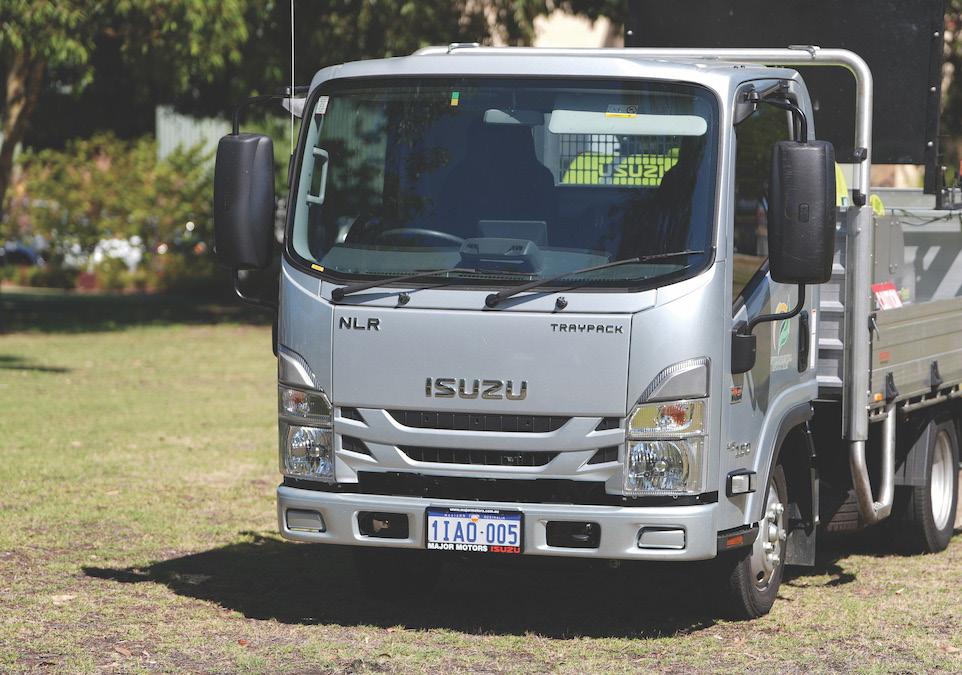
Environmental Industries relies on a large eet which contains 40 Isuzu trucks it deploys on major landscaping projects involving many public spaces across Western Australia.
Close to a quarter of Perth’s land area is classi ed as parks and gardens. The city’s reputation for great living derives in part from both its close proximity to the picturesque Swan River and its many beautiful beaches and their scenic foreshore areas. The beau idéal, in terms of climate for a capital city, Perth can’t help but encourage outdoor activities.
Local landscaping and constructions specialists Environmental Industries have been entrusted with looking after many of the public parks and playgrounds in and around Perth and other parts of the state including as far north as the Pilbara. In addition to
this, Environmental Industries handles sporting elds, commercial land developments and streetscapes along the Indian Ocean and in regional areas. Over the decades the sure re practices of the business have led to reputational excellence in both the public and private sectors. Some of its biggest contracts include the Fiona Stanley Hospital, the Crown Towers in Perth and Central Park in the CBD.
With a solitary ute, Barry Winterbourn launched the family-owned and operated company in the early ‘80s on a project for works on the Burrup Peninsula outside of Karratha. His son Brendon Winterbourn is now the General Manager.
“Our clients are speci cally looking for environments that people and the public will be excited to use,” he says.
“The sites we build and maintain need to be inviting to encourage people into the space.”
At Cottesloe Beach, the company was responsible for the Dutch Inn playground upgrade, which involved the demolition of the existing playground, and construction of a new a ship themed play structure, ninja style obstacle course and nature-based play area. In the City of Wanneroo, Environmental Industries were awarded a multi-sport facility, handling bulk earthworks and drainage, car park construction, oodlighting, limestone pavilion terracing, tennis


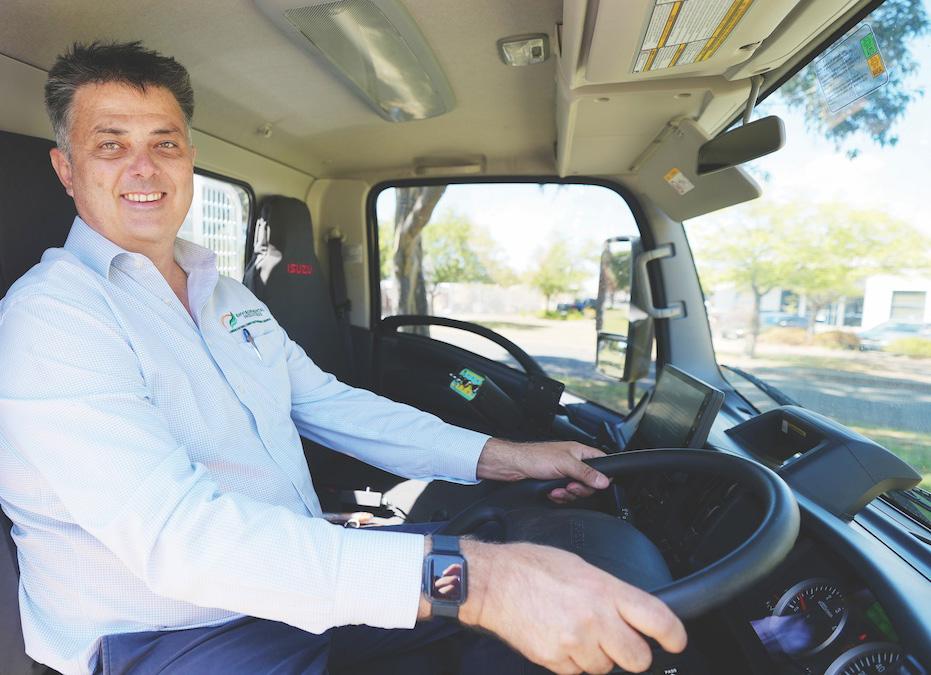
and basketball hardcourts, asphalt and concrete pavements, cricket pitch and nets, long jump and discus throwing area, two large, turfed ovals and irrigation and bore construction.
The award-winning subdivisions at Bletchley Park and Ellenbrook, among several others, are worthy portfolio entries that most any landscaping company would be happy to be known for.
The business now boasts over 100 vehicles in its eet. Its rst major phase of growth occurred in the early 2000s when it only had four trucks and some utes. With over 40 Isuzu units, the range here varies with light-duty trucks like a NLR 45-150 AMT Traypack with a customised tail lift that was recently
added, through to heavier FVZ 240300 Autos that have been speci ed as a water truck and a garbage compactor, respectively. These work across multiple projects.
Sustained business growth has meant the equipment lockers are expanding quickly to stay level with demand.
Plans are in place with Major Motors Forrest eld and Sales Dealer Peter Dewar, according to Brendon, to move the entire transport operation over to Isuzu Trucks product.
“We have a long-term plan with Major Motors to keep operating Isuzu Trucks and continue building the eet to meet our needs,” he says. “The consistency in customer service and reliability is one of
the reasons we go back time and again to Isuzu and Major Motors—we want to be dealing with the same person to build that lasting business relationship.”
The business currently utilises approximately 95 per cent of the eet to maintain project spaces once development has been completed. Brendon says that a large part of the strategy is upgrading their remaining utes to light-duty trucks.
“The business is transitioning away from utes towards light-duty Isuzu trucks for a number of reasons—they have better durability, we can t more on the back of them, and we nd they tow better than a ute,” he says. “The smaller trucks, such as our NLRs, are perfect for three
team members on a job site to travel to location with mowers and landscaping equipment loaded in the tray.”
The business nds Isuzu’s short wheelbase Ready-to-Work NLR 45-150 AMT Traypack—with GVM of 4,500 kg and GCM of 8,000 kg—a useful turnkey solution for carrying out their massive grounds maintenance roster.
Featuring a payload of over 2,000 kg and tray space large enough to load equipment and tools for the day, the NLR Traypack also offers a generous towing capacity of 4,000 kg, making an ef cient exercise out of towing heavily loaded trailers.
Six-speed AMT with both fully automatic and clutchless manual operation modes rounds-out a package that is driveable on a car licence, meaning a wide range of Brendon’s staff can get behind the wheel at any time. For further ease of use, Environmental Industries have added an aforementioned customised hydraulic tail lift which works with the Traypack’s
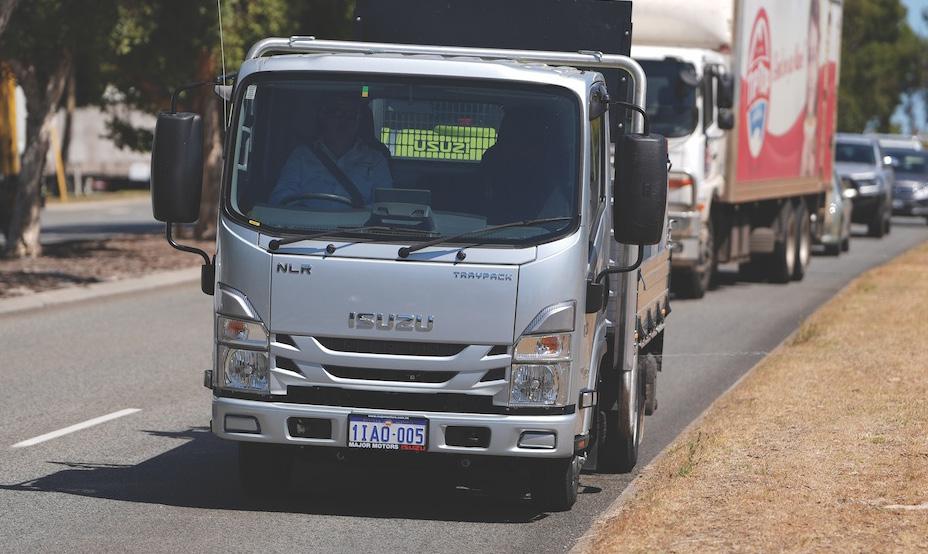
removable drop sides for loading equipment and green waste.
Major Motors, Sales Dealer Peter Dewar, who is proud to have worked closely with Environmental Industries for almost 35 years, says the focus will remain on providing best-inclass transport solutions to support Environmental Industries and their
clients in the years to come.
“Our two companies have worked together for a long period of time, and over that time have built up mutual trust and respect for one another,” he says.
“Collaborating with them on their eet requirements and watching the business become the success it is today has been really rewarding.”
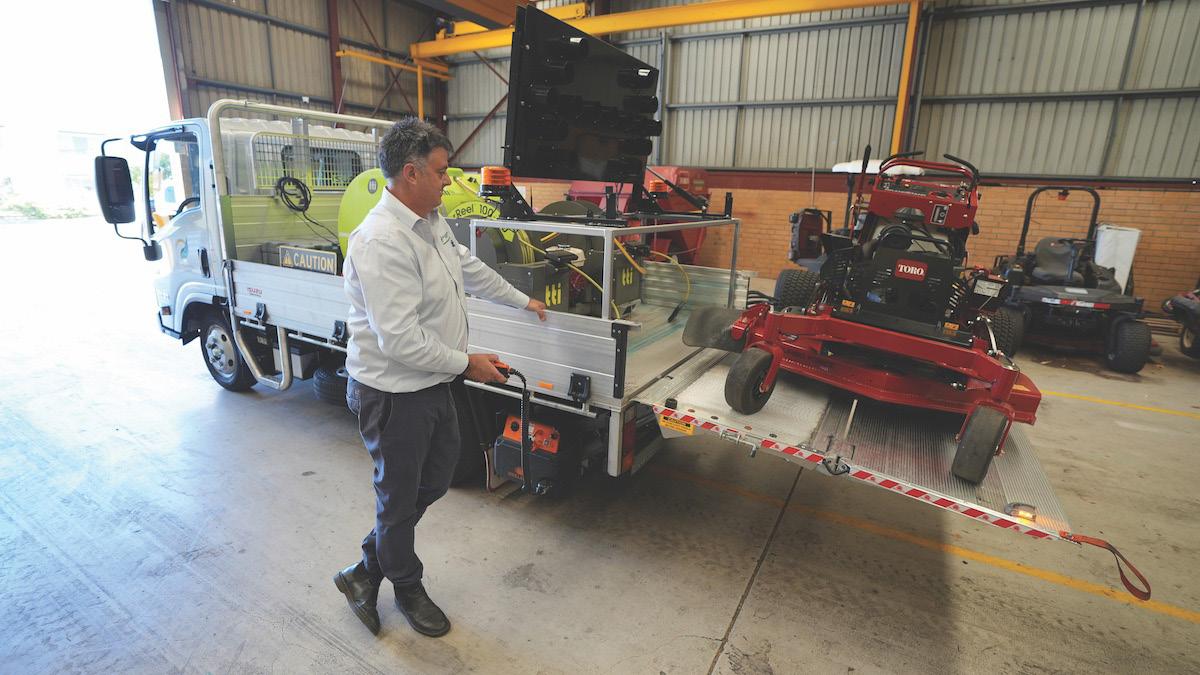

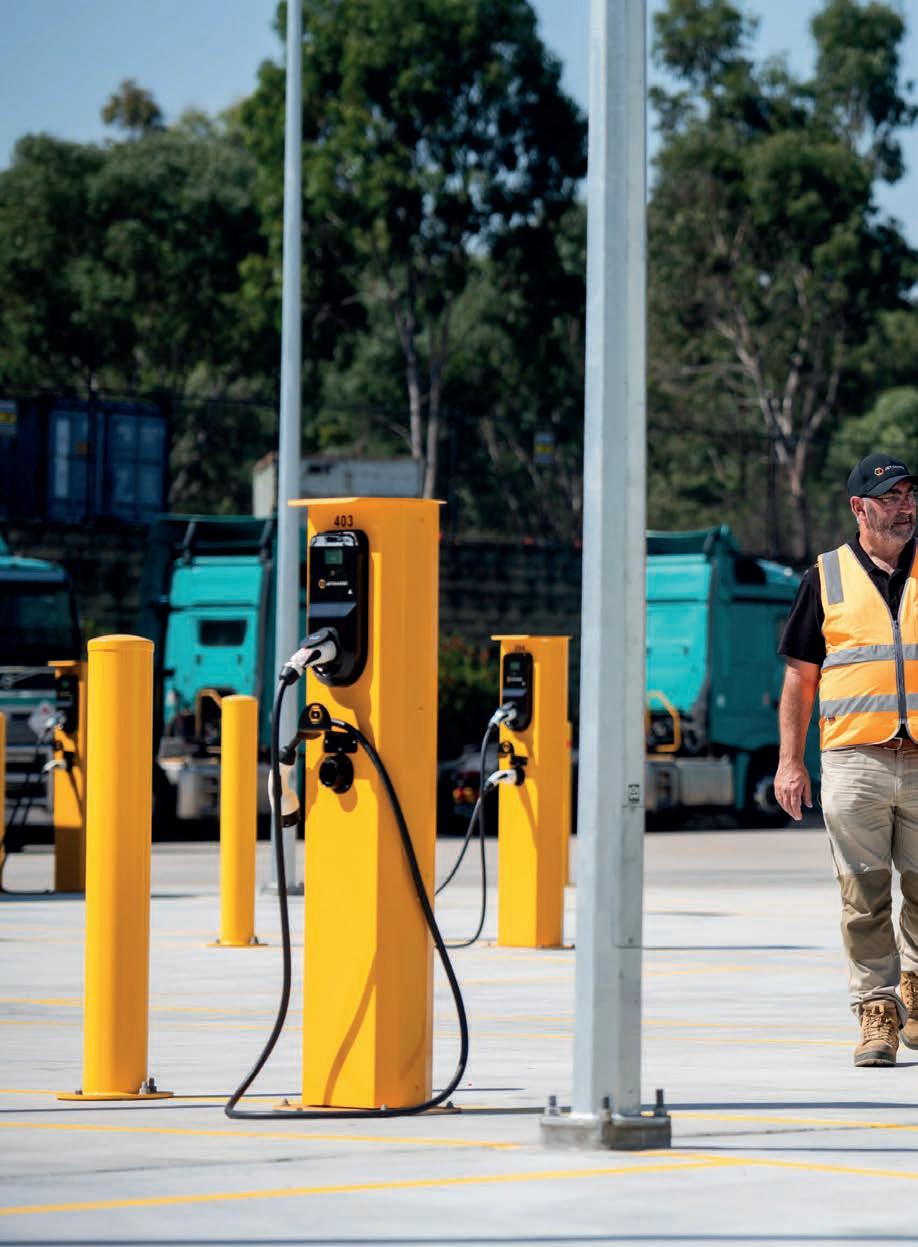

Now with a ten-year legacy in Australia, SAF-Holland’s V.Orlandi E551BOM tow coupling has proven to be a very high-quality and dependable product for heavy vehicle eets, especially those running tipper combinations and roadtrains.
Acquired by SAF-Holland in 2018, the V.Orlandi range covers a plethora of different models of trailer couplings. Yet, according to SAF-Holland, it is the E551BOM coupling which is among the strongest and lightest of its kind in the industry. This makes it a unique product for several reasons.
The E551BOM 50mm coupling, SAFHolland claims, is a favourite among many major eets in the eld especially those pushing higher mass limits. In these instances, it has a proven track record in a variety of applications under harsh Australian conditions.
The product features a 50mm diameter pin with metal wear pad and mechanical lock, providing an impressive 330kN D-Value rating. Ensuring the pin cannot be inadvertently disengaged, there is a safety mechanism on the left of the unit that needs to be released before the handle can be moved.
The D-Value measures the overall capacity for the horizontal forces involved in a truck and trailer combination, taking into account the weight of the truck, trailer, the weight on board the trailer and the acceleration force due to gravity. It has become a critical factor for V.Orlandi and SAF-Holland as it is the main towing indicator that shows how much weight a eet operator can carry, factoring in the operational needs of the application. Choosing the right component for an application and its working environment
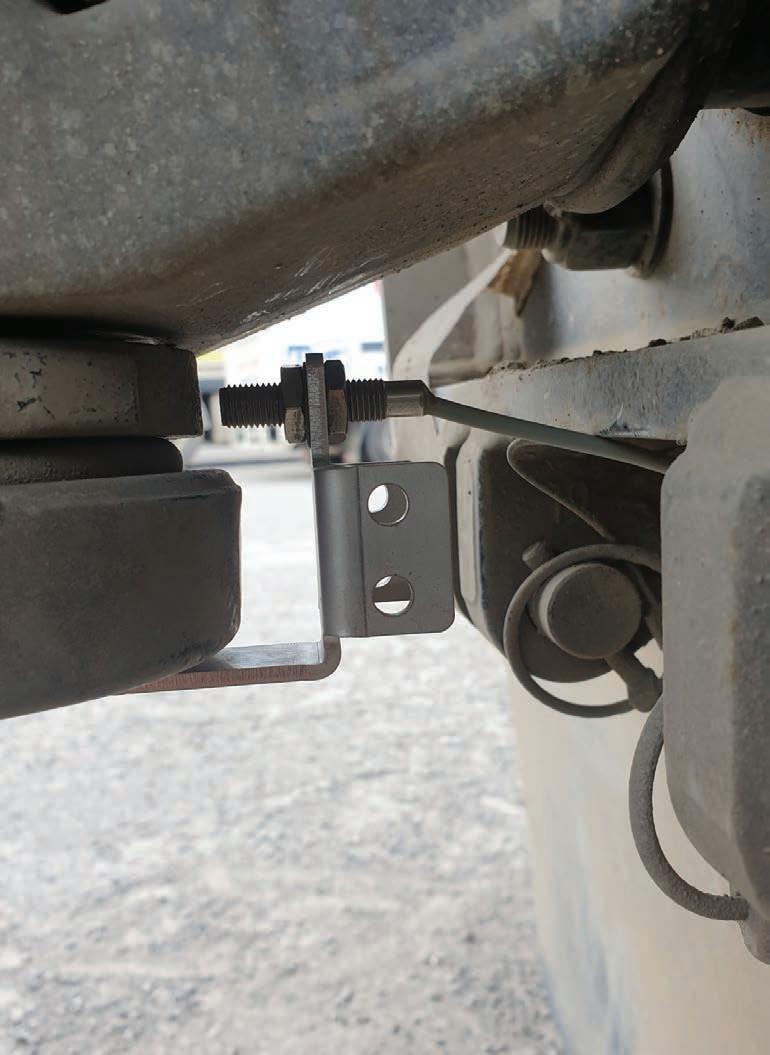
is vital for heavy vehicle eets, and it’s why V.Orlandi can also assist its customers with an online calculator service that can acquire and analyse D-Value data.
SAF-Holland’s E551BOM tow coupling is promoted as the lightest of its kind at just 42kg. At the same time, it reportedly features the highest vertical or S-Load rating of 2,500kg. With the ability to be mounted on a standard hole pattern on transom, the coupling uses an International Standard (ISO) bolt pattern of 160mmx100mm for mounting to the truck chassis. In short, it gives operators an optimised exibility as it is interchangeable with other brands of tow couplings in the market.
V.Orlandi tow couplings incorporate several features designed to reduce the time taken to couple and uncouple, as well as that of replacing various components in the case of damage or wear over a long period of operation. This results in decreased downtimes, meaning the vehicle can spend more time on the road earning money.
One such feature included, particularly useful in tipper and dog applications, enables the trailer to be uncoupled at any drawbar angle up to the 105-degree ‘jack-knife’ position. The mechanism box is also fully sealed to minimise the potential of dust and moisture entering,

which can cause the pin to bind, hindering pin release. The pin itself undergoes full-length extended heat treatment during the manufacturing process to ensure ultimate strength and wear resistance. Plus, the tness for duty of every pin is veri ed by a 100-per-cent quality control of pins consisting of dimensional, material and magnetic particle inspection.
According to SAF-Holland, the E551BOM’s encapsulated locking mechanism makes the replacement of the pin an easy ‘ ve-minute job’, as there are no loose components and disassembly of the entire unit is not required. In addition, the opening handle is located in a safe position behind the bell-mouth in order to reduce injuries. The bell-mouth is a separate bolt-on casting and can be easily and quickly replaced in the event of damage.
A number of optional features can also be added to the tow coupling, including an externally mounted red and green indicator light display which con rms whether the pin is engaged or disengaged, and a jack-knife indicator with acoustic warning mounted in the prime mover’s cab. There is also the option of an air-release for the pin to maximise operating times and minimise the risk of operator injury caused by manual pin release. This includes an onbox safety indicator that veri es correct pin engagement.
V.Orlandi’s product offering is very price competitive and is stocked at all major stock wholesalers Australia-wide, such as Truckline, MaxiPARTS, Multispares, PACCAR, Volvo and Daimler.
The SAF-Holland Group is one of the world’s leading international manufacturers of assemblies and components for prime movers and trailers. The OEM produces a whole series of market-leading products under several brands.
Under the wing of SAF-Holland, V.Orlandi remains a notable player in the local industry. With its market share on the rise as more customers are exposed to its inherent high qualities, the brand, exempli ed rsthand in the E551BOM tow coupling, is proving a serious contender across a range of products suited for the most rugged of applications.
At a time when Viva Energy is set to embark on an exciting new era, Mairead Hayes’ team is driving innovation and e ciencies for their customers, who represent a wide spectrum of transport companies including some of the biggest names in the business.
The career of Mairead Hayes, National Sales Manager of the Commercial Road Transport team at Viva Energy, is the unintended consequence of a year-long backpacking furlough which brought her to Australia from Cork in Ireland where she studied and was raised. That was 18 years ago. In the past eight of those, she has held various roles at Viva Energy having started in a marketing role primarily focused on Shell Card, before she moved into a customer-oriented position looking after large national transport operators. That led to a role where she was responsible for tender submissions mainly working on bids involving some of the largest transport organisations in Australia. She loved the challenges that came with it.
“You’re dealing in very large volumes with quite often complex organisations — organisations that have potentially grown through acquisition.” she says. “These guys are focused on the bottom line, focused on trying to drive ef ciencies. We know transport is a tough game, regardless of the size of your business.”
In her current role she manages the national sales team which has a portfolio of hundreds of customers. That team of seven looks after what is the traditional transport sector involving trucks and buses. There’s another team that works parallel to Mairead’s who take care of several of
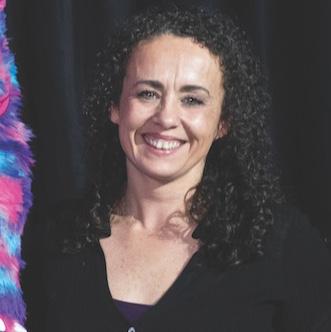
the major eets. The prominent diversity found in the transport sector is a point of enjoyment according to Mairead.
Not just in terms of the size of operations either, but also in their structure.
“On one end of the scale there’s large publicly listed organisations and on the other you’ve got family-owned operations and you’ve got owner-drivers,” she says. “My team has customers that buy 20 million litres of fuel from us, through to customers buying less than one million litres of fuel. It’s a broad range both in terms of their size and their makeup.”
That same contrast of customers continues to be a source of enjoyment for Mairead.
“I love the diversity I get in this role,” she says. “It means that some days you’re sitting in a board room and you’re having
conversations with customers and other days you’ve got your boots and safety gear on and you’re out there and the guy doesn’t have time to sit down and you’re walking around with him in the yard while he’s talking to you. That’s awesome. They both bring different levels of pleasure depending on what’s going on.”
Mairead’s team, by her own account, is a blend of experience and youth. Backgrounds in industry mostly differ. There’s some from logistics, another from the pharmaceutical industry, someone with 20 years experience in the job and a university graduate, who has a strong transport heritage through their family.
“All of them bring different perspectives and can add different things to customer conversations,” she says. “There can be lots of things that can be brought to the table in how we can help streamline their operations.”
For instance, a prime candidate would be a customer who still dips into the bulk tank every day for a read on how much diesel has been used that week before placing an order with the supplier. Mairead’s team can work with the customer to remove unnecessary manual handling. One cost-effective solution would be to have appropriate technology tted to the tank for sensitive reads, within agreed parameters with the customer, to streamline diesel orders, adding
genuine ef ciencies.
“It means the guy has not been taken away from everything else he needs to do on site to check the tank,” says Mairead. “There’s also improved safety with that. You don’t have to walk back and forth across the yard essentially.”
It’s not uncommon for one of Viva Energy’s customers to order bulk fuel and use a Shell Card. Mairead’s team has run exercises comparing the retail sites the trucks are refuelling at with the units that are very close in proximity to the depot where the bulk fuel is stored. In those instances, it can help change some of that driver behaviour which will reduce costs given bulk fuel can be more cost effective. There is one example, according to Mairead, where the customer is now saving $250,000 a year. The portfolio of customers is impressive. It features the likes of SCT, McColl’s Transport, Silk Logistics, LINX and Road Trains Australia. In addition to the expansive range of traditional hauliers, there are also customers like Aldi who take ownership of the direct eet.
With the price of diesel so volatile in recent years, given the impacts of international con icts on oil supply, Mairead is pleased to see more transporters building fuel levies into their contracts with their customers as a way of protecting their bottom line.
“Because they can get squeezed from both ends — especially if they’re working for really big customers,” she says.
“Organisations like the VTA do a great job in supporting operators and helping
them to make sure they’re going to make some money, too, and upskilling these guys in terms of structuring these contracts correctly.”
Viva Energy’s National Sales team for commercial road transport is responsible for bulk fuel sales, lubricants, Shell Card and includes the leasing and selling of bulk fuel tanks and lubricant workshop equipment.
“It’s quite a broad remit but that’s good, right, because it can mean we have really broad conversations with our customers,” Mairead explains. “From the customer’s perspective, they love having this one point of contact, and they are there to advocate for you. They are there to be across your whole account and they can see how the different things interact.”
In Mairead’s experience, transporters are generally quite open and happy to share the challenges that they’re facing and the objectives they’re trying to achieve. That’s
where her team can most often add value.
Viva Energy recently launched an HVO (hydrotreated vegetable oil) trial with a customer to demonstrate how this product can help businesses to immediately reduce their carbon emissions.
“It shows what you can do when you move away from a transactional relationship with a supplier and form a partnership and are able to sit down together to work out the options at our disposal in how they make a move to lower their emissions,” she says. “There’s a lot of interest in future fuel even if the actual demand is not huge at the moment. The industry didn’t move from horse and cart to Euro 6 overnight. It’s not going to move from diesel to hydrogen in the blink of an eye. It’s going to be a process.”
The immediate bene t of biofuels technology and HVO, from a transporter’s perspective, is that they don’t require a drastic change in eet infrastructure,
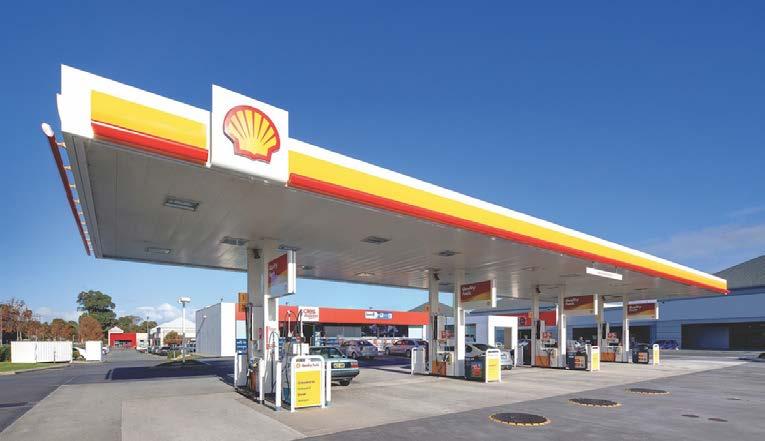
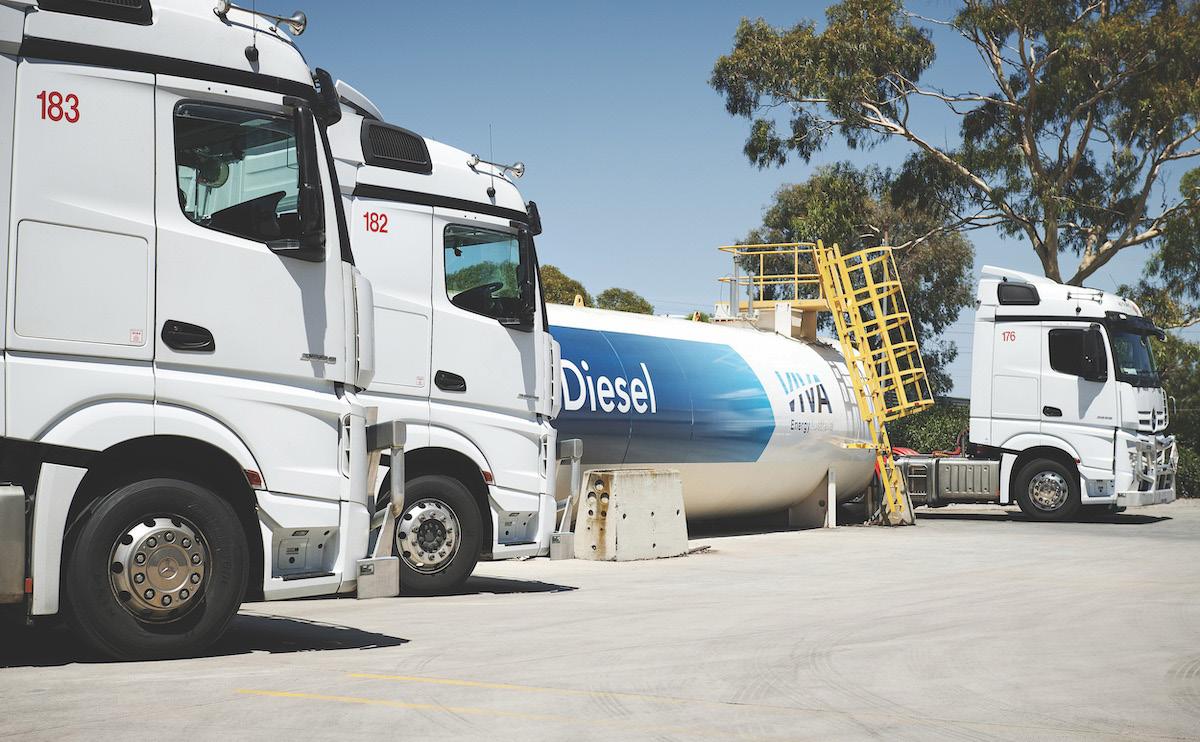
according to Mairead.
“They’re not having to invest in new trucks, they’re not having to invest in new storage,” she explains. “So, it allows them to make a more cost-effective change to reduce their emissions. We think it will be a progressive change that will happen rather than a massive switch straight to hydrogen. But there’s a long way to go. I think we’ll be selling diesel for a while.”
Viva Energy’s Geelong Energy Hub, where hydrogen will be part of the public offering, opens next year. There will be a number of hydrogen-powered heavy vehicles due to be deployed within the rst two years of operations, with signi cant scope to expand further as the commercial opportunity is proven. The Geelong service station will also include diesel refuelling and electric vehicle charging, making it clear that in future the market, going forward, won’t rely on any one de nitive solution but rather a mix of different energy offerings. Viva Energy’s retail footprint is growing having purchased the Coles convenience network for $300
million last September and more recently concluded the $1.15 billion acquisition of On the Run. Its number of truck-friendly sites is also growing.
“We’re investing a lot in our network and with that growing network our ability to supply transporters with an end-to-end retail solution with several requirements,” says Mairead. “From a trucking point of view, I think having full control gives us a lot more exibility in terms of the offer that we can do instore. I think there are improvements that we can roll out in terms of hot food availability, particularly for truckies and potentially being able to build more truck friendly sites especially in some more regional areas.”
Along with its purchase of the Coles Express convenience retailing business, Viva Energy has added an extra level of diversi cation in its plan to establish more than 1,000 stores across Australia.
Viva Energy will have the largest companycontrolled convenience retail network which in turn enables it to expand its offering and deliver signi cant upside for
customers instore. In addition to providing facelifts to a few sites, there are plans in place to roll out new trucking facilities, new showers, and new food offerings. From a passenger car standpoint there is going to be considerable investment in more EV charging stations. In NSW, a minimum of four ultra-fast charge points have been proposed at each of its EV sites to help minimise wait times for drivers and ensure maximum charger availability. There are several advantages, given the changing pro le of service stations, to controlling the retail network.
“It’s broadly acknowledged over time that the mix of passenger vehicles will move towards electric vehicles,” says Mairead.
“That means longer dwell time on the forecourt. It takes longer to recharge than it does to pump petrol so I think our having control of an extensive retail network now allows us really to invest in that instore experience and build a convenience offer so customers can get what they want when they’re there and when the cars are charging.”

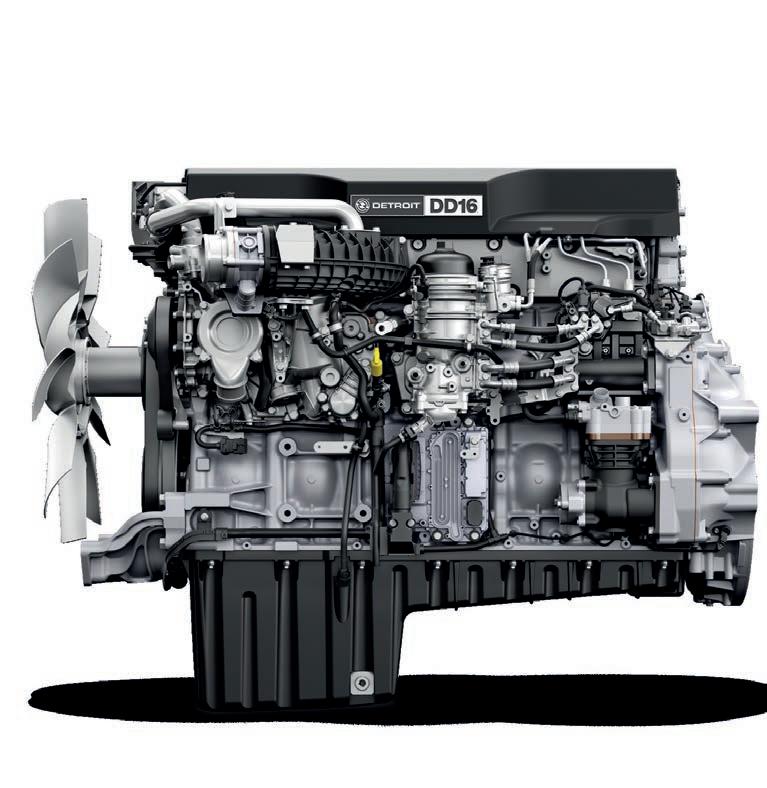
500-600 HORSEPOWER
,850-2
1,850-2 ,050
lb-ft @ 975RPM
Extreme duty and heavy hauling for your biggest jobs
Detroit’s most powerful truck engine ever, the DD16 boasts up to 600 horsepower and 2,050 lb-ft of torque. The big bore workhorse provides efficient and dependable power and performance without compromise.
Advanced combustion and aftertreatment technology exceed future emissions requirements whilst retaining exceptional fuel efficiency and uptime.
This power, performance, and efficiency are backed by the most comprehensive warranty and extended coverage packages, ensuring the highest level of support for our customers.
When you buy a Detroit product, you’re buying billions of miles of engineering excellence. Tried and true, Detroit engines are built to ride the roughest roads.
With Detroit, there’s no compromise. @ 1,800 RPM


DHL Supply Chain Australia is supporting its customers’ growth and the safety requirements of drivers and other road users while pursuing its environmental objectives with its evolving, stateof-the-art truck eet.
Managing Australian supply chains for global and Australian businesses in retail, technology and life sciences, manufacturing and healthcare sectors for more than 20 years, DHL is renowned for its global scale and innovations in supply chain management. Recent examples include the implementation of goods-toperson robots for increased ef ciency in warehouses and voluntarily setting ambitious sustainability targets.
The company’s vehicle eet is an essential part of DHL Supply Chain’s Australian operations, which is evolving to become more technology-laden and capable of meeting the company’s sustainability goals and customer needs. DHL’s growth since entry to the Australian supply chain landscape in 2003 has demanded a rapidly expanding road eet, culminating in the company’s acquisition of the Glen Cameron Group in 2022.
The acquisition, according to Bill Rolfe, Senior Vice President for Transport at DHL Supply Chain ANZ, has given the company additional eet capacity, which complements its ability to provide freight solutions across all Australian states and territories.
“We’re now exploring all vehicle options in the market as we evolve our eet for the future,” he says.
The local DHL vehicle eet, which is made up of everything from linehaul trucks, medium and light duty trucks to vans, is crucial in moving goods to and from its Australia-wide warehouse network and through to the nal links of supply chains on behalf of its customers.
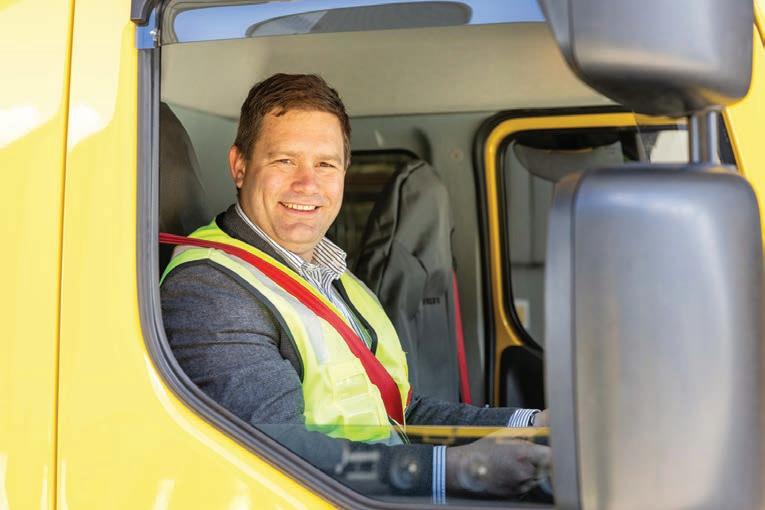
It includes vehicles from Scania and Volvo, as well as other brands including Freightliner, Isuzu, UD and DAF and is stringently managed for safety and reliability.
“Our transport team understands that the range of truck suppliers operating in Australia brings opportunities to procure vehicles with speci c capabilities and qualities,” says Bill. “While we maintain strong relationships with many suppliers, DHL operates a tender process for procuring new vehicles and does not have preferred suppliers for particular models.”
An experienced team ensures that the eet is managed to provide safe and reliable services for customers across Australia interstate and locally. Fleet management systems are used to ensure maintenance is completed when required, by certi ed specialists. To maintain the exibility required for the
needs of major contracted customers and short-notice transport requests, the DHL eet is tted with the latest telematics systems.
The long haul eet is also tted with fatigue monitoring systems.
The supply chain shake-ups caused by the COVID pandemic and other recent world events caused minor delays with DHL’s vehicle procurement. However, these circumstances also helped the company to determine different methods for procuring the vehicles required to scale to the needs of its customers.
“The pandemic increased the cost and reduced the availability of vehicles and we have bene tted from the experience of managing this situation by increasing its use of rentals in vehicle procurement,” explains Bill.
“The exibility of rental vehicles is another way we can better serve our customers, regardless of market and
supply conditions.”
DHL’s eet management team understands the factors involved in maintaining and turning over vehicles to optimise reliability, provide its drivers with up-to-date safety technology and minimise environmental burdens caused by running technology past its prime for emissions or economy.
“We operate on a case-by-case basis for each make and model in our eet, with our staff and customers’ requirements at the heart of our eet management decisions,” says Bill. “Many of our vehicles are replaced on an average of ve to eight years depending on customer requirements, new safety and environmental innovations and manufacturers’ recommendations.”
DHL’s newly launched global Green Transport Policy, which has become the company’s model for eet updates, mandates the uptake of greener vehicle alternatives when procuring vehicles.
The most recent additions to DHL’s eet – a Volvo FL Electric, Terberg YT200EV yard tractors and an SEA Electric 300-85 EV light-duty truck – are signi cant to the company’s environmental objectives. These vehicles represent the company’s Australian foray into electric trucks, which will continue to grow the eet and replace retiring vehicles as it works to meet its target of 60 per cent EVs for last mile deliveries. DHL was also the rst Australian company to t ‘engineless’ Carrier T30 ECO-DRIVE units to power refrigeration units on its prime mover eet.
The Volvo FL Electric combines a 600-volt motor with a two-speed transmission to deliver a 5,500kg payload. Its regenerative braking system and transmission top up the FL’s batteries every time it decelerates, giving it a 300-kilometre range. The SEA Electric light duty truck is assembled locally with an Australian designed electric driveline using a simple inboard mounted battery design that requires no thermal cooling, for reduced maintenance.
The Terberg tractors are equipped with Next Generation LFP (cobalt
free) batteries and feature a 240kW traction motor capable of towing up to 88 tonnes.
“DHL began its EV journey with the purchase of a Volvo FL because we understood it was a safe and effective way to begin the journey of transitioning 2,000 of our vehicles globally to greener alternatives,” says Bill. “While the Volvo FL Electric is still new to the eet and is undergoing performance benchmarking for Australia, the knowledge we gained from DHL’s experience with the Volvo Electric line in Europe helped with the decision to add it to the eet without the
trials many companies are conducting with EVs in Australia.”
He adds, “We’re pleased to be investing in Australian-made EV technology with our SEA Electric truck, which gives us another option to compare to the Volvo.” DHL also saw a further opportunity to reduce its emissions in a less visible part of its transport operations, using the Terberg tractors to manoeuvre trailers into position for one of its retail customers. It would appear, however, that this is just the tip of the iceberg. “There will be more to come in this space shortly,” says Bill.


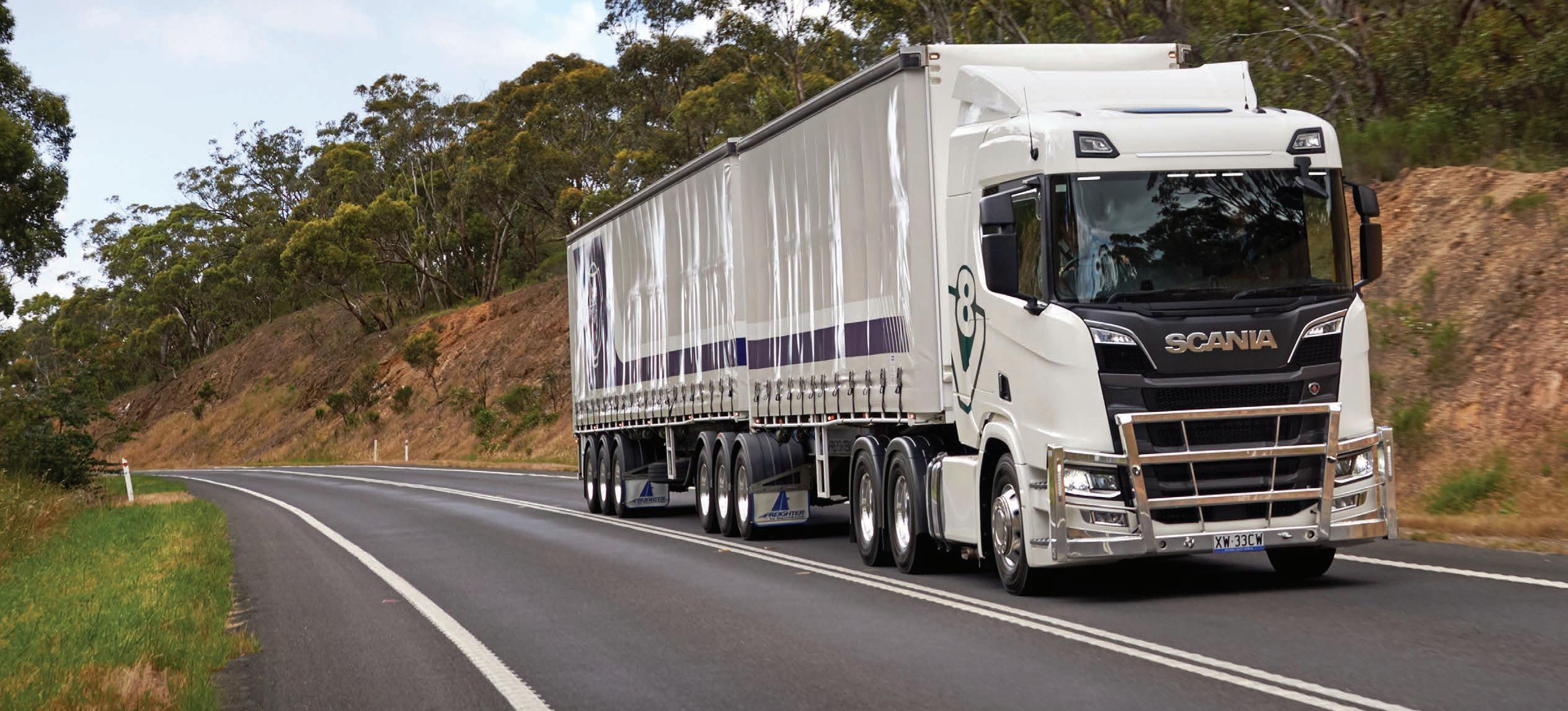
Scania boasts solutions for customers serious about making a signi cant change to their CO2 emissions pro le.
Electri cation is an increasingly important tool for making transport more sustainable, but it cannot achieve the necessary decarbonisation alone. Sustainable biofuels are often both a cost and CO2 ef cient solution — and sometimes the only viable option for some transport applications and markets.
“Scania develops and provides the largest portfolio of engines on the market that can run on alternatives to fossil fuels, such as biodiesel, HVO and lique ed or compressed biogas,”
says Alexander Corne, Scania Australia spokesman. “All of our Euro 6 engines can run on Hydrotreated Vegetable Oil (HVO), while many of our trucks can run on biodiesel. We have developed this portfolio over the course of the past 25 years.”
In the transport sector, biofuels can make an almost instant contribution to decarbonisation. According to a recent study by the Stockholm Environmental Institute, biofuels are vital for decarbonising heavy-duty transport over the next decades, both for new and
existing eets.
The reduction in CO2 emissions will vary depending on fuel quality, as well as different driving environments and applications, which is why Scania quali es its positioning statements by saying a particular renewable fuel can ‘reduce CO2 compared to diesel, from a well-to-wheel perspective,’ by a certain amount.
Generally speaking, Scania expects its engines running on renewable fuels to provide the following reduction in CO2 emissions:

• Biodiesel: 50-80 per cent, typically 60 per cent
• HVO: 50-90 per cent, typically 83 per cent when using waste-based feedstock
• Biogas (methane): 50-90 per cent, typically 80 per cent
HVO can be made from different sources — such as waste oil, rape seed oil, waste cooking oil and animal fat waste. Using these sources of energy has a great impact on the total greenhouse gas savings, according to Scania. “We have the technology on hand
for customers who want to run their vehicles on HVO, although it is true to say that most HVO available in Australia at present is imported,” Alexander says. “On the other hand, we have a good supply and access to biodiesel, which is made in Australia and can offer in addition to emissions reduction, a sense of fuel security, reducing our reliance on imported fuel.”
Many current generation Scania engines can run on 100 per cent biodiesel (B100), up to and including the 590hp 16.4-litre V8 engine, and all
2024-model year engines can run on B10, a 10 per cent blend of biodiesel and regular diesel.
“Scania has the solutions if customers are serious about making a signi cant change to their CO2 emissions pro le. While we understand there is a lot of excitement surrounding the adoption of battery electric propulsion, its suitability for the wide range of applications we have in Australia will evolve over time,” adds Alexander. “Certainly biodiesel is a solution that is ready to go right now, and HVO equally can work too.”
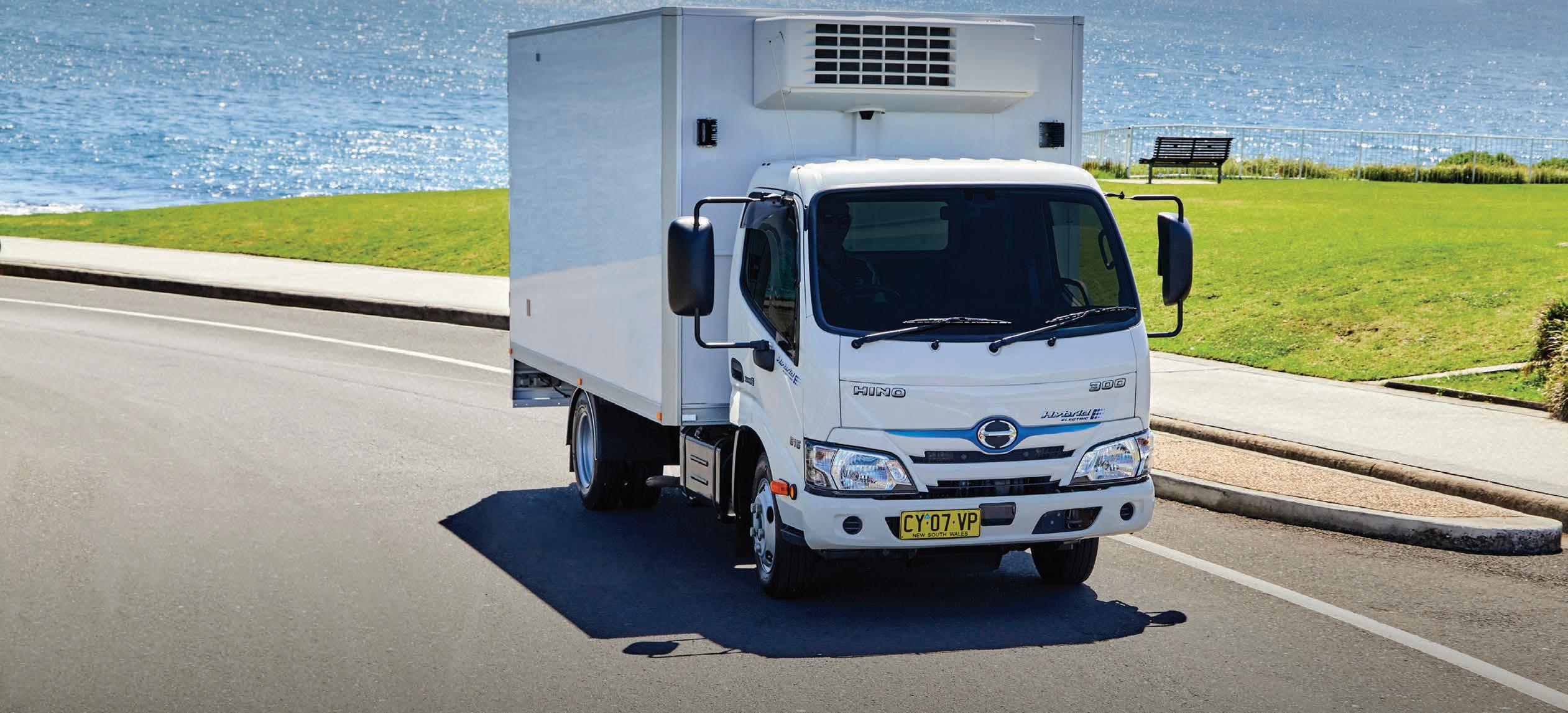
Hino’s Hybrid Electric truck continues to deliver savings for customers.
Australia’s only Hybrid Electric truck is made by Hino. The OEM’s ongoing transition to manufacture low and zero emissions vehicles for Australia has been spurred on by the momentum of last year’s Hybrid Electric delivery sales record according to newly appointed President and CEO of Hino Australia, Richard Emery. “Since I started with Hino two years ago, our focus has been rmly on relaunching and rebranding the 300 Series Hybrid
Electric, which has been delivering savings to Hino customers for over 15 years,” he says. “We are con dent that 2024 will be another record year as we see interest from customers growing in increasingly varied applications.”
The Hybrid Electric continues to be a popular choice for customers in the freight, logistics and delivery sectors, and is increasing in popularity with customers in the urban delivery, traf c management and trade markets with the Built-to-
Go products. Last year, national rental company Sixt added Hybrid Electrics to its eet.
“We are currently purpose-building two Hybrid Electric tilt tray trucks, which will be Of cial Recovery Vehicles at selected rounds of Repco Supercars Championship as part of our sponsorship,” says Emery. The tilt trays, for that matter, aren’t limited to the racetrack with loyal Hino customer Nationwide Towing adding a number of Hybrid Electric tilt trays to its

eet over the last year.
Nor is Hino resting on its laurels with more alternate fuel options expected to be available for its customers in the coming years.
“Looking to the future, we are working with Hino Motors Ltd to determine the feasibility of adding a tipper to our Hybrid Electric Built-to-Go range, which currently includes the Alloy Tray and TradeAce variants,” explains Emery.
“Feedback from our landscaping customers is that a Hybrid Electric Tipper would be well-suited to the urban stop-
start nature of their role.”
Beyond that, Hino is also investigating the possibility of trialling a 700 Series Hybrid Electric in Australia in the next 1218 months.
“All Hino 300 Series Hybrid Electric models meet Euro 6 exhaust emissions standards, and a Prime Mover real-world trial comparing it against a traditional diesel equivalent revealed a 28 per cent reduction in fuel use and CO2 emissions,” says Emery. “The level of savings are dependent on the application of the vehicle and how it is driven.”
Hybrid Electric customers also bene t from a reduction in maintenance costs as the electric motor replaces the diesel engine’s starter motor and alternator, and the regenerative braking reduces the use of service brakes and increases the life of the brakes, all while charging the hybrid batteries.
“This can reduce yearly maintenance costs by up to 16 per cent,” says Emery.
The Hino 300 Series Hybrid Electric is at Hino dealerships nationwide, with more information including a savings calculator available at www.hino.com.au.
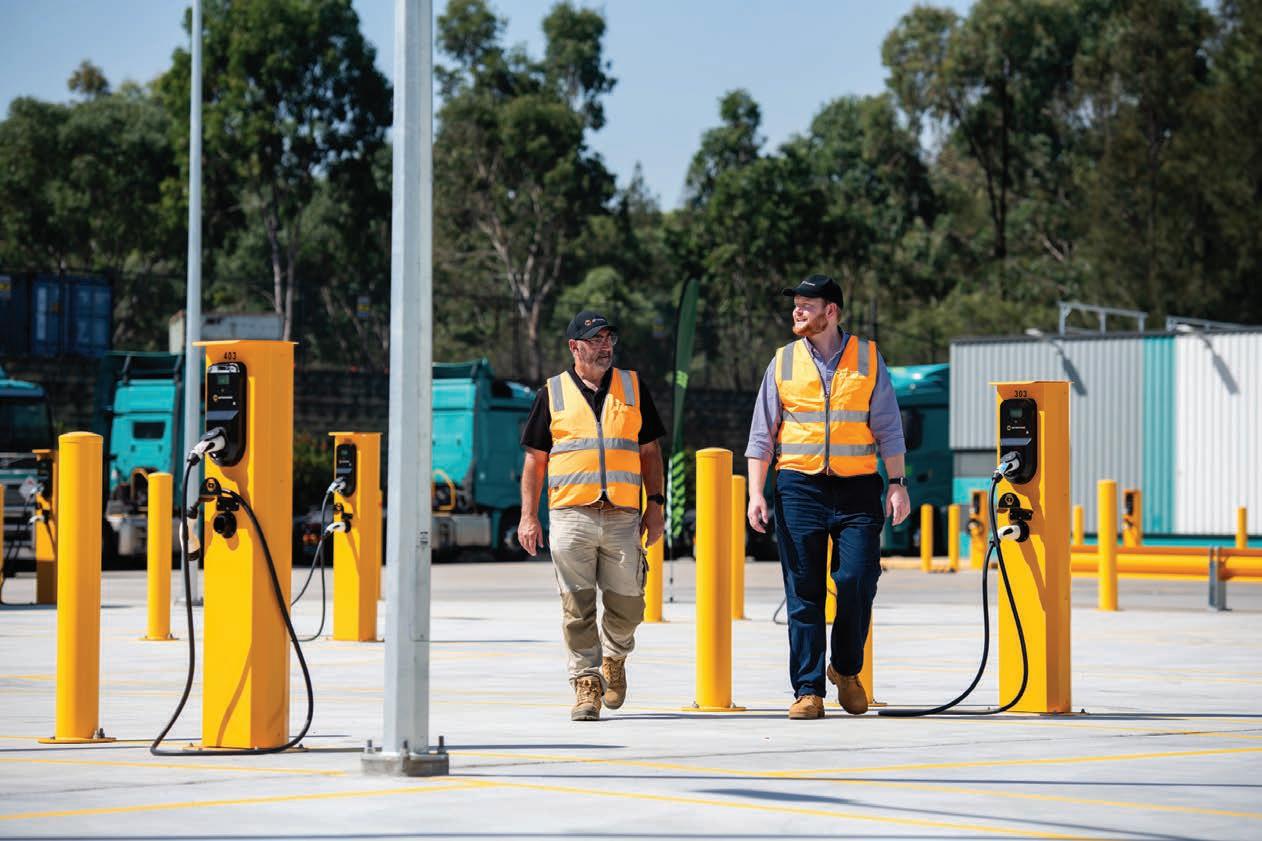
While a number of companies have been trialling small electric trucks for local delivery work, there hasn’t yet to be any largescale transformation projects within the industry. Until now. Team Global Express, one of the biggest last mile and express logistics providers in the country, has, as part of the Australian Renewable Energy Agency’s Driving the Nation Fund, unveiled 43 out of the total 60 electric trucks alongside a comprehensive charging infrastructure at the company’s Bungarribee depot in Western Sydney. The launch event gathered together dignitaries from across the globe including the Australian Prime Minister.
Recognised as the biggest logistics transition project within the country, the $44 million undertaking sets a new benchmark for the transport industry and
showcases a huge leap in infrastructure capability.
JET Charge, Australia’s leading EV charging infrastructure and technology company, has partnered with Team Global Express to provide the innovative charging solutions for the 36 Volvo Electric FL units and 24 Fuso eCanters that the eet has invested in to help reduce its Scope 1 emissions.
“We are thrilled to contribute to what is undoubtedly a landmark project in the logistics sector – not just for JET Charge, but for the entire country,” says JET Charge CEO Tim Washington.
The battery electric eet required new charging infrastructure at the depot. All of which had to be built from scratch as part of the enterprise. It was a mammoth task and not just in installing the chargers, but also the upstream design, electrical, communications, management and optimisation work required to make the
site run smoothly.
From the very beginning, JET Charge was involved in various stages of the project, including concept design and planning, a signi cant input into the nal design’s ef ciency and effectiveness, charger supply tailored to the project’s needs, t-off commissioning to ensure all systems were correctly installed and operational, ongoing maintenance and support, and dashboard monitoring and reporting.
Underpinning the design was JET Charge’s advanced energy management system, JET Charge CORE, which allows the project to use existing electrical infrastructure without the need for a new high voltage connection. This means charging can operate around the use of existing on-site equipment, preventing tripping at the site.
“The JET Charge CORE system allows energy to be intelligently controlled within the site,” says Alex Bowler, the JET Charge
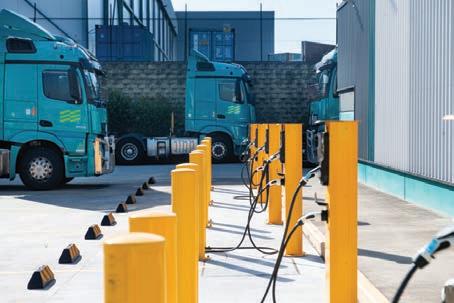
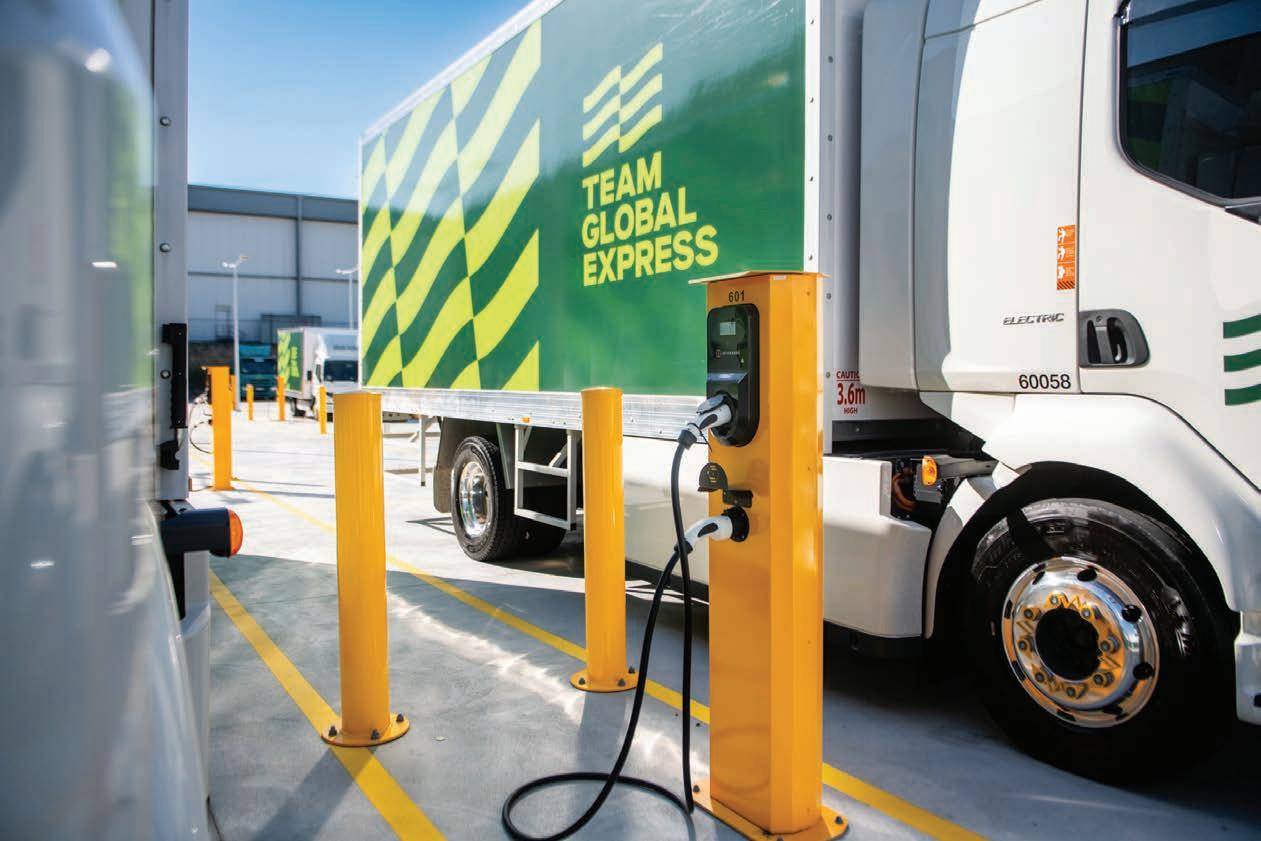

Sector Leader of Bus and Heavy Vehicles.
“The Bungarribee depot wasn’t designed or built to power electric vehicles. Our load management system, which uses adaptive technology to draw on spare power when it’s not being used by the depot’s core functions like conveyor belts, for instance, has enabled more charging capacity at the site without triggering expensive upgrades.”
The pioneering design approach combines both AC and DC charging systems, serving as a model for future projects. In total JET Charge has provided 49 JET Charge AC Chargemate units equipped with pedestals, all manufactured in Australia; and two 400kW Kempower DC chargers each with eight CCS2 charging satellites for rapid charging.
JET Charge has drawn on over ten years of experience and internal expertise while it helped solve the inevitable challenges that accompany such a ground-breaking process. Part of that same process has involved troubleshooting, deploying
quick- x patches and working closely with stakeholders to resolve any other issues that have arisen, to ensure the undertaking is as smooth as possible.
A recently announced North Star project for the entire logistics industry is one of the resultant outcomes of this fertile collaboration with Team Global Express, Volvo, Fuso, MTA Energy, Centech, Goodman and many other project stakeholders. The project aims to illuminate the path forward for freight carriers and transporters to a greener, cleaner future of eet transformation.
“The Team Global Express depot’s stateof-the-art charging infrastructure doesn’t only improve operational ef ciency it also sets a new standard for environmental stewardship in logistics,” Tim says. “JET Charge’s dedication to conceptual design, energy management, and advanced technological integration has been instrumental in realising this vision. We believe this project will generate many
learnings to inform future projects., marking a signi cant step towards a greener, electric future.”
While the project is currently one-of-akind, Alex hopes it won’t stay that way for long, and he – for one – is raring and ready to help create tailored charging solutions for other companies wanting to spearhead the electric transition. “Now we know what large-scale eet transition can look like, we can replicate this for other eet operators, whether they’re after front-to-back commercial charging services, or more speci c tailored solutions. This project is rst class, and we can’t wait to do it again.” For eets presently considering the transition from diesel to electric vehicles, and who might be actively looking to electrify their depot, JET Charge extends an invitation to get in contact. The team is ready to assist in making a smooth and ef cient shift towards an electric future. The electri cation journey begins here jetcharge.com.au.
Rachel Smith has been in the role of CEO of the Australian Livestock and Rural Transport Association (ALRTA) since August 2023.
Rachel Smith started her career in recruitment and moved to the association management space when she relocated to Canberra over 11 years ago. Rachel worked for one of the most powerful lobby groups in Australia, the 6,000-member Pharmacy Guild, and moved on to her involvement with transport associations as Head of Government and Policy at the Australian Logistics Council (ALC) where she also served for a time as interim CEO. Rachel has expertise in policy and government relations, member services and operations management.
Prime Mover: It could be said ALC and the ALRTA are at different ends of the transport spectrum. What sort of challenges do they have that are common?
Rachel Smith: They’ll both be across the transport sector regardless of the mode, in terms of how we get interconnectivity and the productivity uplift, and part of that is through sensible investment in infrastructure. The whole transport sector, regardless of size of any entity or mode, is suffering from skill shortages and the challenge is how do we attract more females and diverse work groups into the sector and skill them to suit Australian conditions. There are still challenges around how do we meet the decarbonisation agenda and also how do we continually improve safety outcomes for drivers.
to the fore of discussions. Is that a conscious approach?
RS: There are unique challenges between rural and regional settings, and urban and metro settings. Australia is the most urbanised country in the world, with around 90 per cent of our population living in the cities on the eastern seaboard, so by nature a lot of public policy is very urban-centric. Australia has some unique challenges

CEO.
PM: Rural transport associations have brought transport decarbonisation
in terms of its size. There’s not a lot happening in the centre of the country and the distances we travel are very different to overseas countries. Even when you look at the United States and other very populated countries that are large in area, we don’t have our population spread evenly across our country so we have some very unique challenges. Often when we talk about decarbonisation it’s pinned to examples
like Norway and Finland and the EU which are all very densely populated yet they’re relatively small countries. So some of the various decarbonisation solutions might work in those environments but in Australia we are more spread out and we travel longer distances. So for us, we’re electrifying the network for cars and light vehicles but the reality is you can’t take a roadtrain from Darwin to Adelaide using electricity at the moment. We just don’t currently have the technology to meet the large heavy duty freight task in Australia.
PM: Given that situation, should rural and remote transport be treated differently by government?
RS: Rural and regional transport in Australia is unique but there needs to be some different focus on how we decarbonise it and I think some investment in other technologies that aren’t based on electri cation needs to occur. At the moment what we are seeing is the government is not being technology agnostic in terms of where their investment goes. We heard at the recent ALRTA conference in Toowoomba there are some great leaps and bounds happening in biofuels and renewable diesel, both of which would be able to be run in existing internal combustion engines, but we are not seeing a lot of government investment in those technologies. We recently saw the United States walk back from their 2030 emissions targets because it was going to be too expensive for manufacturers and consumers.
PM: What other challenges will be facing rural transport in the coming ve or ten years?
RS: I think we are going to see further pressures on the workforce and attracting people to the industry, and some of that is driven by lack of housing in regional areas. I have a member who has actually bought a unit block so he can attract staff to work for him, because there was such a shortage of affordable housing in the area in which he operates. We have members who are sponsoring overseas mechanics and they also want to get some drivers. Due to the shortage of truck drivers at the moment, as part of employing someone under a skilled worker visa you need to pay them a minimum amount of salary but there also needs to be a guarantee they can access suitable housing.
PM: During the pandemic, for too short a time, the general public were very supportive of what the transport industry was doing for them. Do you think all that goodwill has now evaporated?
RS: Unfortunately, yes. The public has a very short attention span. One of the few good things of the pandemic was people could now understand what a supply chain is. There is a better understanding of just how integral the transport industry is, but I think the value that was placed on truck drivers, in particular, has diminished. We’re not seeing a lot of parents who support kids who say, ‘I want to be a truck driver’ when in reality they could have a very long and successful career in the industry. You might start on the tools or in the truck and then go on to a management position whether its compliance, or operations, or training. There are lots
of options there. The question is how do we bring back to the forefront the conversations we were having about truck drivers and transport we had in the pandemic?
PM: Is regional transport an attractive proposition for operators and workers?
RS: The nature of the people in the industry in the ‘bush’ is they want to run a good business, they want to give
back to their community, and they want to look after their staff. They require someone competent to drive a very expensive piece of machinery with a very valuable load. One of the challenges transport faces as a whole is people don’t see it as a skilled workforce, when in fact the drivers are highly skilled and their goal is to ultimately get their load where it needs to go safely and ef ciently and then to get back home to their family safely.
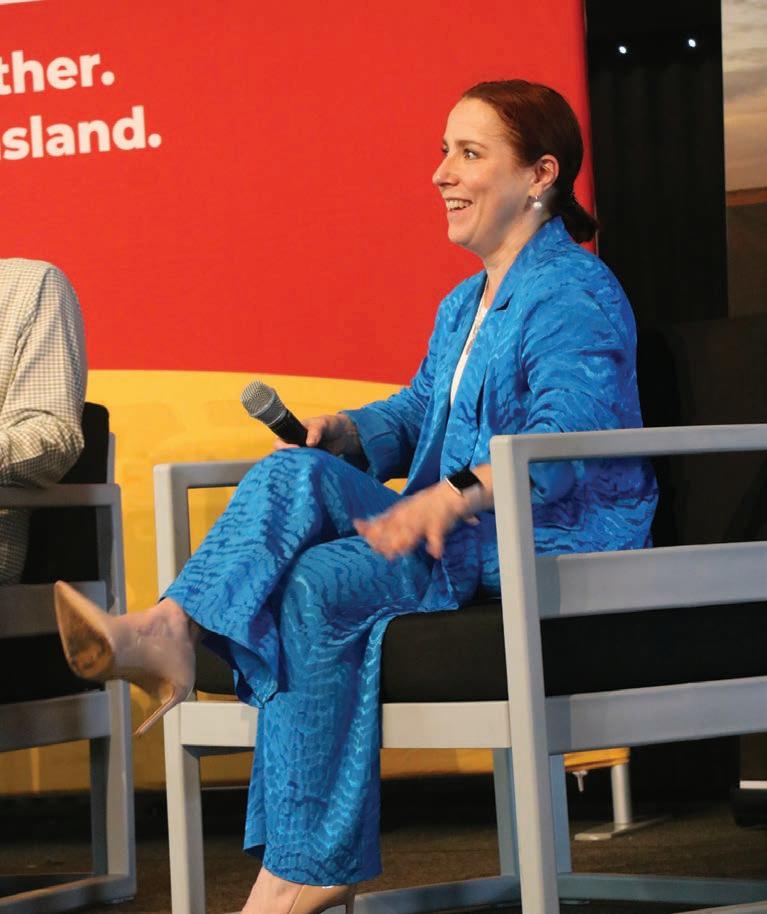
Alan Pincott is the public face of the innovative industry program HVRAP – the Heavy Vehicle Rollover Awareness Program.
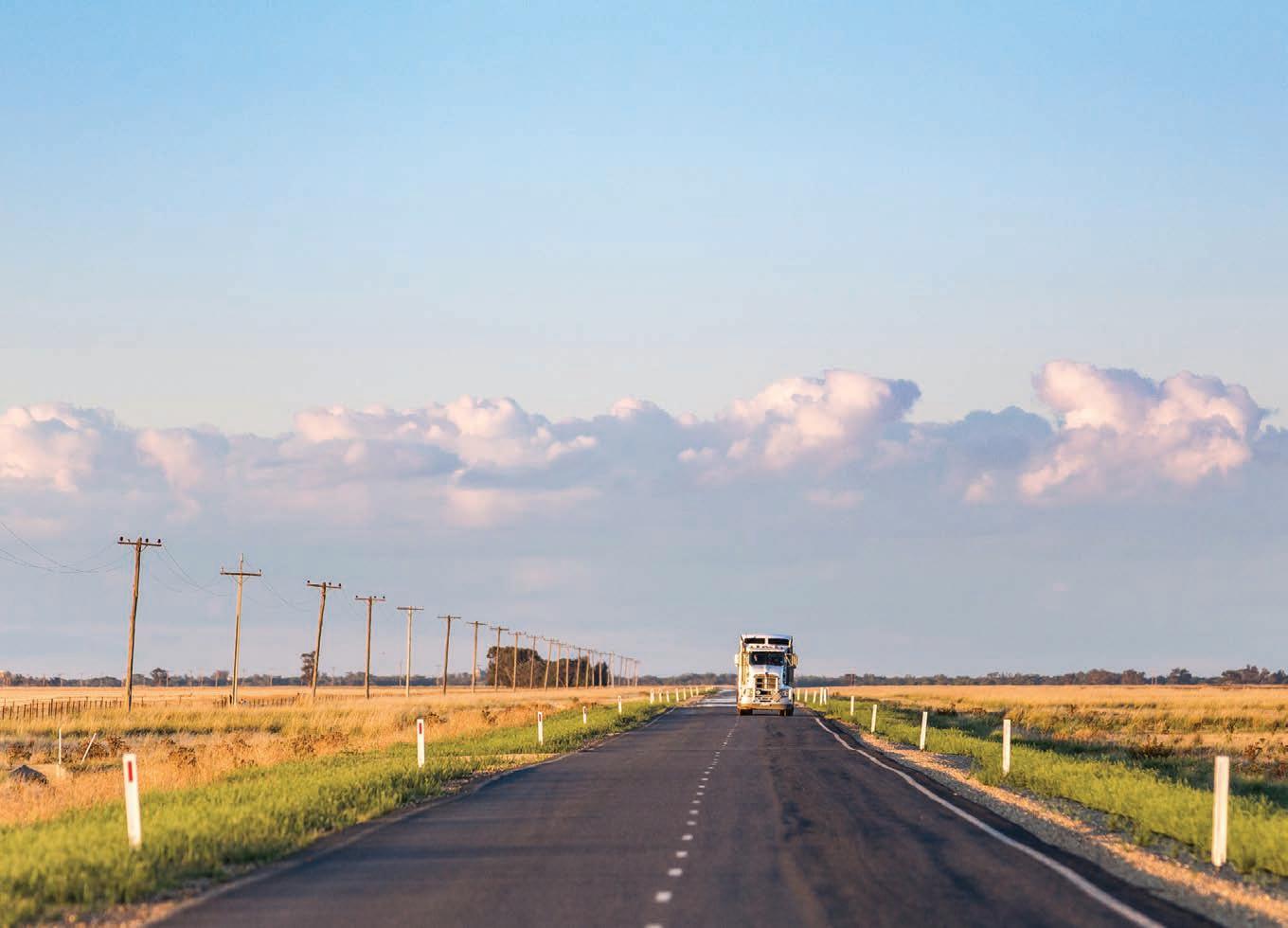
Alan Pincott was destined to be involved in trucking as his father and grandfather both operated logging trucks, and Alan commenced his own career as a heavy vehicle mechanic who went on to become a driver, instructor and heavy vehicle licence tester and spent 18 years with VicRoads.
“I went to a lot of rollovers, and I have been working hard to reduce rollovers since 2005, both in my role as a VicRoads heavy vehicle Regulation Of cer, and as an independent consultant to industry since 2016,” he says. “My main focus has been logging and timber products, but we have worked with many other sectors and the generic message is the same for all sectors of the industry.”
It was while working with Victorian Forestry that Alan realised the true extent of the truck rollover situation.
“We had a spate of rollovers, and in of a eet of 220 trucks salvaging bush re wood, we rolled 16 in six months,” recalls Pincott. Using his
mantra of “you can’t control what you don’t understand,” Alan lead detailed investigations into the incidents which resulted in the formulation of an initial prevention program which was run for 220 drivers, plus loaders, operators, and enforcement of cers.
Starting with 200 anonymous crash reports, Alan, and those assisting him, were able to work out what was happening in the lead up to rollovers, as well as trends with different vehicles, loads, even the time of day a rollover occurred. By involving people right through the transport chain, during the following six months there were remarkably no rollovers in the eet. “We investigated because we were trying to gure out what was going on,” Alan says. “Back then we really didn’t understand the problem. An experienced investigator can look at the marks on the road, the road characteristics, vehicle, load, and recreate the crash using mathematical equations with factors such as centre of gravity, centrifugal force and dynamic load. Speed has a squaring
effect on centrifugal force (CF). If you double the speed, the CF increases by four times. We learned most guys aren’t breaking the law when they roll over, they just get it wrong on the day. If everybody understands what’s happening and why, and they all work together along the transport chain and beyond, we can have some great outcomes.”
In recognition of his work Alan was awarded VicRoads’ Highest Outstanding Achievement award in 2015. He has delivered more than 1,000 face-to-face training sessions across Australia and the HVRAP program has already proved very successful, with signi cant reductions in rollovers and crashes for those who have participated. During COVID, Alan and his team were unable to deliver the in person sessions and this highlighted the need for an online resource.
“There were cases where drivers who had not participated in the program because of COVID restrictions, rolled trucks,” he says. “This gave us all a sense of frustration.”
Leaving the restrictions effected by

COVID behind, the LBRCA and Alan now makes the most of the opportunities to introduce the program to a wider industry audience.
“The great part of working with the transport industries in Australia, is that every time I deliver a program, I will learn something from the attendees that we can use in the future,” explains Alan. “I always say, ‘I just have the privilege of running the program, the content comes from you guys. You do the job — you are the experts.’”
The initial good results encouraged Alan to look to take the program beyond the Gippsland forests and he found strong support from Bec Coleman, CEO of the Livestock and Bulk Rural Carriers Association (LBRCA) and its President, Wade Lewis, and they have partnered since 2022 to develop and deliver the HVRAP.
“The LBRCA were keen to become more involved in the program’s delivery and suggested Heavy Vehicle Safety Initiative (HVSI) funding through the NHVR and making the program accessible and free to all,” says HVRAP Program Director, Bec Coleman. “An online approach was considered the most ef cient way to achieve this and as engagement by all parties is the proven key to success.”
They involved as many people in the industry as possible in order to get the content and approach right. In turn, it gave them a sense of ownership, therefore ensuring engagement.”
Bec adds, “LBRCA members have been very willing to share their experience, knowledge and skills.”
Bec worked with operators including Jim Reardon, Brian Smith and Kel Baxter who have participated in the production of the program’s modules which included video presentations. There are 12 modules in the generic program plus speci c modules have been developed across such transport sectors as fertiliser, grains, hay, fodder and wood chips with others such as concrete agitators under consideration. Subjects include what happens when a truck rolls over and why, the contributing factors, the forces involved, and factors such as loading and
driver behaviour.
The program, according to Bec, is not intended to replace face-to-face training.
“It will be a very good induction resource and aid to operators and trainers,” she says. Her background in education ensures that the learning themes will suit the audience. Making the program free to all users will help to encourage industry continue to keenly assist with the development of the program into the future.
“When it comes to business, we are all competitors, when it comes to safety, we should all work as one,” says Alan. “Individually we know a lot, collectively we know much more”.
Bec was keen to go an extra step so that she might better understand the crashes in the industry. She decided to incorporate a crash information tool.
“We are encouraging people in the LBRCA and beyond, when they have a crash or even a near miss, to use this tool to provide information,” she says.
“We don’t want to know the company or the driver, but we want to build up a good pro le of what these crashes are, including where, why, and how. This road crash information has the potential to get some important data not only from LBRCA members but right across the whole industry in Australia.”
Prime movers are typically very stable, much like a car and are actually hard to tip over. But connecting to one or more trailers signi cantly changes the dynamics of the combinations. Modern technologies such as Electronic Stability Control can lead drivers to become too reliant on the truck getting them out of trouble according to Alan.
“A driver needs to understand what their centre of gravity is, if they don’t, they’ve got no hope out on the road and won’t know what speed to drive at,” he says. “If they’re not sure they should treat it as the worst load there is and drive accordingly. Just because you’re legal, doesn’t mean you can’t do it better.”
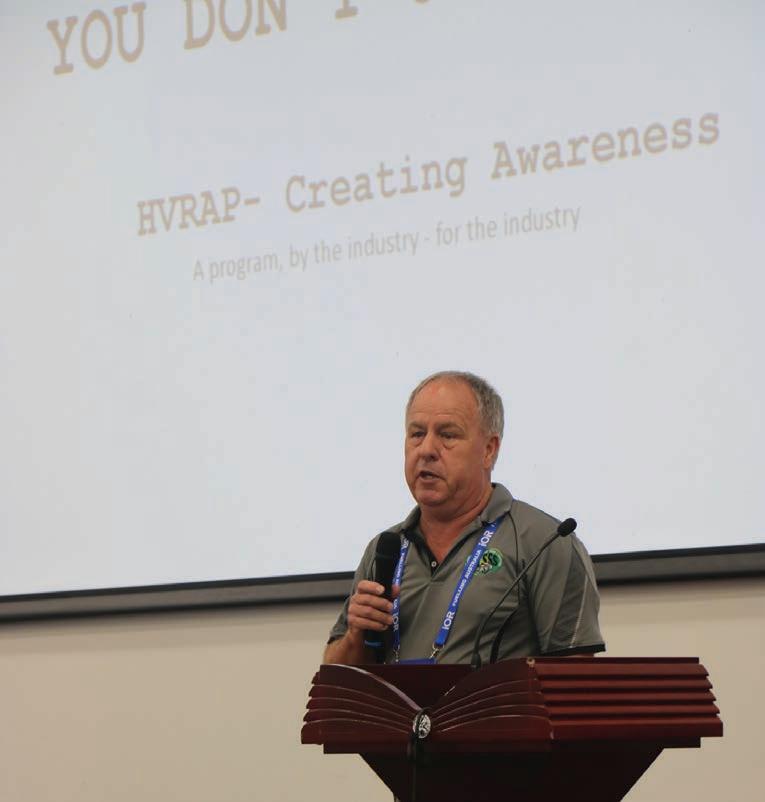
DEPT///PM>0524 ARTSA column | Insight
HEAD///A plan to reduce greenhouse emissions by 2030
BODY///The road transport logistics sector needs a plan to substantially reduce greenhouse gas emissions by 2030. Substantial voluntary greenhouse gas reduction would benefit the sector by helping to reduce operating costs and make it less vulnerable to government policy changes that are likely to force substantial reductions anyway. It is always better to plan for change than to complain about it when it hits.

In 2022, Australia legislated to set a greenhouse gas emission goal of 43 per cent below 2005 levels. It is improbable that the Federal Government will exclude road transport from its plans to reach this goal. State governments control in-service vehicles, but not the excise on diesel fuel. The main lever that the Federal Government has to reduce the almost total dependence of the road transport sector on diesel, is via excise tax level and by amending the fuel tax rebate policy (which currently allows operators to claim a 20C/litre rebate plus the GST). The road transport sector needs a plan to convince government that it is doing its bit to reduce greenhouse gas emissions and pocket some savings.
n 2022 Australia legislated a greenhouse gas emission goal of 43 per cent below 2005 levels by 2030 – only six years away! It is improbable that the Federal Government will exclude road transport from its plans to reach this goal. Substantial voluntary greenhouse gas reduction would bene t the sector by helping to reduce operating costs and make it less vulnerable to government policy changes that are likely to force substantial reductions anyway. It is always better to plan for change than to complain about it when it hits! The road freight transport sector uses about 85 per cent of Australia’s diesel fuel. That is because diesel is the
most perfect fuel for trucks, except for its greenhouse gas emissions. The predicted greenhouse gas emissions trajectory of four classi cations of vehicles is shown in Figure 1. The projections show growth in fuel usage for articulated trucks and rigid trucks over the next six years. As the median age of the heavy vehicle motor eet continues to increase, there is no prospect that alternative fuel technologies becoming available for new motor trucks will make any signi cant difference to the total use of diesel fuel by heavy vehicles in the next six years. Therefore, changing the trajectories in Figure 1 requires us to focus on how to reduce fuel usage by
in-service heavy vehicles. Articulated trucks carry the most freight, travel the longest distances, have the highest fuel usage per truck type yet make up the smallest proportion of motor truck vehicles. The effort to improve fuel economy in the road freight transport sector should focus on articulated freight vehicles because they use the most diesel fuel and there are fewer of them compared to rigid freight trucks.
The road freight transport sector uses about 85 per cent of Australia’s diesel fuel. That is because diesel is the most perfect fuel for trucks, except for its greenhouse gas emissions! The predicted greenhouse gas emissions trajectory of four classifications of vehicles is shown in Figure 1. The projections show growth in fuel usage for articulated trucks and rigid trucks over the next six years. We should not under-estimate the technical challenges that will arise to replace diesel as the predominant energy source. These technical challenges will require much more than the six years left between now and 2030. As the median age of the heavy vehicle motor fleet continues to increase, there is no prospect that alternative fuel technologies becoming available for new motor trucks will make any significant difference to the total use of diesel fuel by heavy vehicles in the next six years. Therefore, changing the trajectories in Figure 1 requires us to focus on how to reduce fuel usage by in-service heavy vehicles.
Here is my six-point plan to promote substantial reductions in greenhouse gas emissions by the road freight sector:
1. Promote Fuel Ef ciency –Introduce a new National HV

Figure 1 – Actual and projected growth in transport emissions 1990-2030, indexed against 2005. Source: Australian Energy Alliance - A roadmap to accelerate energy produc7vity in freight transport by 2030, [1] .
Accreditation Scheme (NHVAS) module called Fuel Ef ciency. This module should be based upon the ‘operator module’ in the USA EPA’s Smartway scheme, which is described in Figure 2. Operators can achieve a ranking from Level 5 to Level 1 (best) based upon proven tonne-kilometre fuel economy, and low gaseous emission performance. The purposes would be to promote good practice by Australian operators that reduces costs, provide a reliable ranking that will advantage operators in the marketplace, and identify to the community tangible action by the road transport sector to reduce emissions. Government policies could also favour achievers in the NHVAS Fuel Ef ciency Module. It is beyond industry associations to establish an Australian ‘smartway’, although they could help, and the best place for it, in my opinion, is within the NHVAS.
2. Ensure Trailers Run Full – A national freight scheduling marketplace is needed that facilitates freight sharing between operators to help ll trailers both ways. While freight marketplaces currently exist, none are focused on increasing utilisation of freight vehicles. There are no public statistics I know of that estimate vehicle freight space utilisation. Such information could come from the NHVAS Fuel Ef ciency module mentioned previously. A freight scheduling marketplace could be a useful partner program to the NHVAS Fuel Ef ciency module.
3. Fix the Electric Trailer ProblemFederal and State/Territory governments should urgently sort out how to allow electric drive axles to be legally used on heavy trailers. Under current rules, trailers cannot have driven axles. A new ADR (design rule) will probably be needed, and a new registration category will also be needed. An electric drive axle and battery on each semi-trailer could produce a ‘hybrid’ semi-trailer combination that could improve the fuel economy of the prime mover by
25 per cent, by reducing low-range gear use. Drive axle kits could be retro tted. The control system could utilise existing CAN bus braking signals. Batteries could be charged by retardation-energy, solar panel installations at depots (and on trailers), battery swaps at half-way sites and at electric chargers. Further, an electric trailer could improve safety by providing more balanced tractive effort and non-brake retardation.
4. Incentivise Electric-Drive Trailer Use
- Governments should incentivise the Australian trailer industry to develop electric trailer options. Australia has a substantial trailer manufacturing industry and has more heavy trailers per prime mover than any other country. We are well placed to develop electric trailer technology locally. And become world leaders. Incentives will probably also be needed for operators to uptake electric trailers because of additional weight and cost.
5. Normalise High Productivity
Vehicle Use – The Performance-Based Standards Scheme (PBS) has spurred the uptake of high-productivity freight vehicles. It has given con dence to road agencies and transport ministers that new con gurations can be safely used. In the rst stage, a path for

approval of 4-, 5- and 6-axle tipping dog trailers was created. In the current stage a path for approval of A-doubles and super B-doubles to operate on Level 2B routes has been achieved, as has a path for 20-metre super semitrailers on Level 1 routes. The next stage should be normalisation of these vehicle types in regulations, so they can travel under notice if they meet a speci cation..
6. Introduce a Master Driver
Accreditation – There should be a master driver accreditation to provide a career path for truck drivers, and to promote and recognise excellent driving performance over several years of driving experience. The truck driver can make a 5-10 per cent improvement in fuel economy. Fuel-ef cient driving performance should be one element of this accreditation. Such an accreditation should be developed by an industry association that is focused on individual membership in the road transport sector. The challenge is substantial, and action is needed now. The road transport sector could realistically save $1.5B per annum in 2030.
Dr Peter Hart, Chairman, ARTSA-i

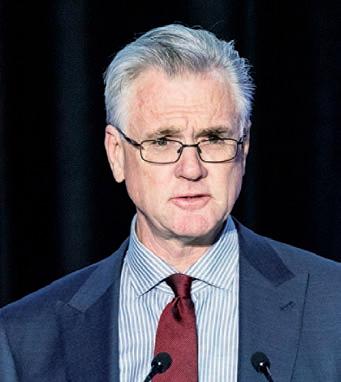 TONY MCMULLAN
TONY MCMULLAN
There has been much discussion regarding the recent announcements by the Minister for Infrastructure, Transport, Regional Development and Local Government, the Hon Catherine King and the Minister for Climate Change and Energy, the Hon Chris Bowen, of light vehicle CO2 mandates as outlined in the Australian Government’s New Vehicle Ef ciency Standard (NVES) Consultation Paper. As I detailed in this column last month, the Consultation Paper was developed jointly by the Department of Climate Change, Energy, the Environment and Water and the Department of Infrastructure, Transport, Regional Development, Communications and the Arts (DoIT). With DoIT taking the lead, the regulation will be implemented as a motor vehicle directive.
While the intent of the Government’s proposed New Vehicle Ef ciency Standard is to improve the CO2 performance of light vehicles, with the Consultation Paper detailed that all vehicle below 3.5t GVM will be captured by the proposed Standard, the Paper also detailed that “some” vehicles between 3.5t and 4.5t GVM would also be captured. I also detailed in my column last month that this is the rst time that light trucks and the heavy end of the van sector have been agged as being in scope of such pending CO2 regulations. As previously detailed, the Consultation
Paper notes that it is not the government’s intent to capture “working trucks and vans” in the Vehicle Ef ciency scheme. In fact, the Paper lists the type of applications that would be excluded for vehicles above 3.5t GVM, this includes, freight/cargo trucks and vans, emergency services vehicles, military vehicles, law enforcement vehicles, agricultural vehicles, construction and mining vehicles, motorhomes, horse trucks and passenger busses/vans. No doubt this is not an exhaustive list, with the potential for more “working truck and van” applications to be added. While industry awaits the nal outcome of the Government’s CO2 regulations, including the exemptions for “working trucks and vans”, the question has been posed to the Truck Industry Council (TIC): Would CO2 mandates increase the age of the Australian truck eet? This is no doubt an interesting question. With regard to light vehicles the Government has responded by stating: “there is no evidence that vehicle ef ciency schemes lead to an increase in vehicle eet age.” TIC questions this statement based upon the latest light vehicle data out of Europe from European Automobile Manufacturers Association (ACEA). Based on light vehicle (car and SUV) registration data from all European Union (EU) countries, ACEA data shows that the average age of this vehicle segment in 2019 was 11.5 years, in 2020 this had risen to 11.8 years, in 2021 to 12.0 years and by 2022 the average age was 12.3 years. Over the same time period, light commercial vehicles (vans and utes) in the EU have aged from 11.6 years in 2019 to 12.5 years in 2022. Is it a coincidence that the EU introduced signi cantly more stringent CO2 mandates for new car, SUV and light commercial vehicle from 2019? TIC believes not, heeding the need for caution.
Add to this analysis, in Western Europe many older cars and trucks nd a second life in Eastern Europe, in the USA older trucks migrate to South American countries, whilst trucks from advanced Asian markets, like Japan and Korea, nd a second home in less developed Asian countries, Africa and even New Zealand and Australia through our used vehicle imports schemes. Thus, keeping the eet age in these countries lower than that found in Australia. However, Australia is an island nation and the exporting of used cars and trucks from Australia to other parts of the world simply does not occur. Vehicles remain within our shores, often being rebuilt/refurbished a number of times before they are eventually scrapped. This is a signi cant cause of our very old truck eet that has an average age of 14 years.
TIC believes that the light vehicle scenario that is playing out in Europe due to increased CO2 mandates, coupled with our island state, would almost certainly lead to an increase in the Australian truck eet age. With the Australian road toll already too high and heavy vehicles being over-represented in those crashes, this is partly to do with the fact that the older trucks in our nation’s truck eet do not feature the advanced safety features found in newer trucks. Further, older trucks are more polluting, leading to adverse health outcomes for our population.
An older truck eet will not realise government ambitions, nor will it bene t Australia, or Australians. Hence TIC cautions government against mandating vehicle emission standards for trucks without signi cant research and consultation with industry, so as to ensure that unintended and perverse outcomes are avoided.
Tony McMullan CEO, Truck Industry Council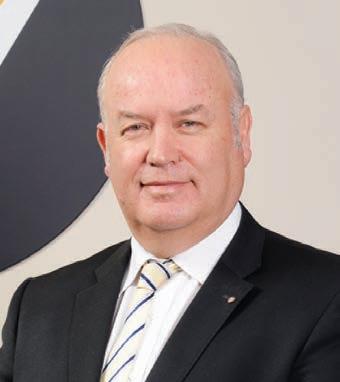
Climate change stands as an undeniable challenge of our time, echoing through the melting ice caps, rising sea levels, and the ominous shadow of greenhouse gas emissions. Governments worldwide are grappling with this threat, aiming to reconcile economic imperatives with environmental stewardship.
In Australia, this imperative is no less urgent, with every industry tasked with transitioning towards sustainable practices. Among these, the freight industry emerges as a pivotal player, confronting a daunting journey towards decarbonisation.
At the heart of this transition lies a fundamental conundrum: how to balance environmental responsibility with economic viability. Diesel, long the lifeblood of freight transportation, now symbolises an outdated era, fraught with carbon emissions and environmental harm. Yet, the transition to alternative fuels presents profound challenges – and opportunity – for the freight industry. Price looms large on the horizon, casting a shadow over any transition efforts. While the allure of green energy is undeniable, its adoption comes at a premium. Renewable fuels often come with a higher price tag, threatening the delicate balance sheets of freight operators already operating on razor-thin margins. Without affordable alternatives, the path towards decarbonisation appears steep and treacherous.
Moreover, the infrastructure required to support alternative fuels remains a work in progress. The logistics of refuelling stations and distribution networks pose formidable hurdles, further complicating the transition process. For many in the freight industry, the prospect of investing in unproven infrastructure adds another layer of uncertainty to an already complex equation.
Equipment represents yet another barrier to decarbonisation. Retro tting existing eets or investing in new, ecofriendly vehicles requires signi cant capital outlay, stretching the nancial constraints of many operators. In the absence of robust incentives or support mechanisms, the transition to greener technologies remains a distant dream for most.
In this landscape of challenges, the role of incentives versus penalties becomes paramount. Governments must strike a delicate balance, offering carrots rather than sticks to encourage adoption. Subsidies, tax incentives, and grants can provide much-needed breathing room for freight operators, incentivising investment in sustainable practices. Yet, time is of the essence. While the need for decarbonisation is urgent, the transition cannot happen overnight. Freight operators require suf cient lead time to adapt, lest they risk economic ruin in the pursuit of environmental salvation. A phased approach, coupled with realistic timelines, offers a pragmatic way forward, allowing for gradual adaptation without undue strain.

Customers and consumers must also factor into the equation. Customers of freight are more often than not driving for change, prompted by ESG targets, yet they must also factor this into supply chain impacts and cost, with consumers ultimately paying higher prices for decarbonised freight transport. Amid these challenges, however, lie immense opportunities. The transition towards decarbonisation presents a chance for innovation and growth within the freight industry. Manufacturers are poised to capitalise on this shift, developing cutting-edge technologies and solutions to meet the evolving needs of the market.
Furthermore, the bene ts of decarbonisation extend far beyond mere environmental stewardship. A greener freight industry promises cleaner air, reduced pollution, and improved public health outcomes. By embracing this transition, Australia has an opportunity to lead by example, demonstrating its commitment to a sustainable future.
Decarbonising Australia’s freight industry is not merely a lofty aspiration but an imperative for our collective survival. While the challenges may seem daunting, they are not insurmountable. With strategic planning, robust incentives, and a shared commitment to change, we can pave the way towards a greener, more sustainable future for generations to come.
Peter Anderson CEO, VTAIf you’re ready to get serious about tackling bigger jobs, grab yourself an NLR 45-150 AMT SWB Traypack from the Ready-to-Work range for $62,990† drive away. And to prove we aren’t playing, buy any NLR Traypack before June 30 and you’ll get $3,500* to spend on genuine accessories or a service agreement. So, now’s the time to trade up from your ute. Head to isuzu.com.au or visit your nearest Isuzu Truck Dealer now.



























